Install Steam
login
|
language
简体中文 (Simplified Chinese)
繁體中文 (Traditional Chinese)
日本語 (Japanese)
한국어 (Korean)
ไทย (Thai)
Български (Bulgarian)
Čeština (Czech)
Dansk (Danish)
Deutsch (German)
Español - España (Spanish - Spain)
Español - Latinoamérica (Spanish - Latin America)
Ελληνικά (Greek)
Français (French)
Italiano (Italian)
Bahasa Indonesia (Indonesian)
Magyar (Hungarian)
Nederlands (Dutch)
Norsk (Norwegian)
Polski (Polish)
Português (Portuguese - Portugal)
Português - Brasil (Portuguese - Brazil)
Română (Romanian)
Русский (Russian)
Suomi (Finnish)
Svenska (Swedish)
Türkçe (Turkish)
Tiếng Việt (Vietnamese)
Українська (Ukrainian)
Report a translation problem



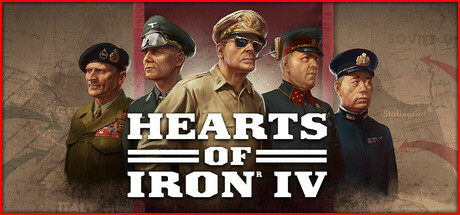
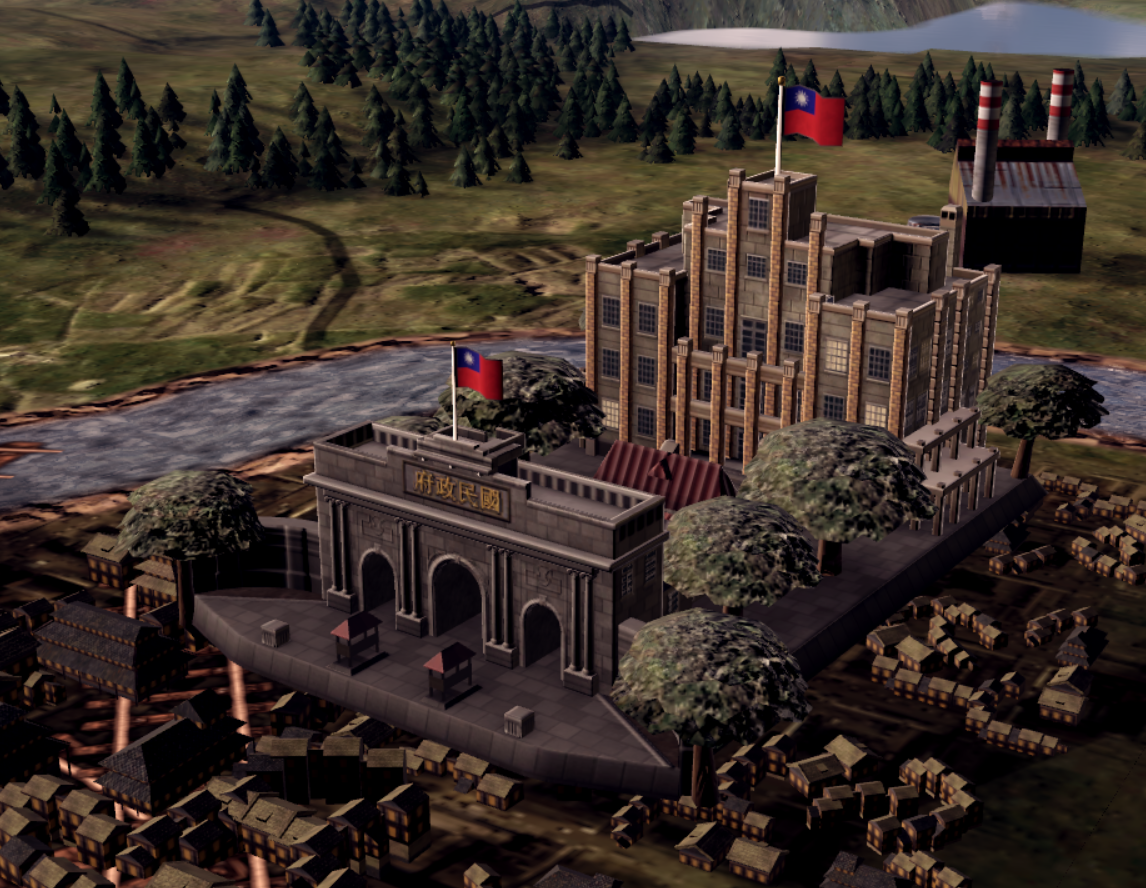 Hey folks, ImaginedPanda here! I’m one of the designers working on Nationalist China and will be taking you through a quick tour of the new content coming in No Compromise, No Surrender. If you don’t recognize the name it is because this is my first time writing a Dev Diary and if you do recognize the name it’s because I’ve been answering when you’ve reported bugs on the forums. Keep doing that, you guys are awesome! Enough of that though onto Nationalist China!
Hey folks, ImaginedPanda here! I’m one of the designers working on Nationalist China and will be taking you through a quick tour of the new content coming in No Compromise, No Surrender. If you don’t recognize the name it is because this is my first time writing a Dev Diary and if you do recognize the name it’s because I’ve been answering when you’ve reported bugs on the forums. Keep doing that, you guys are awesome! Enough of that though onto Nationalist China!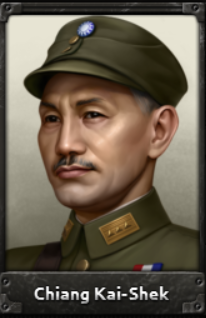
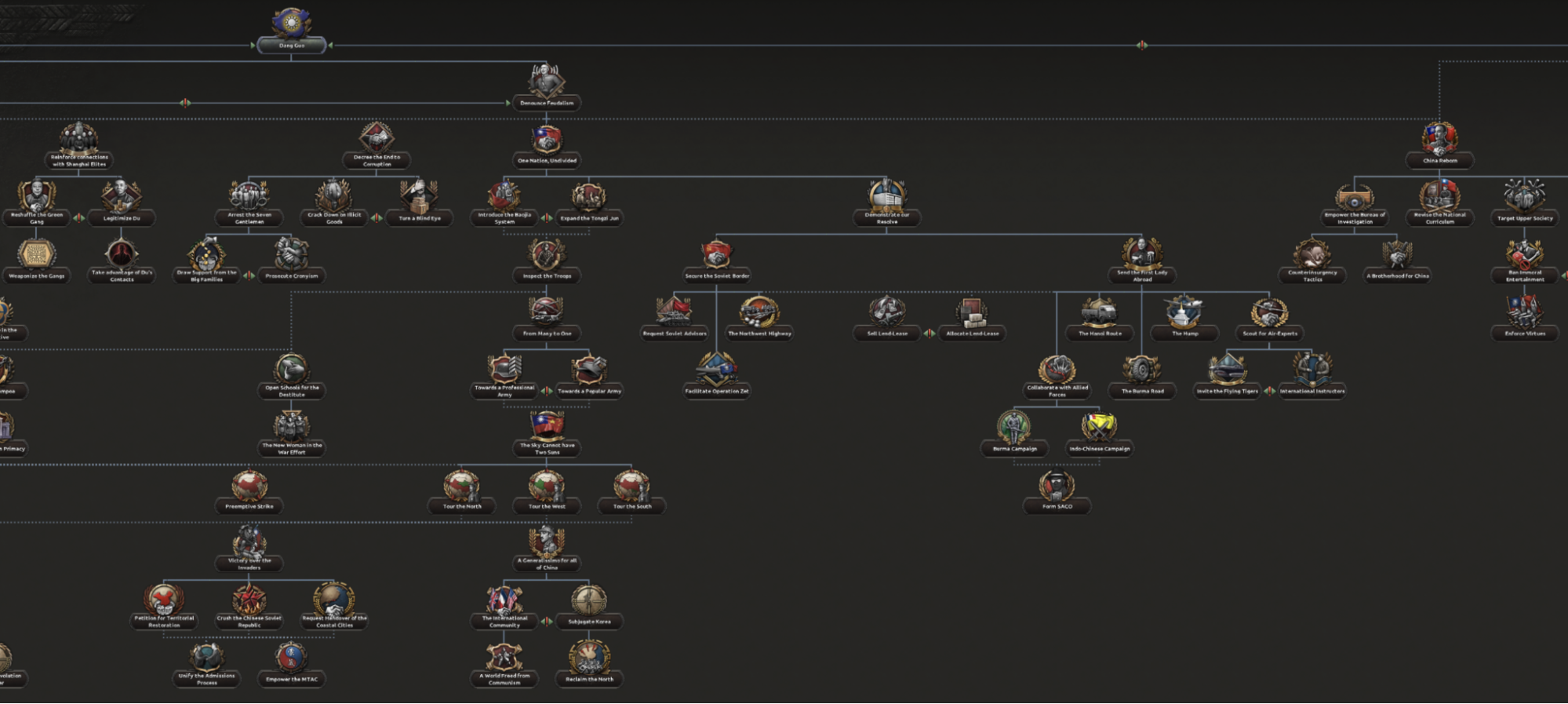 We’ll start off talking about Chiang Kai-shek: a military leader through and through, Chiang asserted his power and assured loyalty through the army and the Whampoa Military Academy. What this means is that playing as Chiang Kai-shek you will focus heavily on using the new faction system where you will use your influence to force the different warlords into becoming your subjects.
We’ll start off talking about Chiang Kai-shek: a military leader through and through, Chiang asserted his power and assured loyalty through the army and the Whampoa Military Academy. What this means is that playing as Chiang Kai-shek you will focus heavily on using the new faction system where you will use your influence to force the different warlords into becoming your subjects.
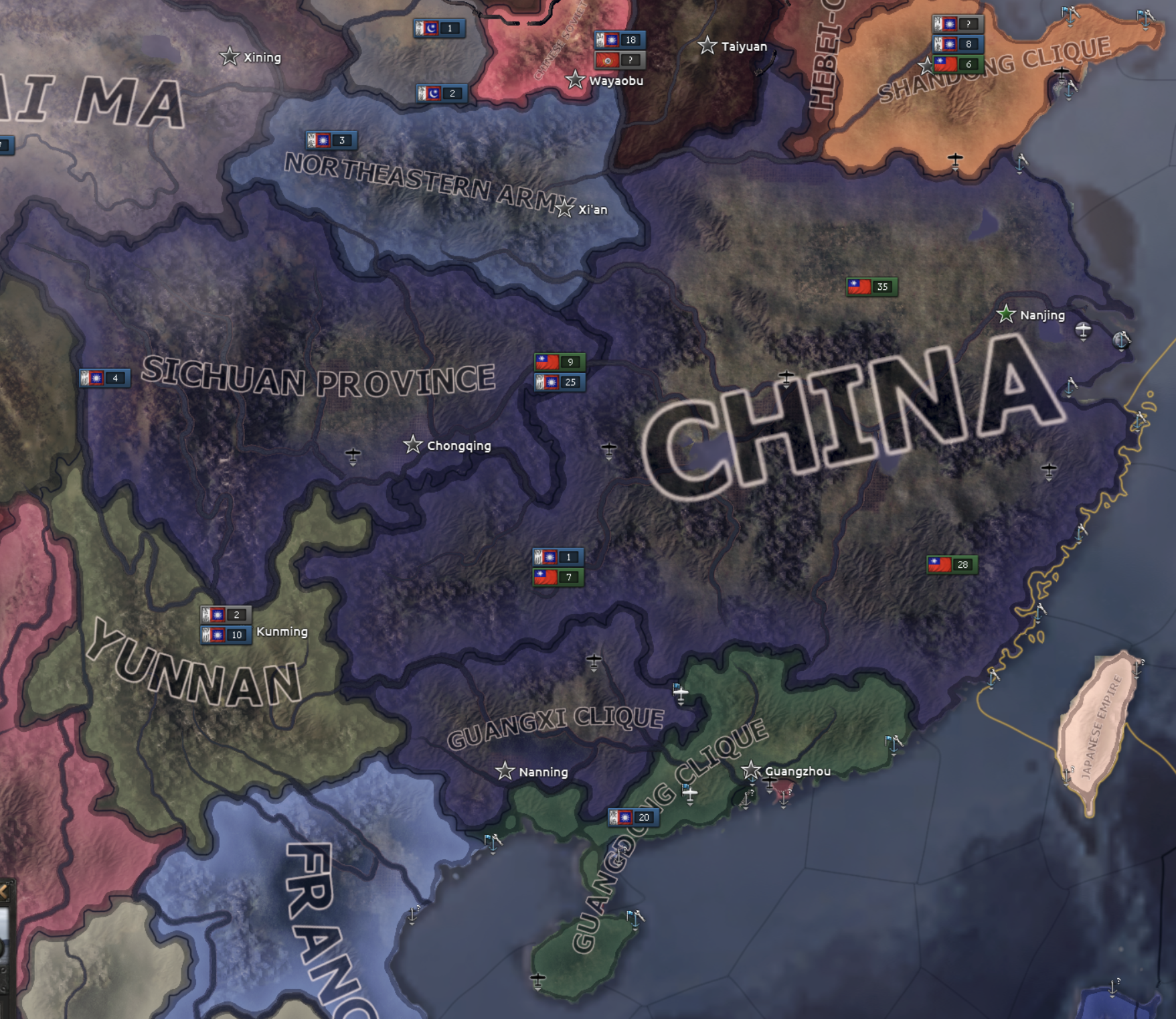 The stronger a military leader you are the more you will be able to integrate.
The stronger a military leader you are the more you will be able to integrate.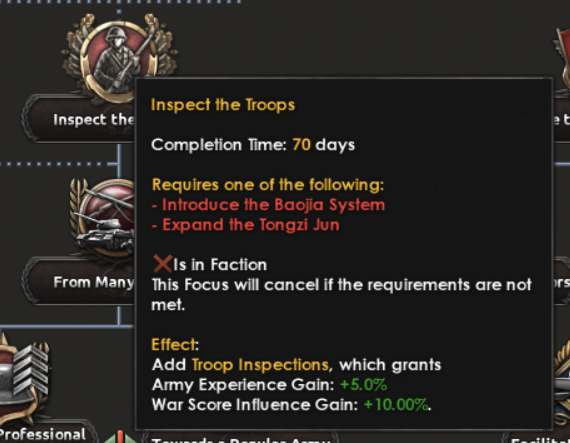 As China was a big recipient of lend-lease so we also wanted to give you gameplay around this and have added a mini-branch for this where you will be able to build up both your economy and arsenal.
As China was a big recipient of lend-lease so we also wanted to give you gameplay around this and have added a mini-branch for this where you will be able to build up both your economy and arsenal.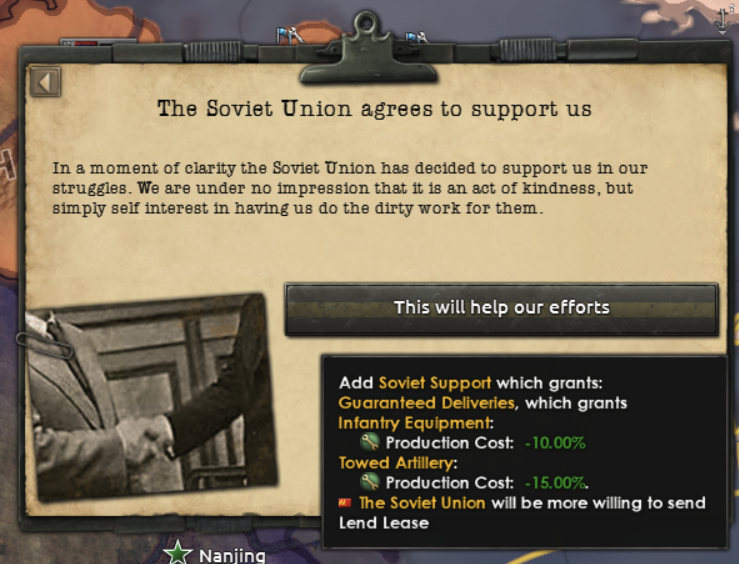
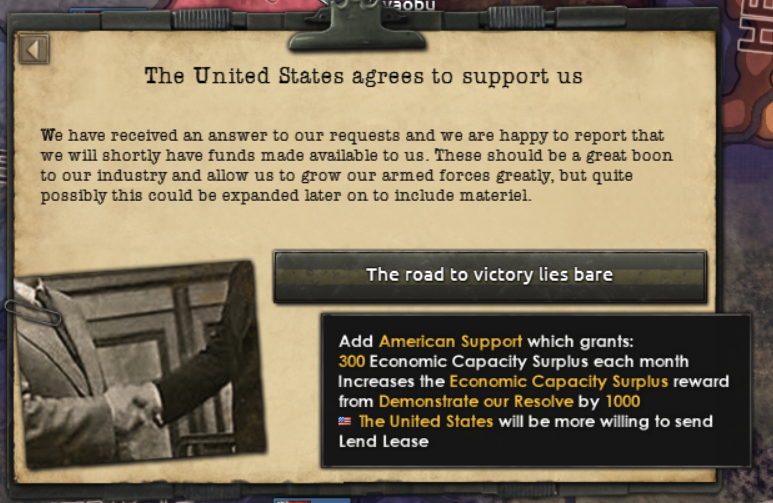
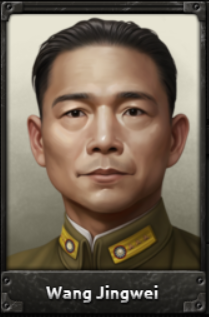 Wang Jingwei can be described as Chiang Kai Shek's greatest adversary within the KMT of the period.
Wang Jingwei can be described as Chiang Kai Shek's greatest adversary within the KMT of the period. 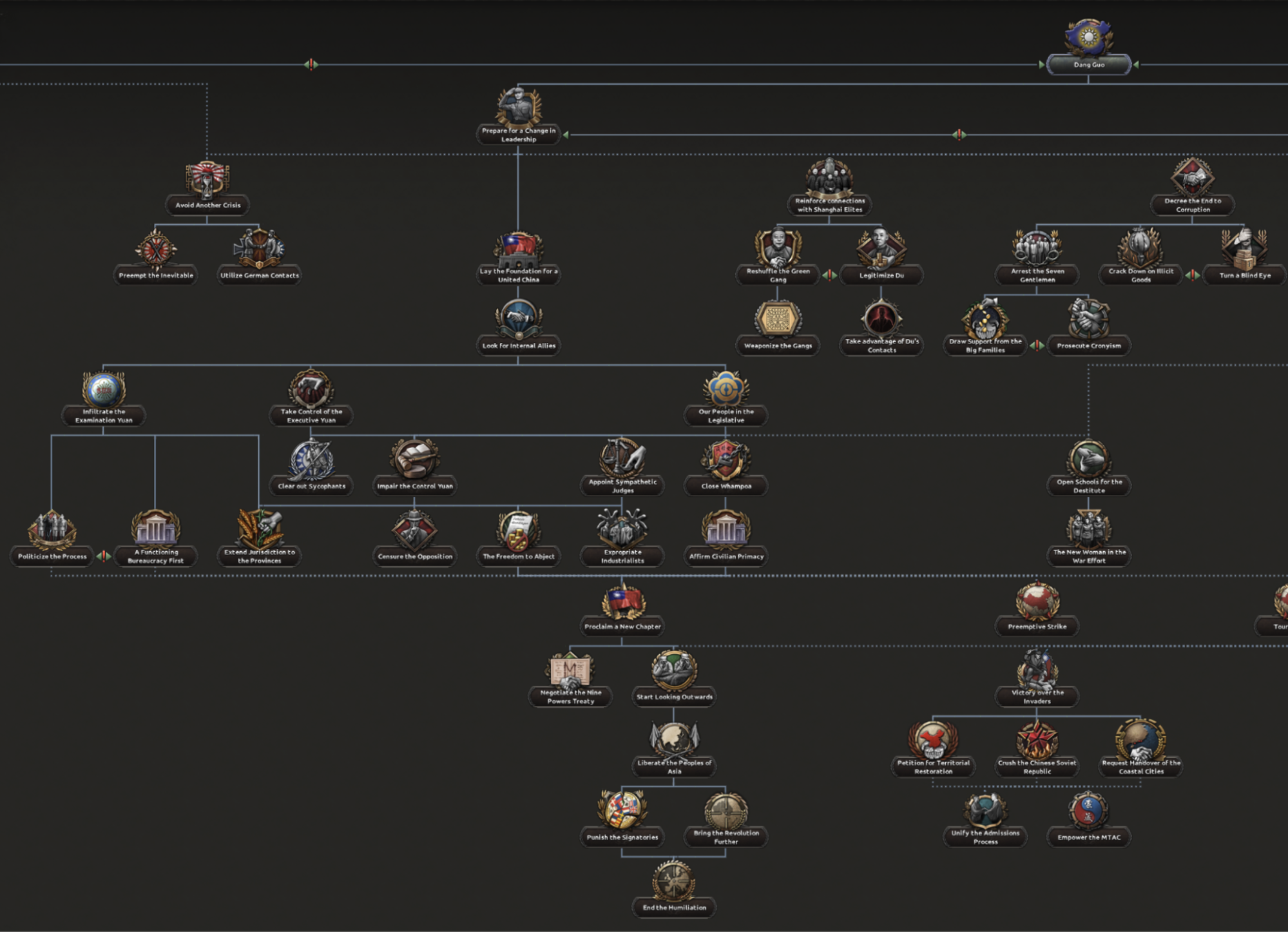 Unlike Chiang, Wang wasn’t militarily trained and more of a politician so we’ve taken to this difference to make this path feel different. In this path you will get rid of Chiang and start solidifying your power through taking over the central government institutions, known as the Yuans.
Unlike Chiang, Wang wasn’t militarily trained and more of a politician so we’ve taken to this difference to make this path feel different. In this path you will get rid of Chiang and start solidifying your power through taking over the central government institutions, known as the Yuans. 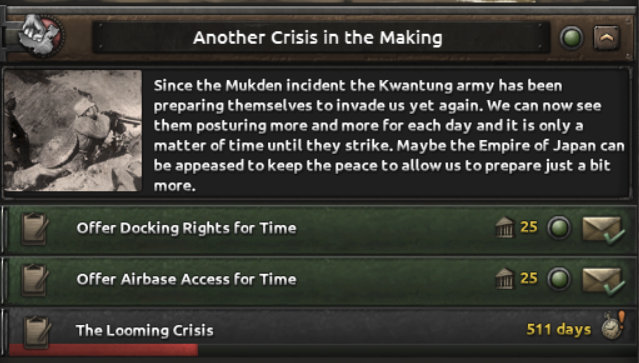
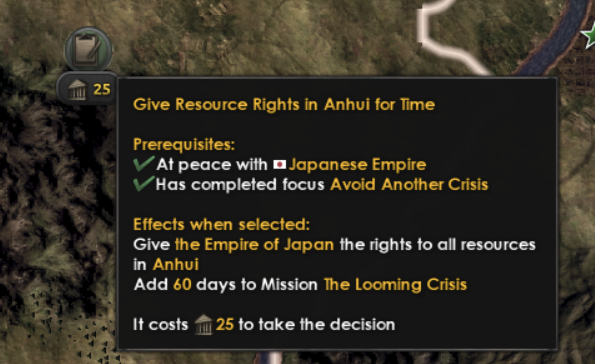 When having thrown out the invaders and unified your country you get to help others to do the same, as well as punish the damn imperialists. Don’t worry though, you will be appropriately rewarded for helping your fellow asians throw off the yoke of colonialism.
When having thrown out the invaders and unified your country you get to help others to do the same, as well as punish the damn imperialists. Don’t worry though, you will be appropriately rewarded for helping your fellow asians throw off the yoke of colonialism.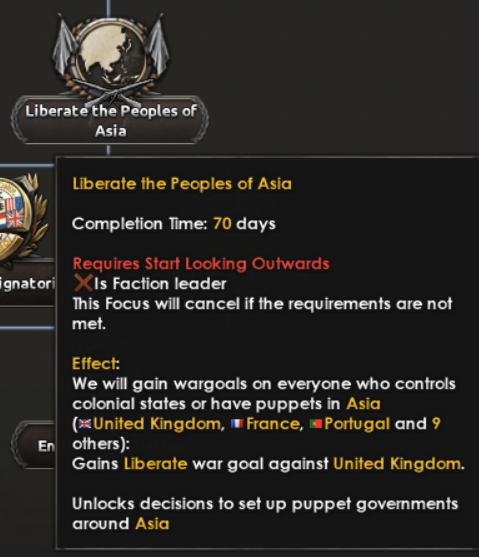
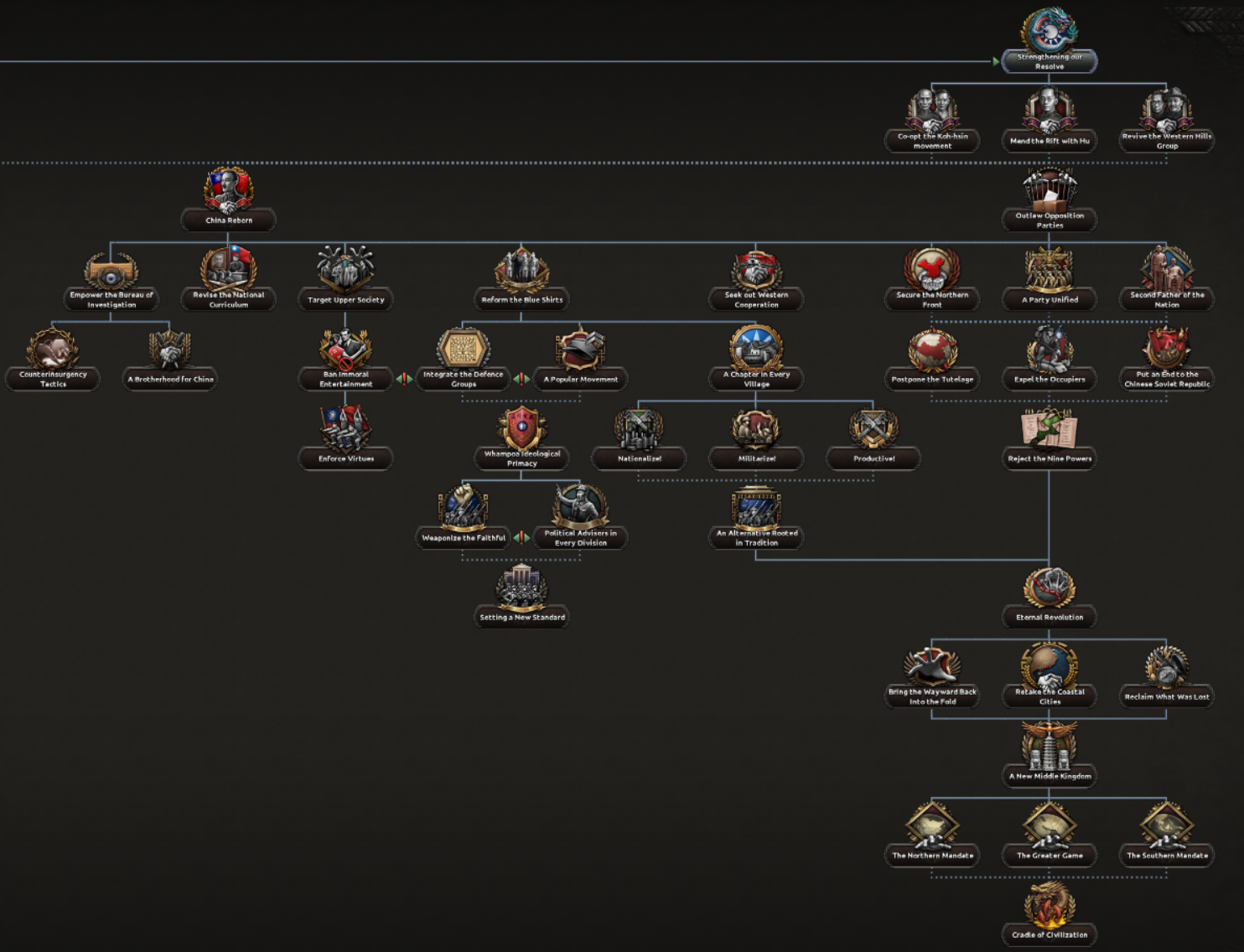 Something that should have become clear at this point is that armed conflict will come to you earlier than you might have preferred. This might feel somewhat overwhelming for some players, but then you have the kind of player that prefers when every border is a frontline. At least you know what kind of relation you have with them then.
Something that should have become clear at this point is that armed conflict will come to you earlier than you might have preferred. This might feel somewhat overwhelming for some players, but then you have the kind of player that prefers when every border is a frontline. At least you know what kind of relation you have with them then. 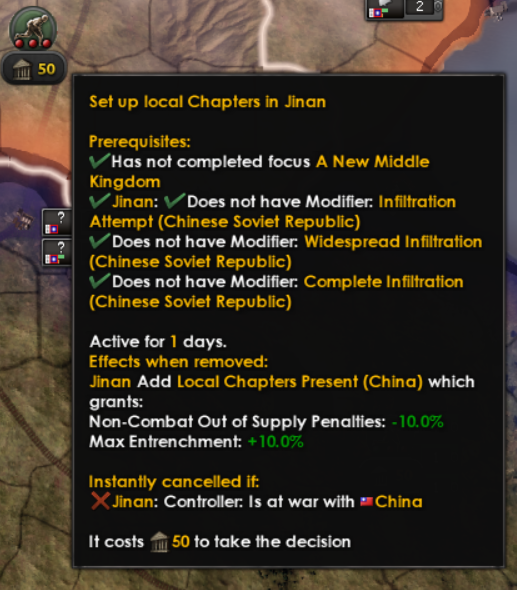 When you’ve brought the revolution of Dr Sun Yat-sen to all of China you will strike outwards, taking control over areas in your vicinity and building a continental empire. By successfully conquering claimed areas you will be rewarded with more efficient resource extraction and, more importantly, the ability to integrate the states into your glorious empire. Proving yet again that the world revolves around you.
When you’ve brought the revolution of Dr Sun Yat-sen to all of China you will strike outwards, taking control over areas in your vicinity and building a continental empire. By successfully conquering claimed areas you will be rewarded with more efficient resource extraction and, more importantly, the ability to integrate the states into your glorious empire. Proving yet again that the world revolves around you.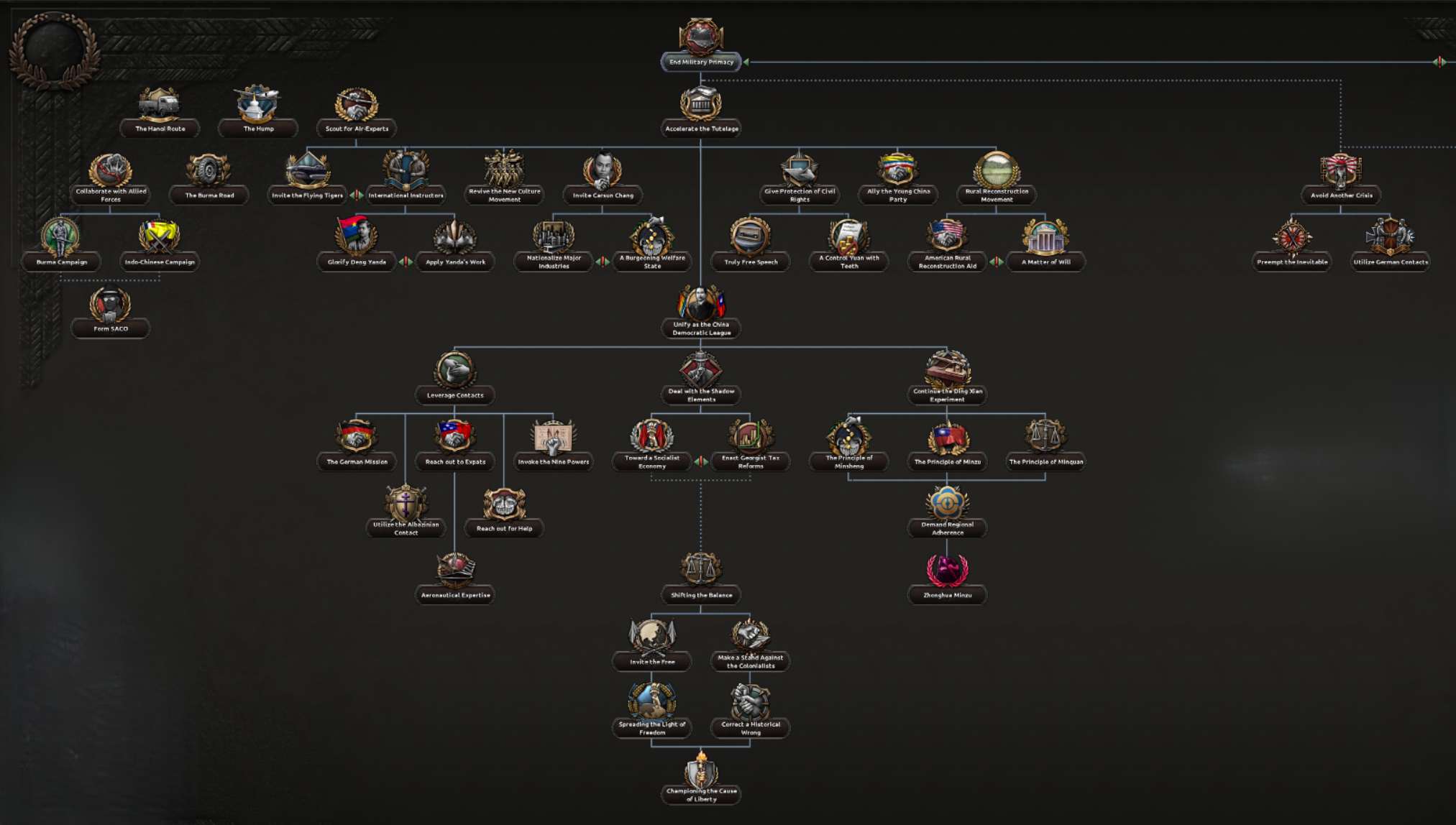 During the time period there were several smaller groups during the time that challenged the KMT, and some of them unified into what came to be known as the China Democratic League, which became the largest opposition apart from the CCP.
During the time period there were several smaller groups during the time that challenged the KMT, and some of them unified into what came to be known as the China Democratic League, which became the largest opposition apart from the CCP. 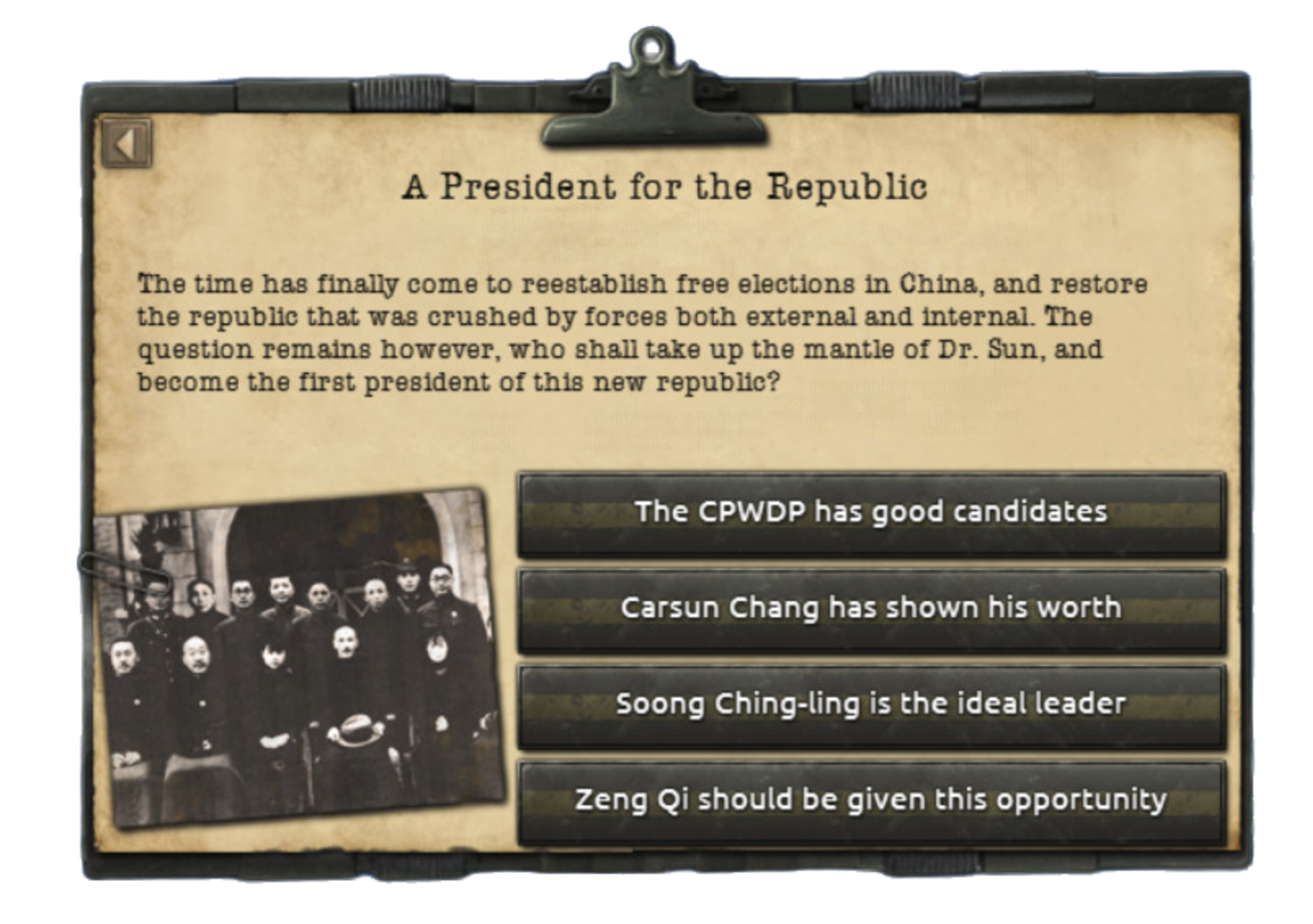 But just uniting small ideological groups does not make a movement and you still need the backing of the populace. To get them on your side you will be applying the teaching of Dr Sun guiding them towards a better future.
But just uniting small ideological groups does not make a movement and you still need the backing of the populace. To get them on your side you will be applying the teaching of Dr Sun guiding them towards a better future.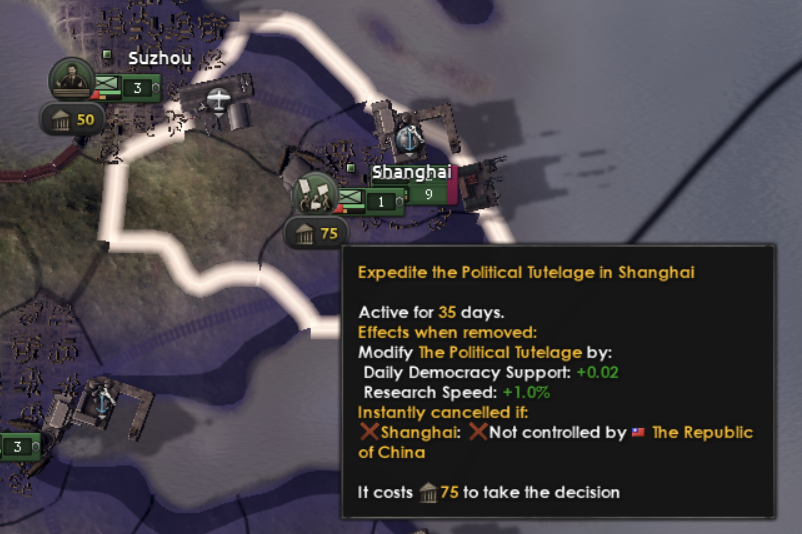 So that is how you make your country turn Democratic, but that wouldn’t be worth a lot if you can’t keep your sovereignty. As you might have guessed the Japanese invasion won’t be stopped simply because you have another party in power so you will have to deal with them.
So that is how you make your country turn Democratic, but that wouldn’t be worth a lot if you can’t keep your sovereignty. As you might have guessed the Japanese invasion won’t be stopped simply because you have another party in power so you will have to deal with them.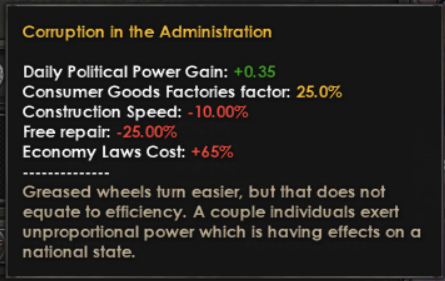
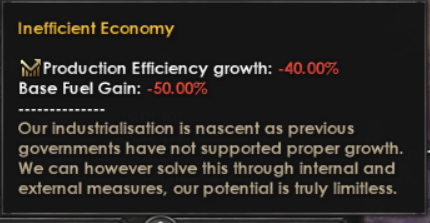
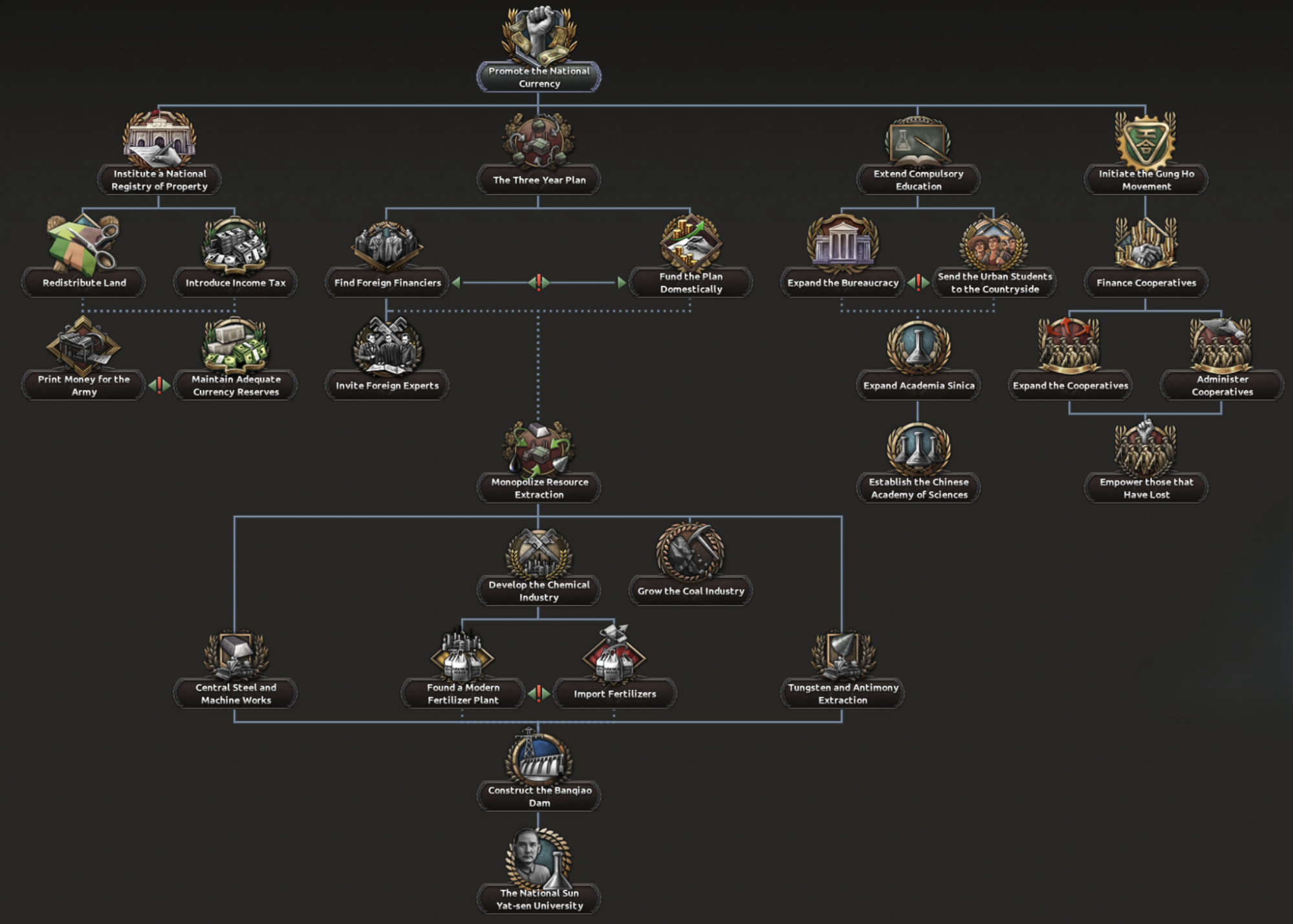 Chinese industry in the period had a large part that was foreign financed so we wanted to give you the option to do the same. If you have played your cards right you will be able to get large amounts of support from foreign sources.
Chinese industry in the period had a large part that was foreign financed so we wanted to give you the option to do the same. If you have played your cards right you will be able to get large amounts of support from foreign sources. 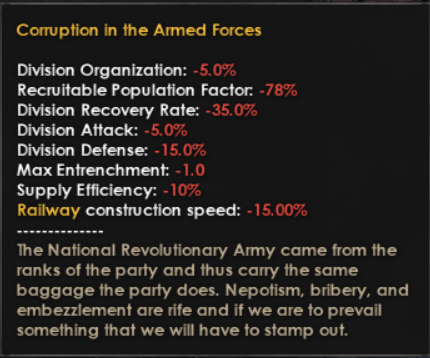 The National Revolutionary army of the 1930s was not the most well trained, nor equipped, but in the 20s it became self-evident to many in the military that a confrontation with the Japanese was inevitable. Two strategies to solve this inevitability emerged, Protracted Warfare and Decisive Battles.
The National Revolutionary army of the 1930s was not the most well trained, nor equipped, but in the 20s it became self-evident to many in the military that a confrontation with the Japanese was inevitable. Two strategies to solve this inevitability emerged, Protracted Warfare and Decisive Battles. 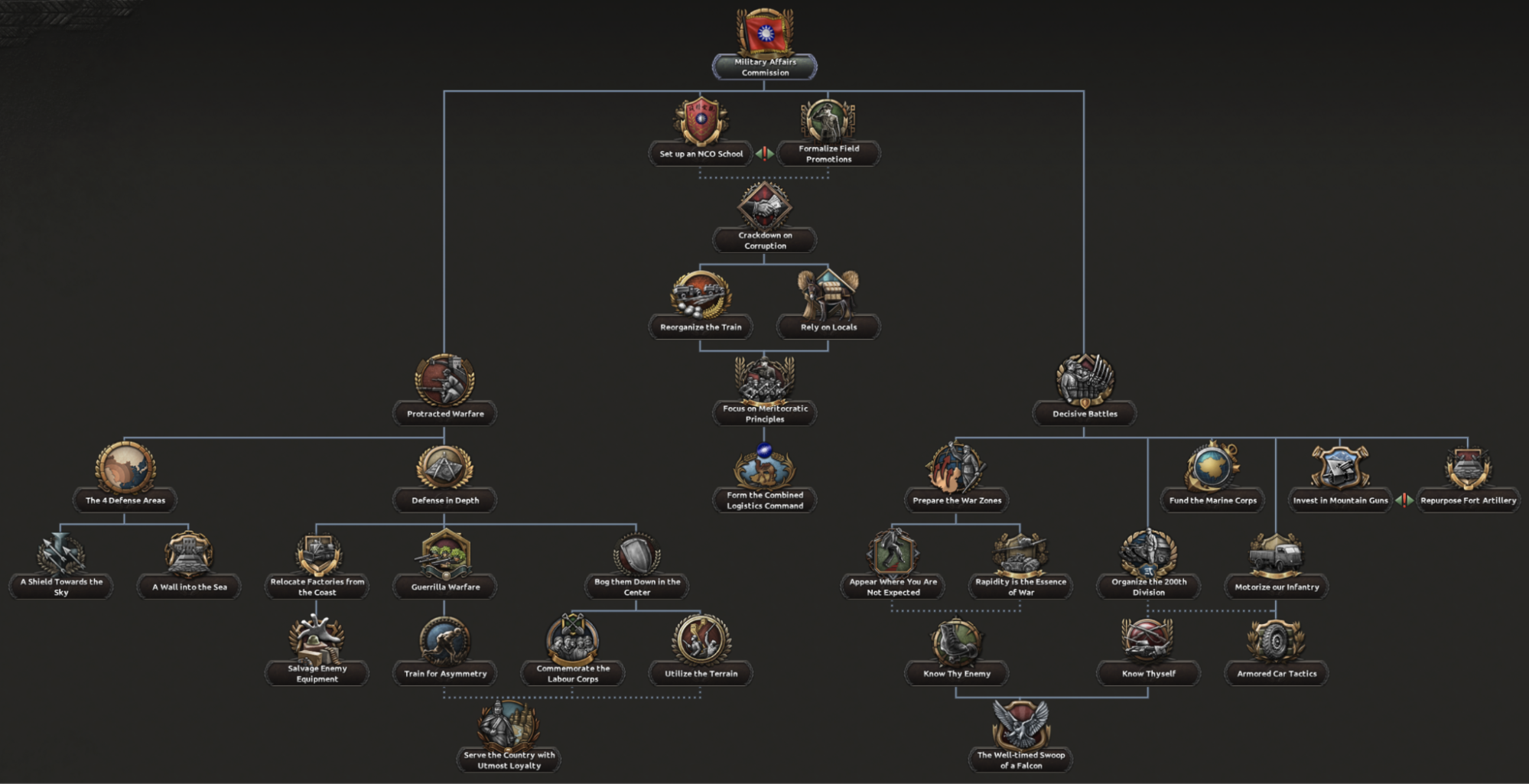 The former was based on the perception that the Japanese had no staying power and the longer the war took, the lower their chance of winning. This path gives you solid bonuses to your defence and the possibility to burn the enemy's supply lines from the rear. You will also be able to focus your defensive efforts in specific states to pin the enemy down where it is the most beneficial to you
The former was based on the perception that the Japanese had no staying power and the longer the war took, the lower their chance of winning. This path gives you solid bonuses to your defence and the possibility to burn the enemy's supply lines from the rear. You will also be able to focus your defensive efforts in specific states to pin the enemy down where it is the most beneficial to you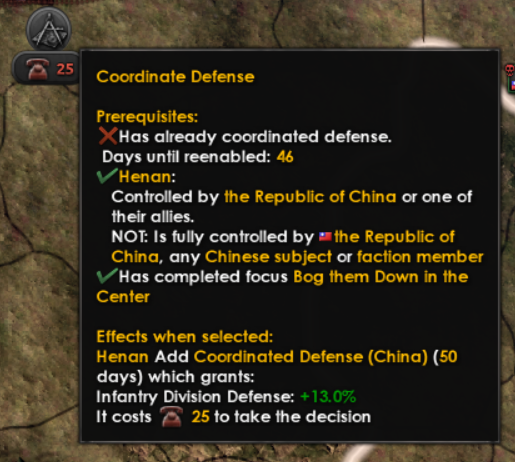 Ironically, the concept of Decisive Battles was influenced by the Japanese themselves in 1905 against the Russian empire. The idea was formed that if you win key engagements you break the will of the enemy so quick and fast strikes wins the war. Here your ability to strike back at the enemy and preempt their attacks takes centre state from the more careful approach. Similarly here you will be able to target specific states with your offensive capabilities proving once and for all that you only have to break them once if you do it well.
Ironically, the concept of Decisive Battles was influenced by the Japanese themselves in 1905 against the Russian empire. The idea was formed that if you win key engagements you break the will of the enemy so quick and fast strikes wins the war. Here your ability to strike back at the enemy and preempt their attacks takes centre state from the more careful approach. Similarly here you will be able to target specific states with your offensive capabilities proving once and for all that you only have to break them once if you do it well.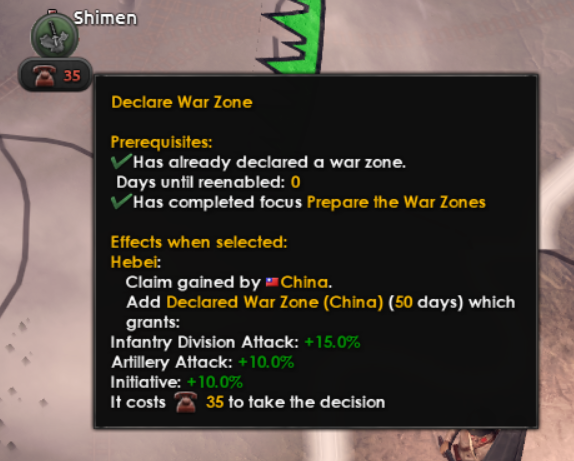 As you can see we have chosen to represent these ideas in two different branches, but unlike how we’ve done in army branches in the past, going down one won’t lock you into that choice for the rest of your playthrough. When choosing one path you only lock yourself into that branch temporarily until you’ve taken the last focus in the branch. This means that if you are not ready for beating the invaders you can go down the more defensive branch slowing them down, and when you feel ready to strike back you start taking offensive focuses.
As you can see we have chosen to represent these ideas in two different branches, but unlike how we’ve done in army branches in the past, going down one won’t lock you into that choice for the rest of your playthrough. When choosing one path you only lock yourself into that branch temporarily until you’ve taken the last focus in the branch. This means that if you are not ready for beating the invaders you can go down the more defensive branch slowing them down, and when you feel ready to strike back you start taking offensive focuses.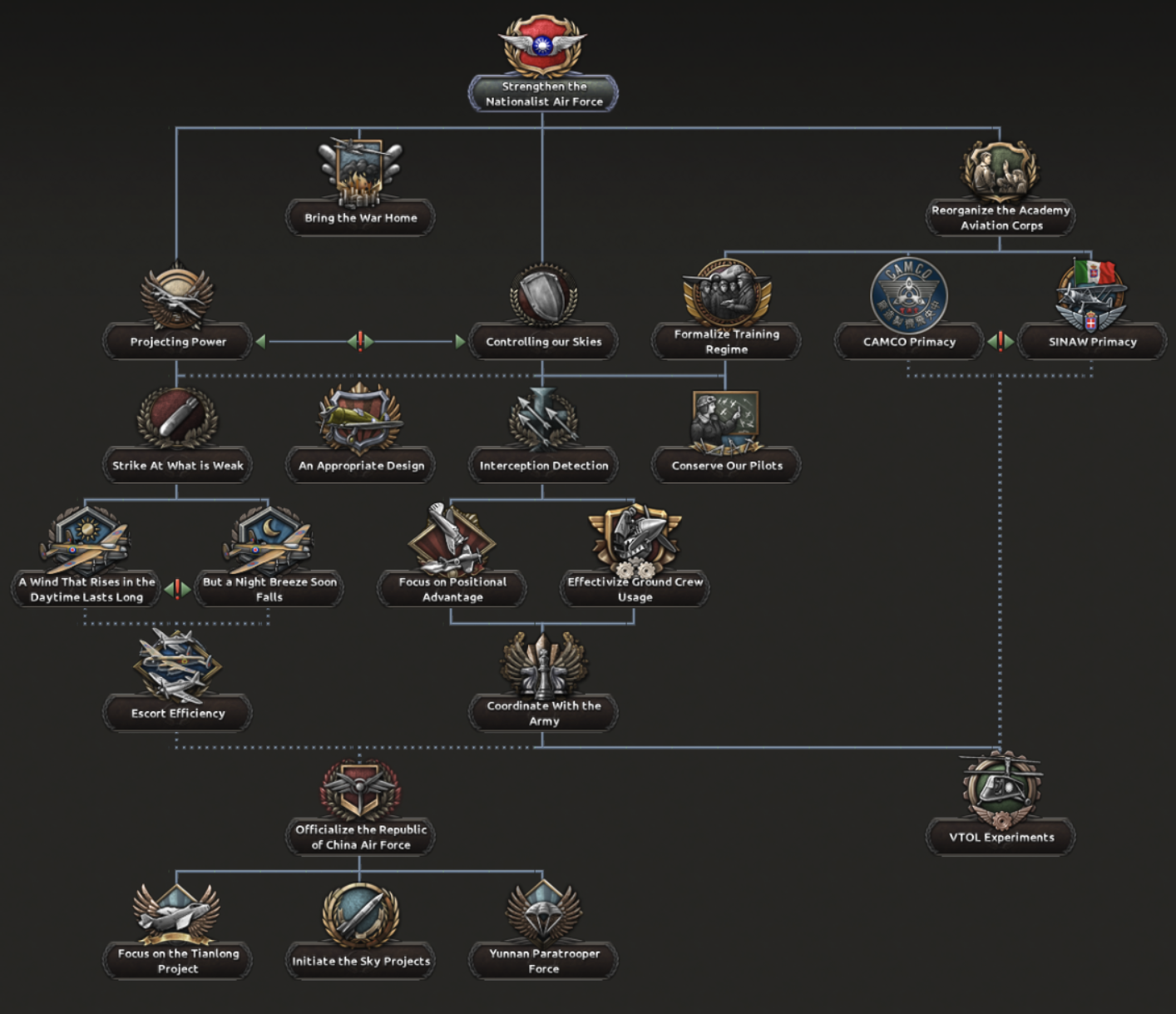 The main choice is if your airforce is going to be shaped into an offensive tool to project power and strike the enemy abroad, or if controlling your own backyard takes precedence. This ties into the changes we’ve done to doctrines of course.
The main choice is if your airforce is going to be shaped into an offensive tool to project power and strike the enemy abroad, or if controlling your own backyard takes precedence. This ties into the changes we’ve done to doctrines of course.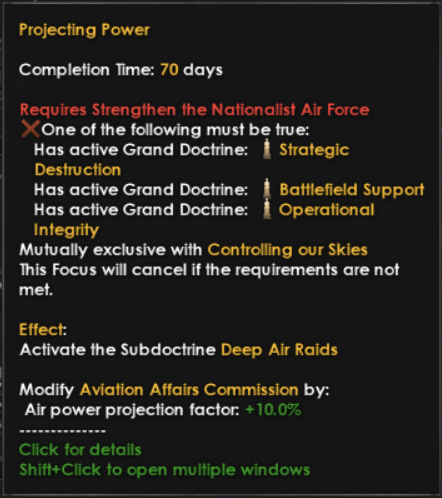
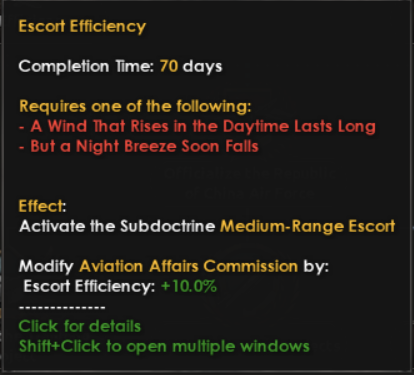 You will of course also have options of which organisation should manufacture your planes either going with the Central Aircraft Manufacturing Company, CAMCO, with their focus on high-powered interceptors, or the Sino-Italian National Aircraft Works, SINAW, specialising in medium sized bomber aircraft.
You will of course also have options of which organisation should manufacture your planes either going with the Central Aircraft Manufacturing Company, CAMCO, with their focus on high-powered interceptors, or the Sino-Italian National Aircraft Works, SINAW, specialising in medium sized bomber aircraft. 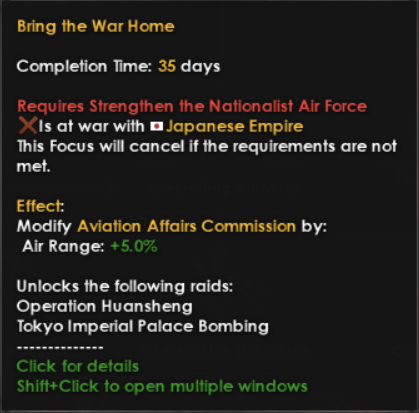
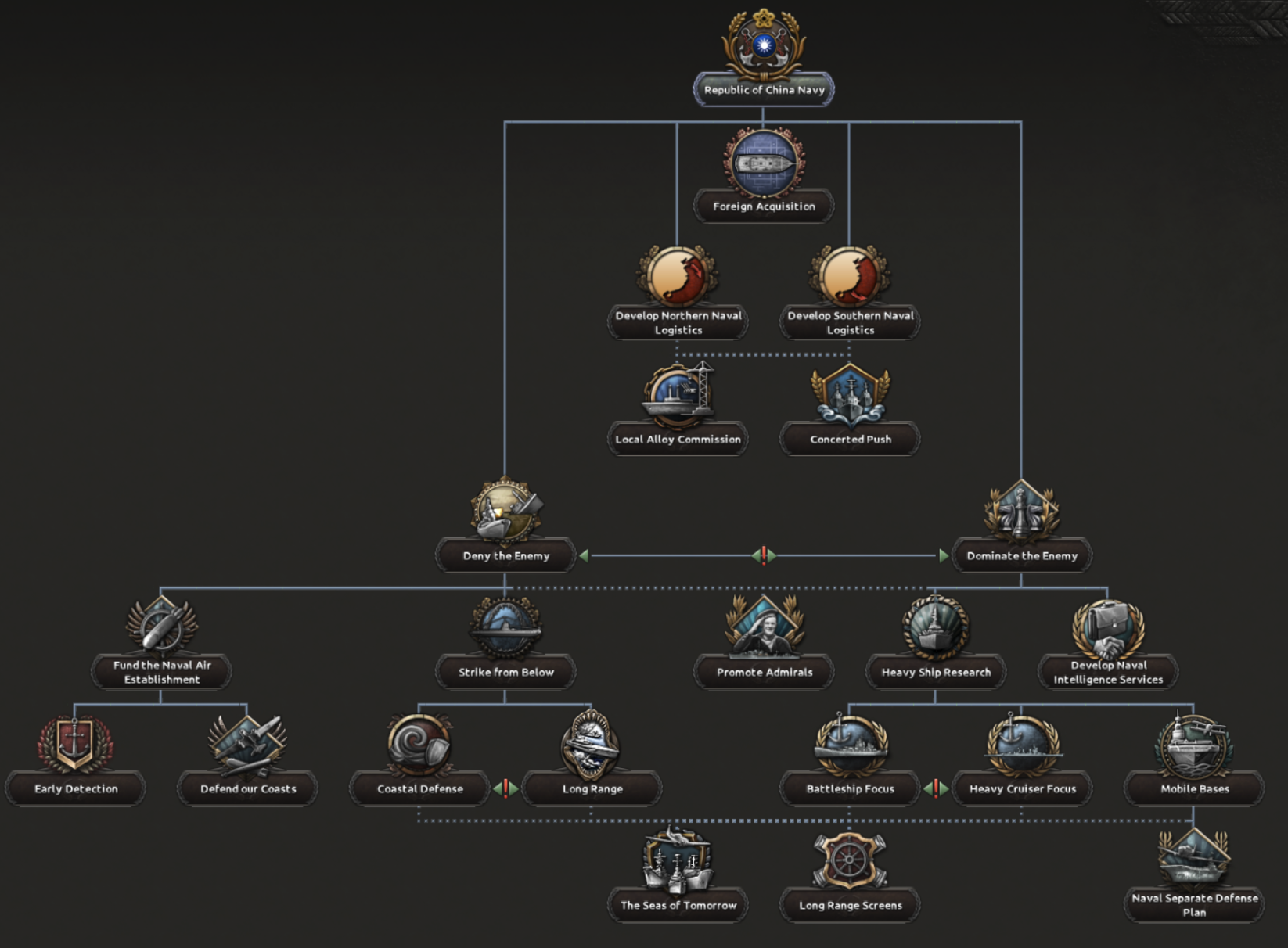 For these reasons we’ve leaned into more what could have been which means that the main option you will have as a player is if you have the need to control the oceans or if your resources would be better spent on denying the enemy the control, because sometimes it’s enough if the enemy doesn’t win.
For these reasons we’ve leaned into more what could have been which means that the main option you will have as a player is if you have the need to control the oceans or if your resources would be better spent on denying the enemy the control, because sometimes it’s enough if the enemy doesn’t win. 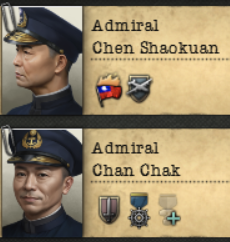 For you who likes overviews, here is the tree in its entirety.
For you who likes overviews, here is the tree in its entirety. I hope I’ve been an adequate guide for this quick introduction to the Nationalist update for No Compromise, No Surrender and I’m looking forward to seeing where you bring the KMT revolution. Now I’ll be handing you off to D3vil to give you an update on the state of the Warlords
I hope I’ve been an adequate guide for this quick introduction to the Nationalist update for No Compromise, No Surrender and I’m looking forward to seeing where you bring the KMT revolution. Now I’ll be handing you off to D3vil to give you an update on the state of the Warlords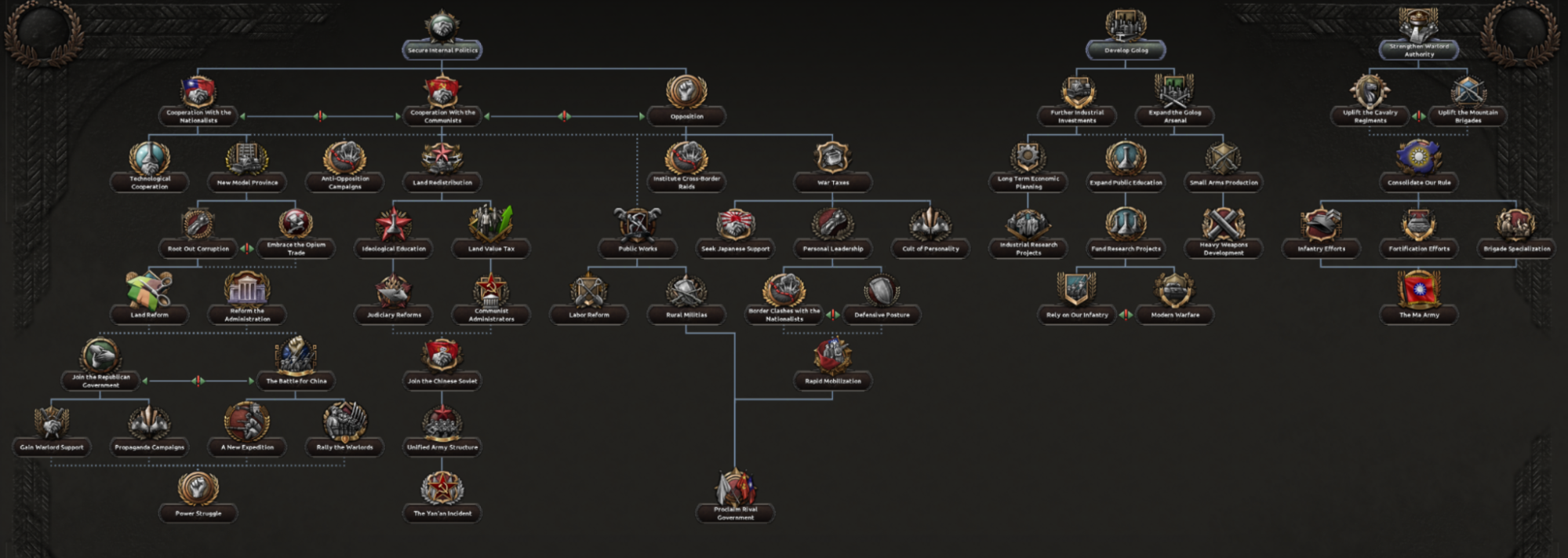 As examples of new sub branches, the Ma Cliques share a subbranch about unifying into one country, while the Sichuan Clique has a subbranch representing the divided administrations and nature of the province at the time, and the Khotan Ma Clique has a subbranch about attempting to unify Sinkiang province under their rule.
As examples of new sub branches, the Ma Cliques share a subbranch about unifying into one country, while the Sichuan Clique has a subbranch representing the divided administrations and nature of the province at the time, and the Khotan Ma Clique has a subbranch about attempting to unify Sinkiang province under their rule. 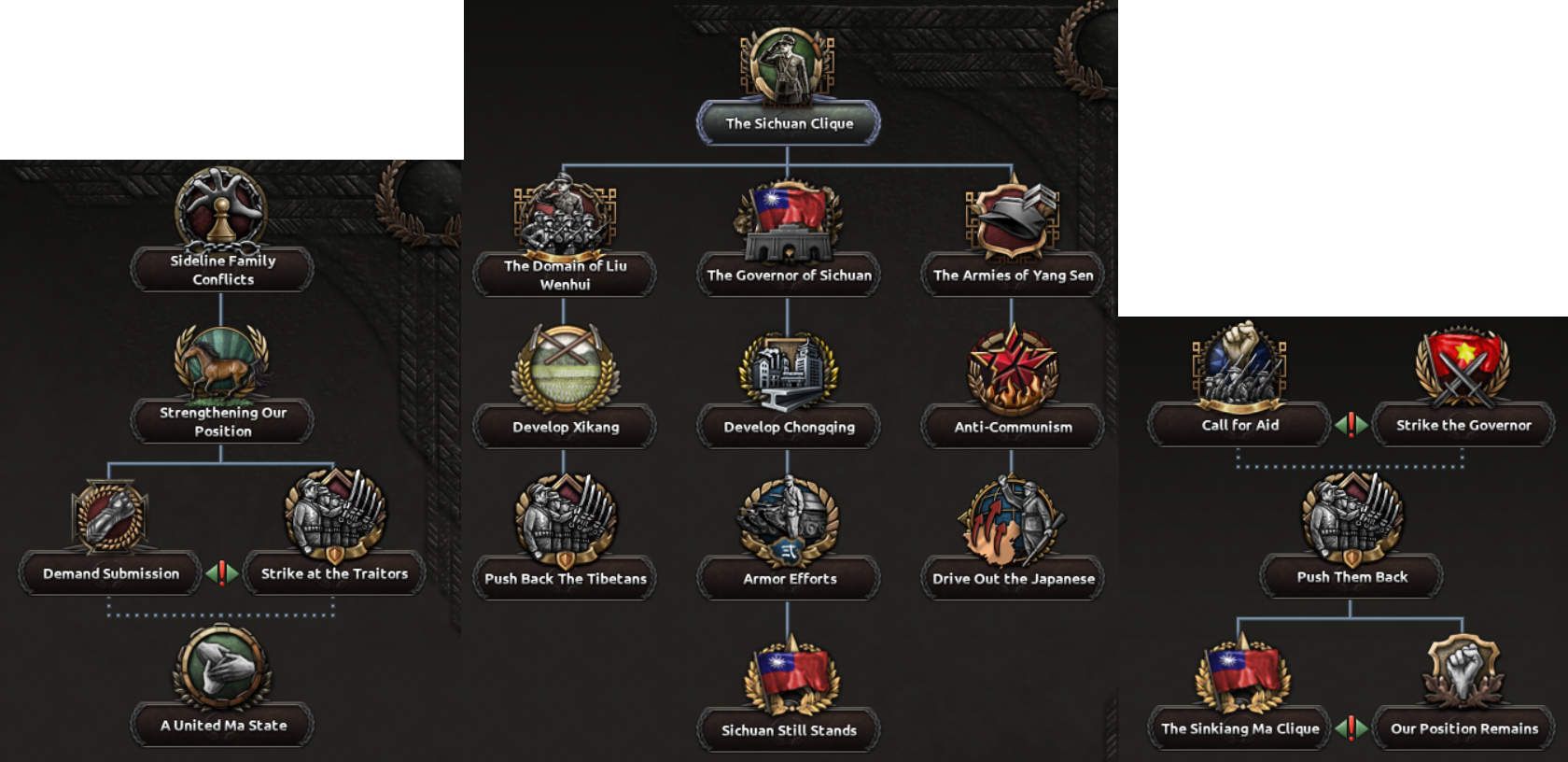 A few of the other warlords have received similar updates.
A few of the other warlords have received similar updates. 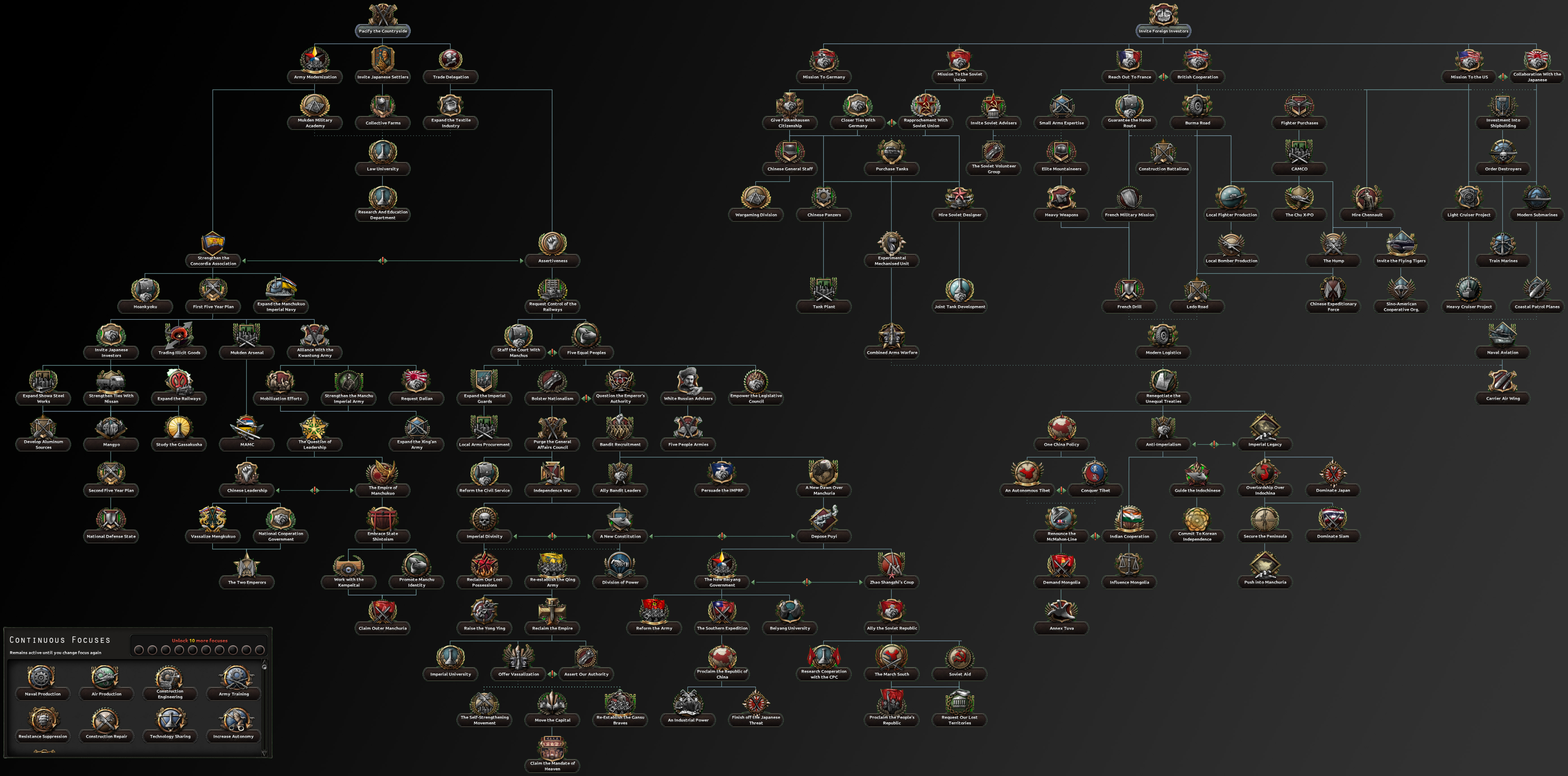 And we added a new Field Marshal and potential country leader for Mongolia :)
And we added a new Field Marshal and potential country leader for Mongolia :) 

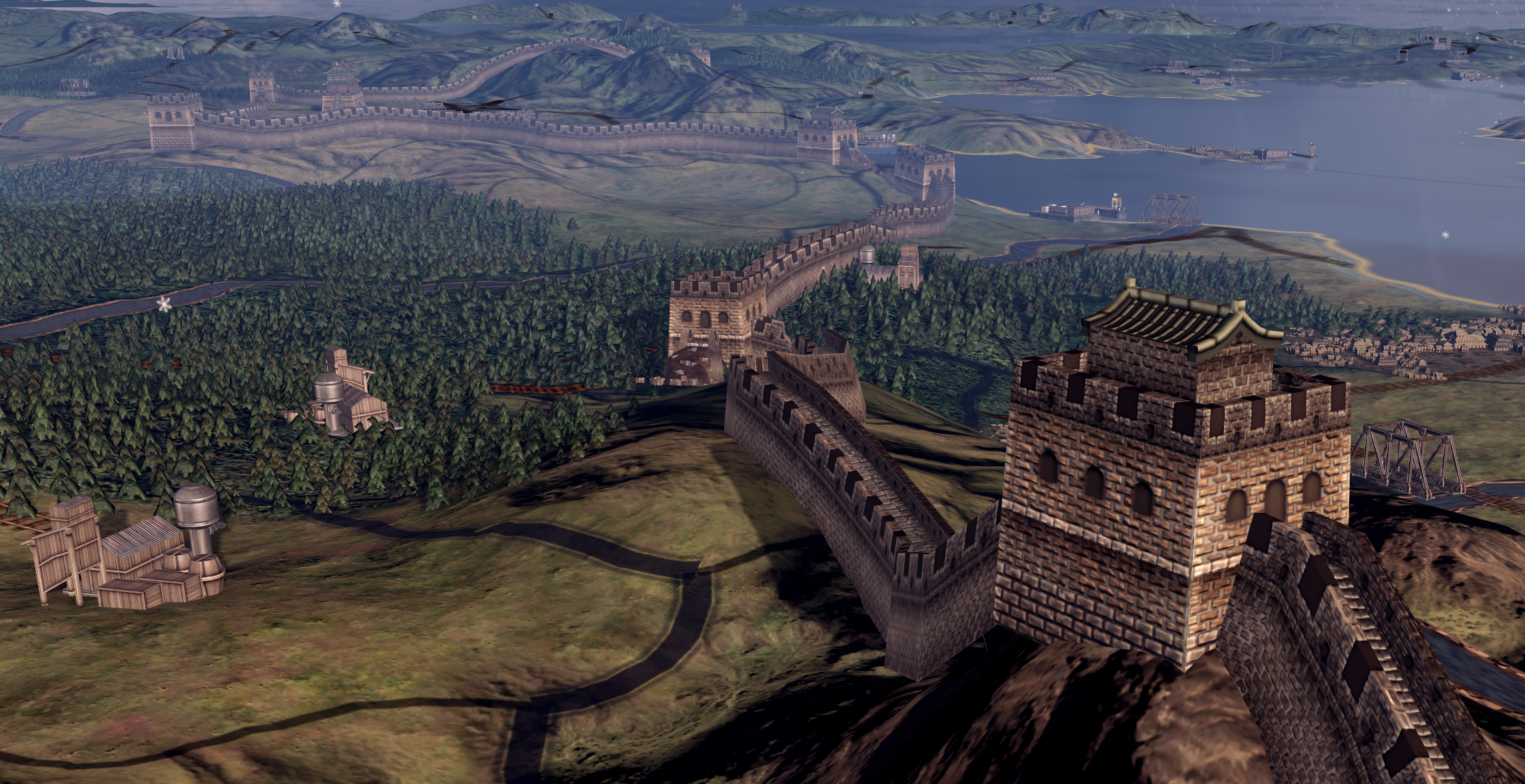 Dàjiā hǎo (Hi everybody!) and welcome to
Dàjiā hǎo (Hi everybody!) and welcome to  On the political side, Zhang Wentian has become the new General Secretary of the Communist Party, after Bo Gu’s strategy led to the near destruction of the Communists at the hands of the KMT. Although Mao Zedong is the de facto leader of the Party, rivals are poised to strike.
On the political side, Zhang Wentian has become the new General Secretary of the Communist Party, after Bo Gu’s strategy led to the near destruction of the Communists at the hands of the KMT. Although Mao Zedong is the de facto leader of the Party, rivals are poised to strike.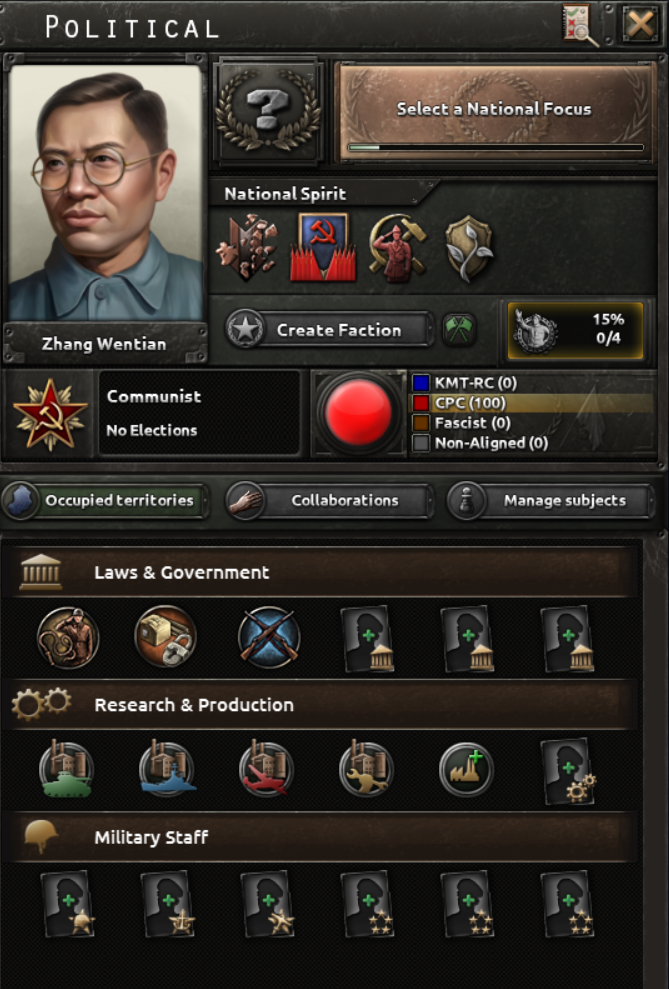 Looking at Communist China’s National Spirits doesn’t really give any reason for optimism either; being forced to embark on the Long March and hunted by the Nationalists really did a number on the Communists:
Looking at Communist China’s National Spirits doesn’t really give any reason for optimism either; being forced to embark on the Long March and hunted by the Nationalists really did a number on the Communists: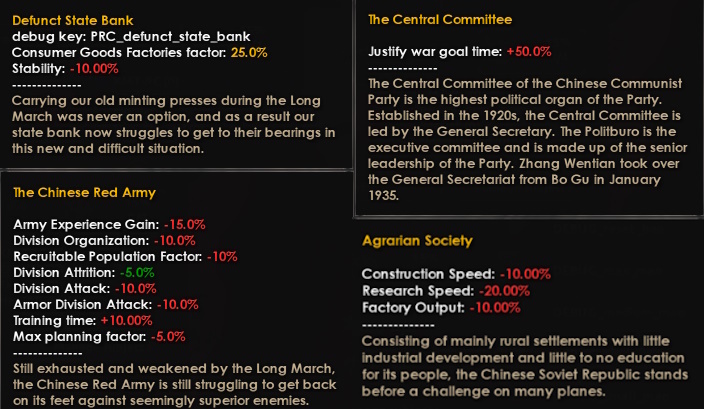 All of this lines up with one of our major design goals for the content; to give the player the feeling of playing the ultimate underdog - down but not yet out. The Communists start in a weak position, with barely any military, industry, or tech. And somehow they still managed to win the Civil War and become a superpower. We wanted to hone in on this feeling of barely having anything to become equal to the other major powers - but before we get to that, let’s take a look at some map changes! Who doesn’t love maps around these parts, am I right?
All of this lines up with one of our major design goals for the content; to give the player the feeling of playing the ultimate underdog - down but not yet out. The Communists start in a weak position, with barely any military, industry, or tech. And somehow they still managed to win the Civil War and become a superpower. We wanted to hone in on this feeling of barely having anything to become equal to the other major powers - but before we get to that, let’s take a look at some map changes! Who doesn’t love maps around these parts, am I right? 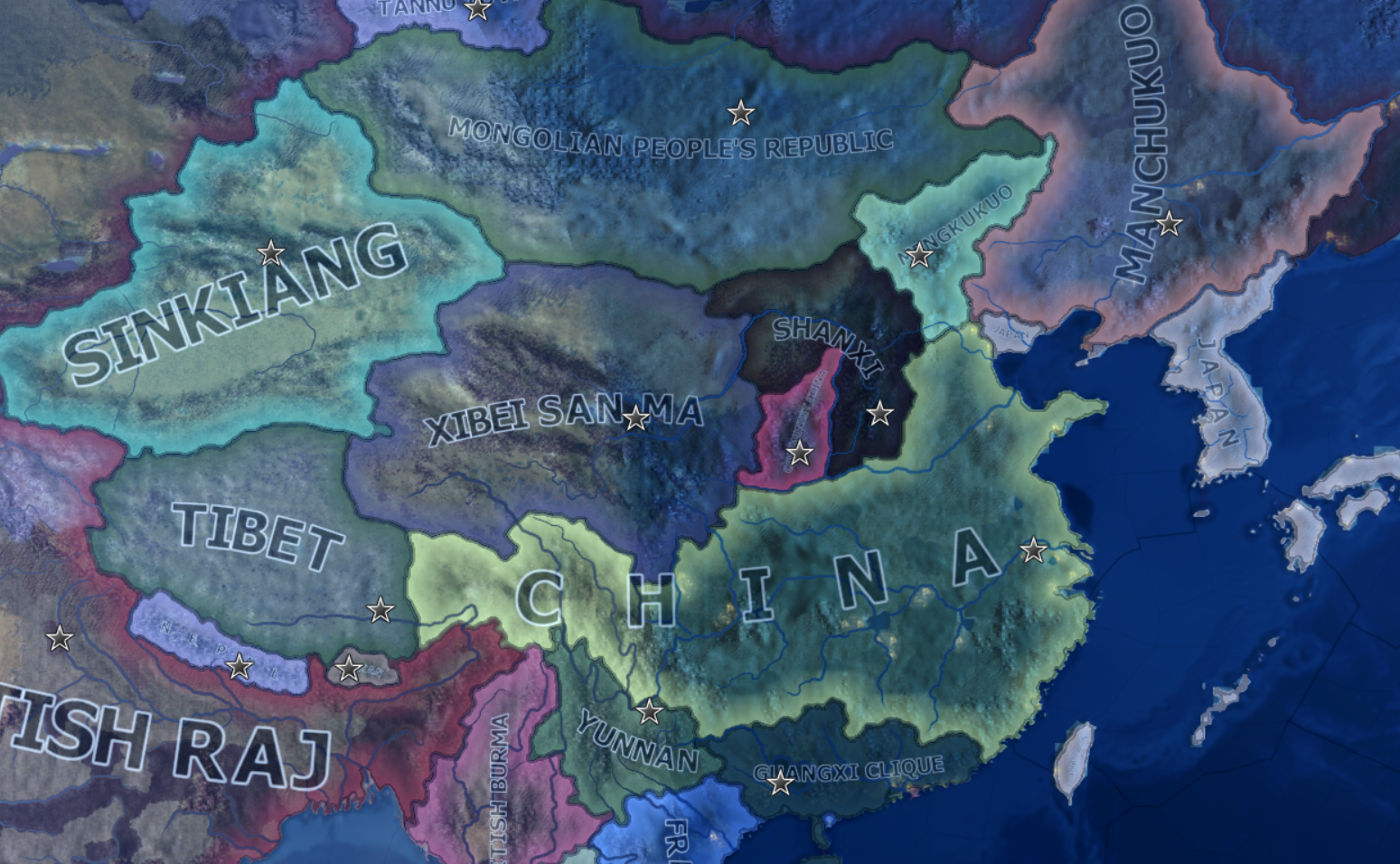
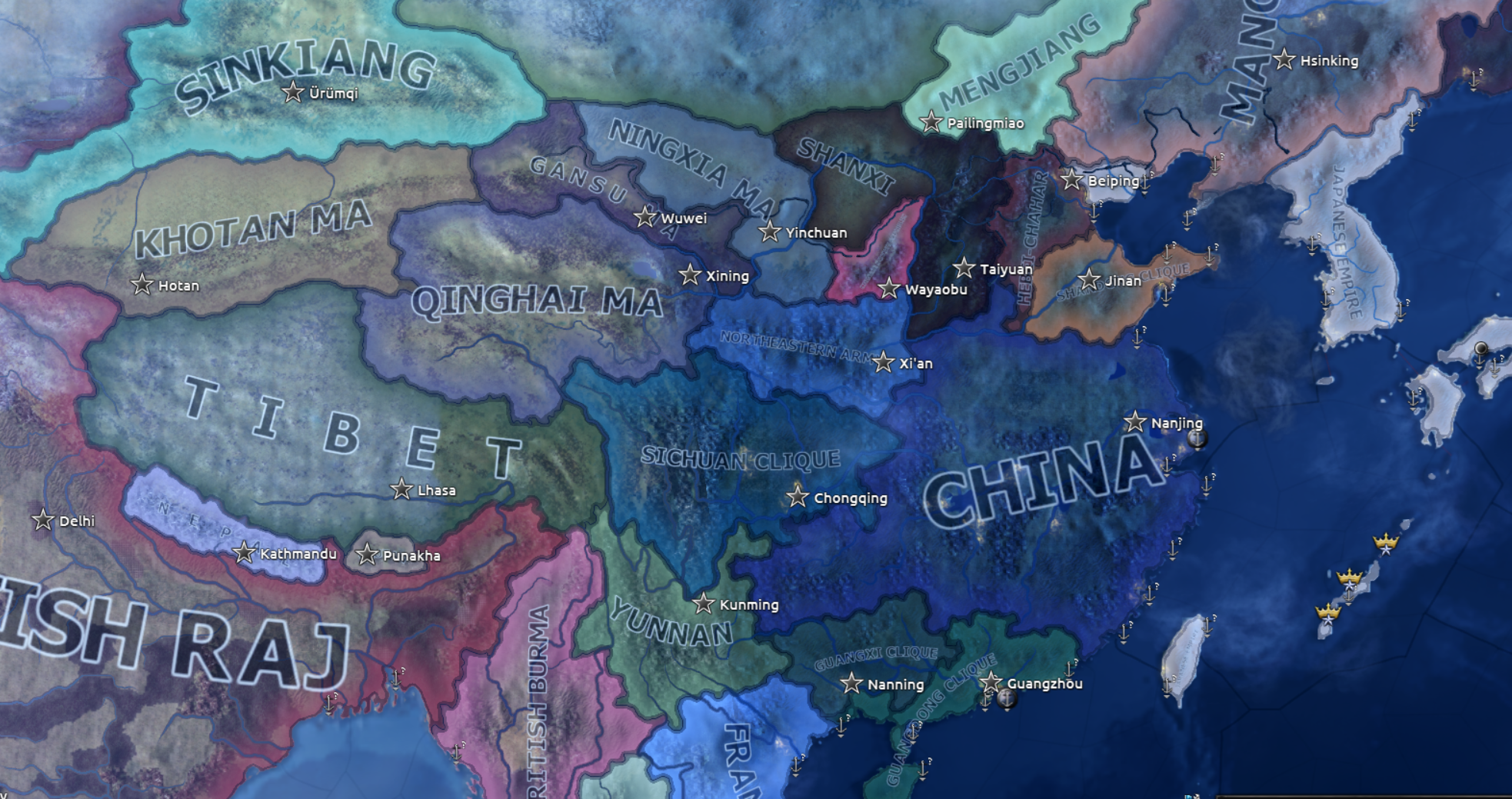 Old / NewAdditionally, we’ve made terrain changes to be more accurate, such as mountains in correct positions.
Old / NewAdditionally, we’ve made terrain changes to be more accurate, such as mountains in correct positions. 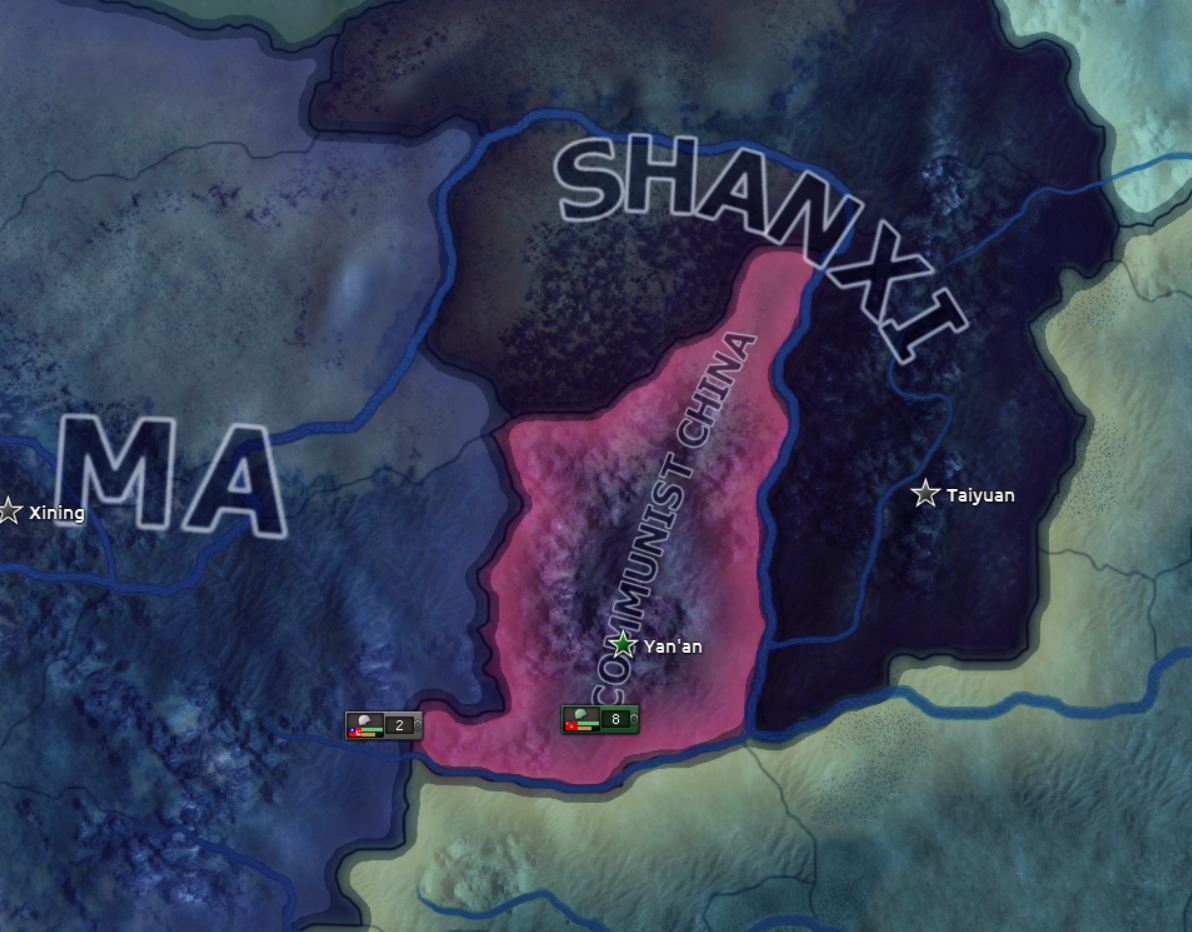
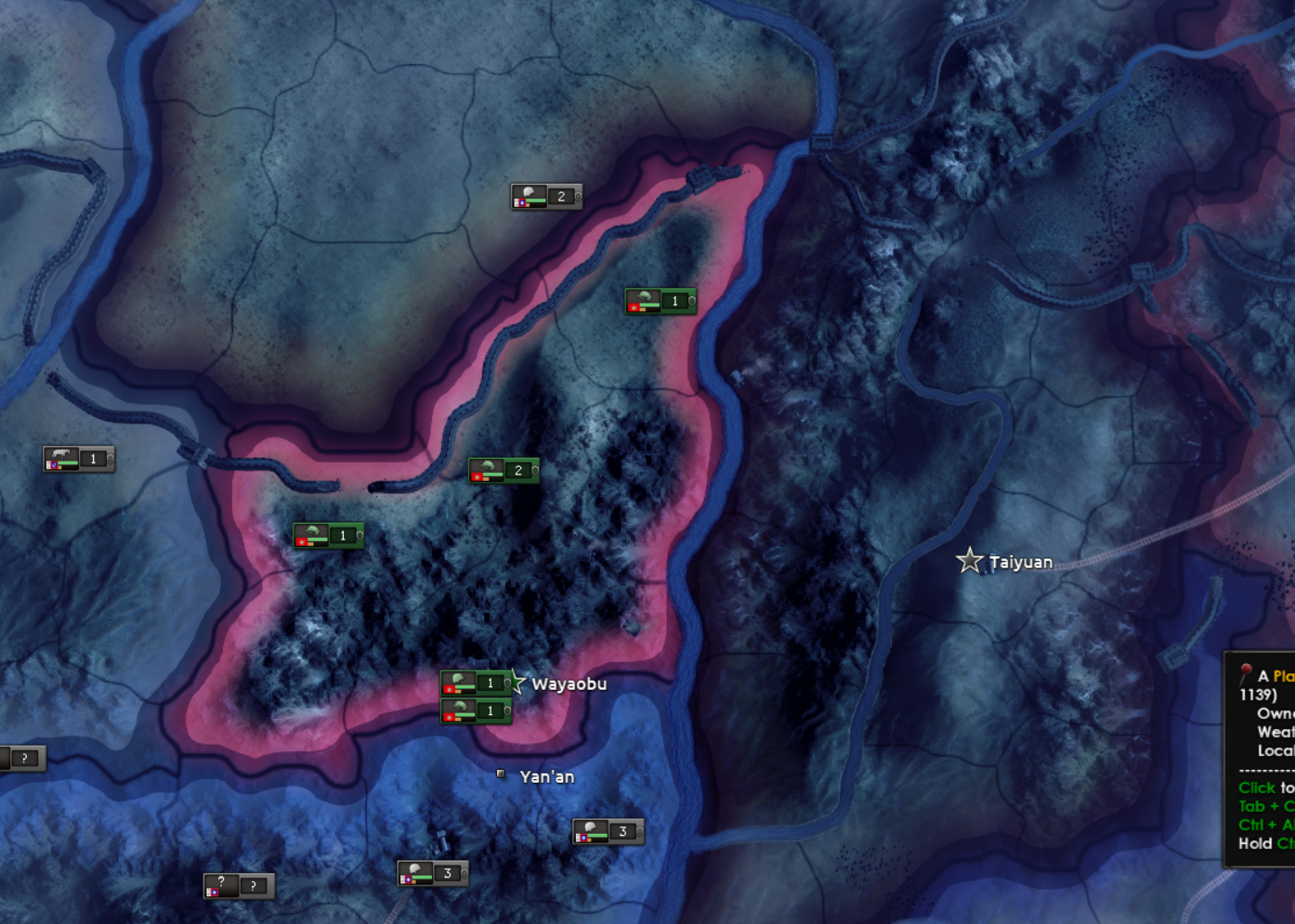 Old start position and newThe eagle-eyed observers of you who also read the Dev Corner covering China
Old start position and newThe eagle-eyed observers of you who also read the Dev Corner covering China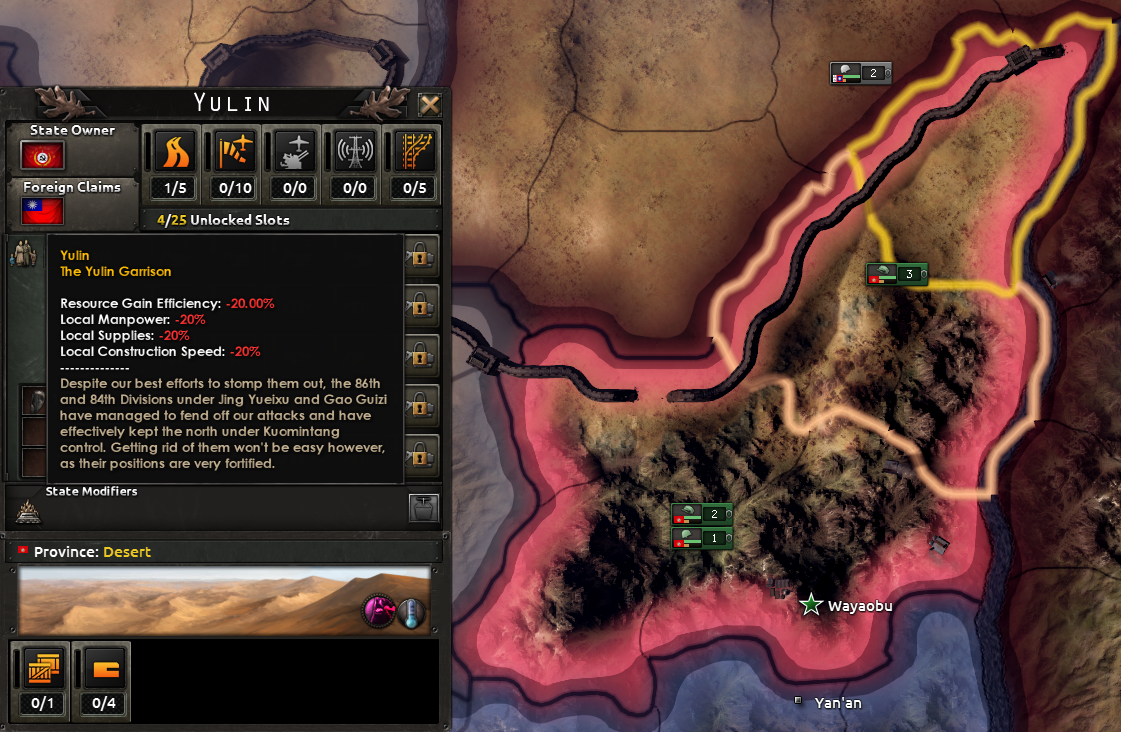 Having familiarized ourselves with the new starting position, it’s time to dive into what we’re all here for; the new Focus Tree!
Having familiarized ourselves with the new starting position, it’s time to dive into what we’re all here for; the new Focus Tree!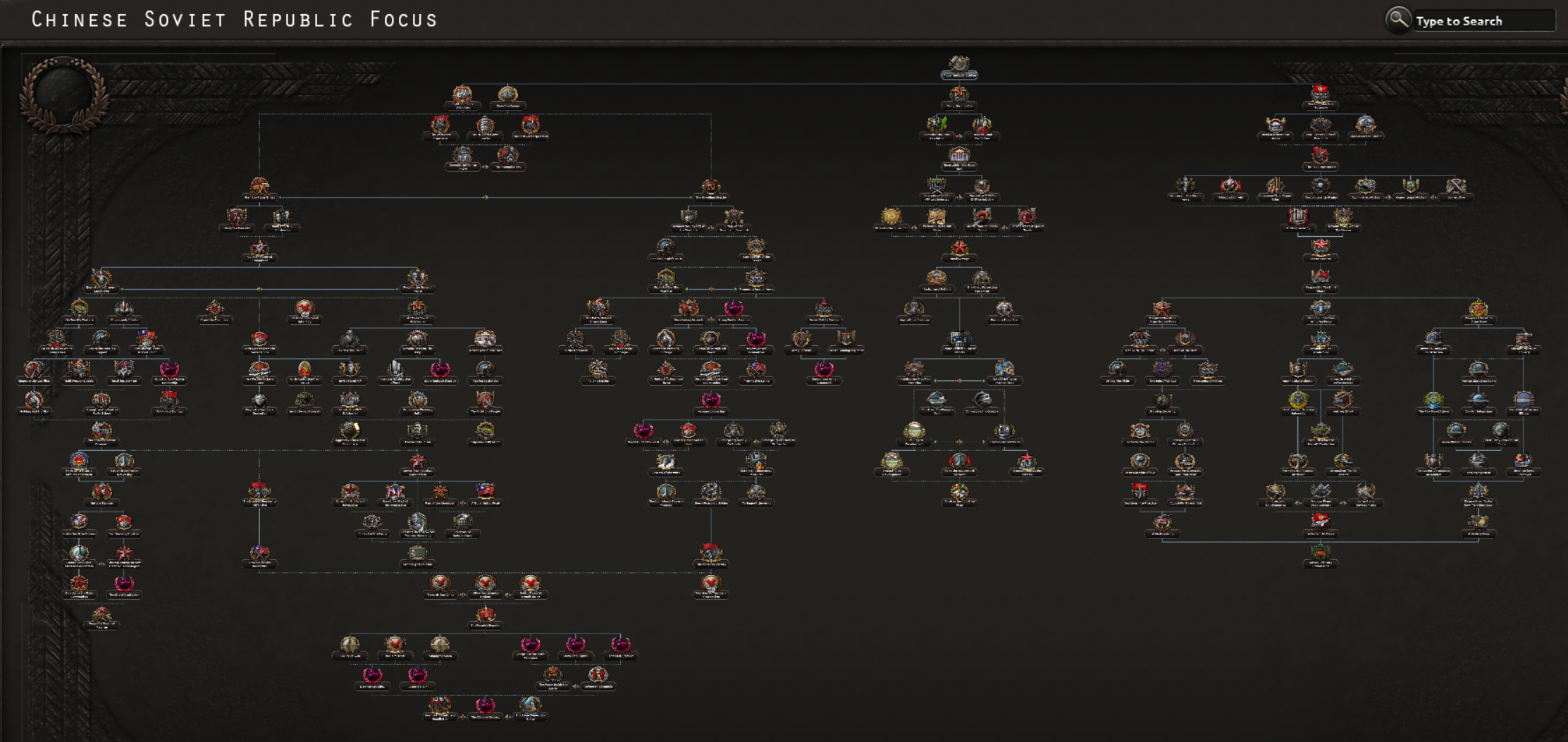
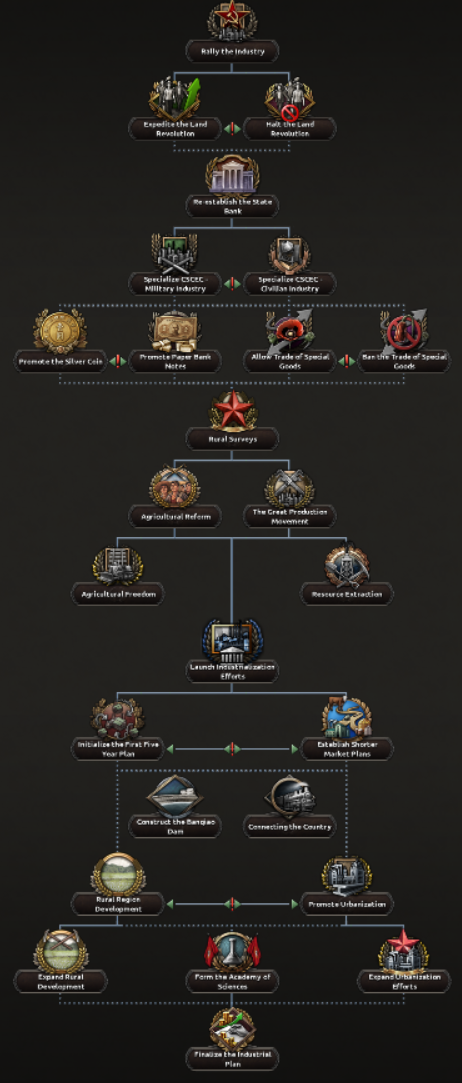 The industrial branchThe industrial situation in Communist controlled Northern China is…. not great.
The industrial branchThe industrial situation in Communist controlled Northern China is…. not great.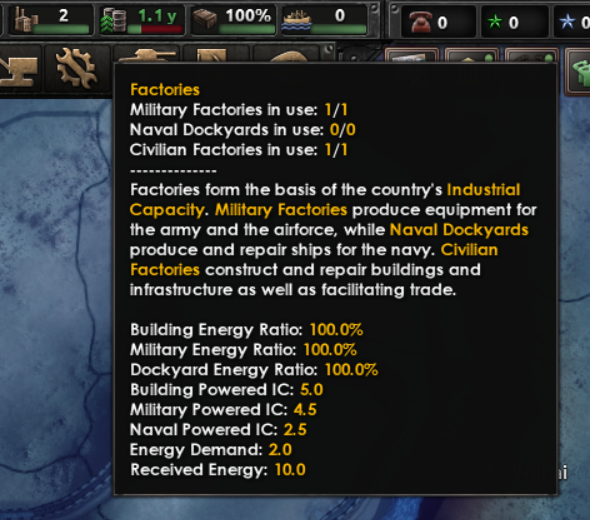
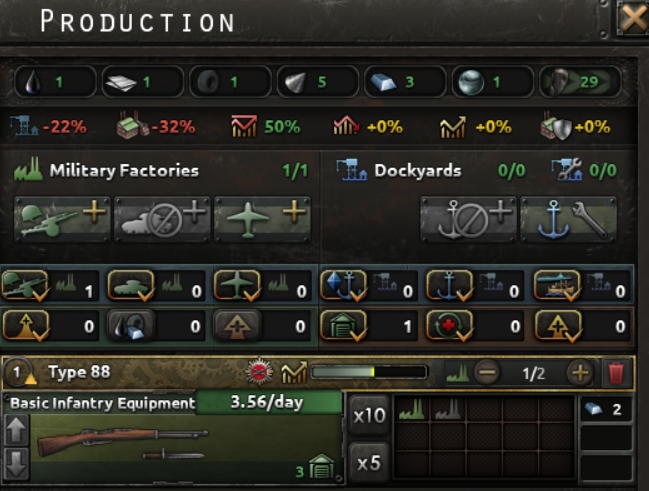 Did I mention we want you to feel like you are building from nothing? But fear not! The Chinese Soviet Republic has the chance to not only recover from their dire starting situation, but also to quickly industrialize and become something of an economic snowballing powerhouse.
Did I mention we want you to feel like you are building from nothing? But fear not! The Chinese Soviet Republic has the chance to not only recover from their dire starting situation, but also to quickly industrialize and become something of an economic snowballing powerhouse. 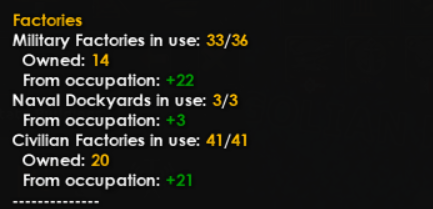
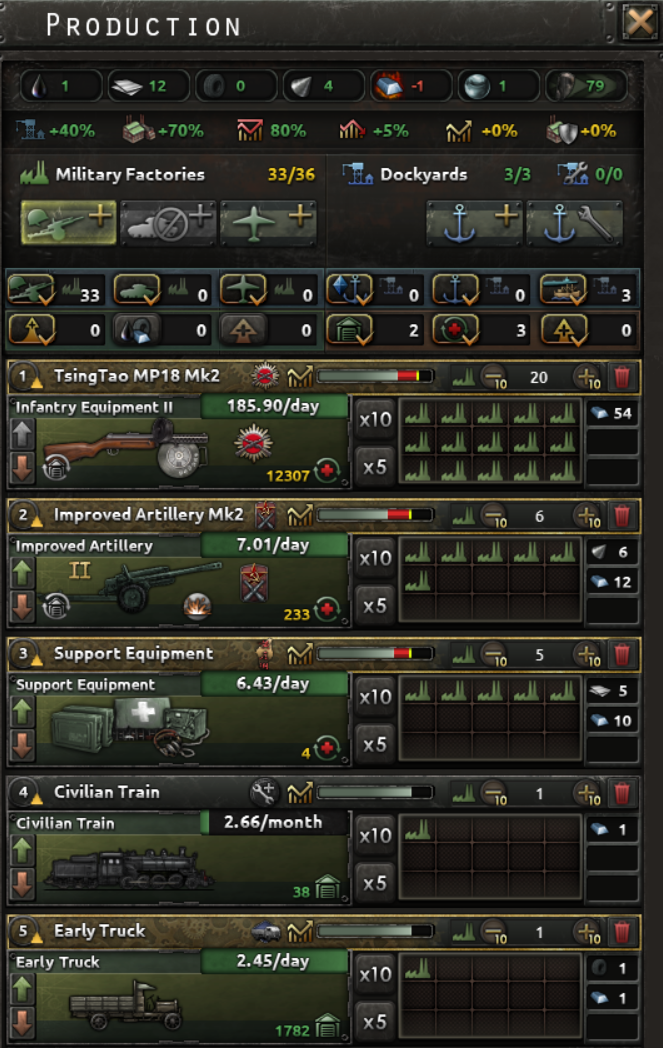 The industrial situation from a game in 1945, while still at war with Japan. While not on the scale of more industrialized nations, this represents a 4000% increase in factories from the start.
The industrial situation from a game in 1945, while still at war with Japan. While not on the scale of more industrialized nations, this represents a 4000% increase in factories from the start.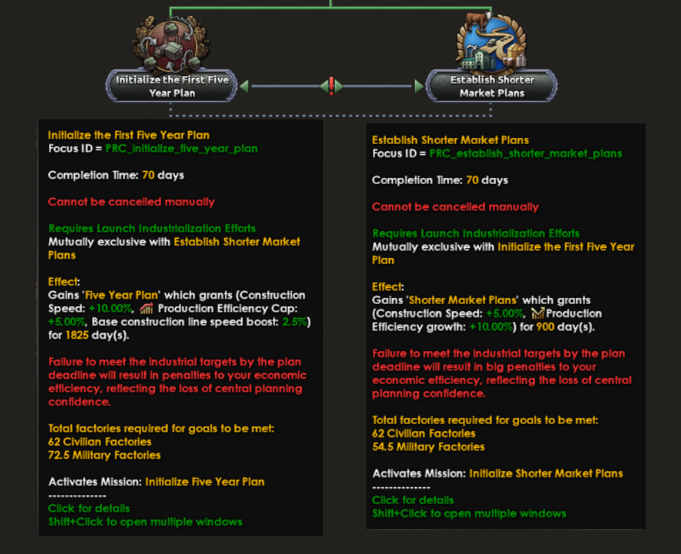 The focuses and requirements for the missions from the industrial situation in screenshot above
The focuses and requirements for the missions from the industrial situation in screenshot above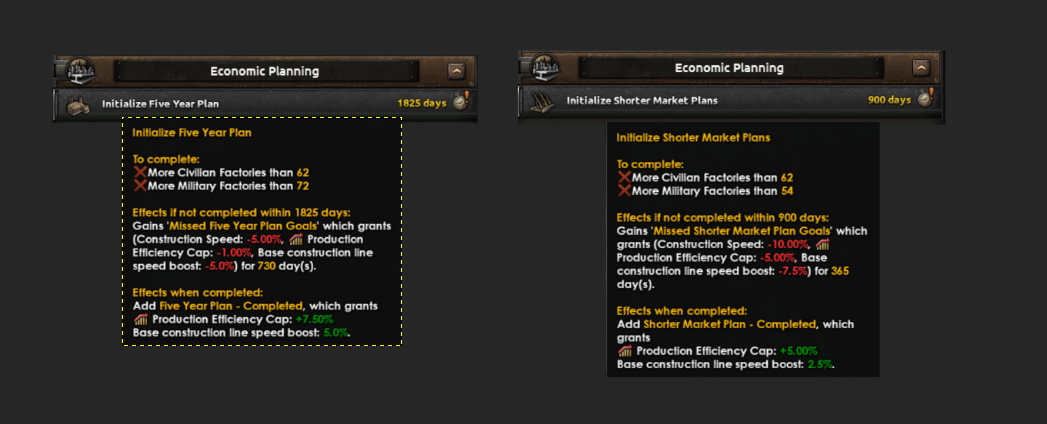 The missionsBoth bonuses give bonuses to the industrial might of the nation, but with that comes expectations that need to be met. If you were to meet them, great things await. Should you fail… well, you will only have yourself to blame for not planning correctly.
The missionsBoth bonuses give bonuses to the industrial might of the nation, but with that comes expectations that need to be met. If you were to meet them, great things await. Should you fail… well, you will only have yourself to blame for not planning correctly. 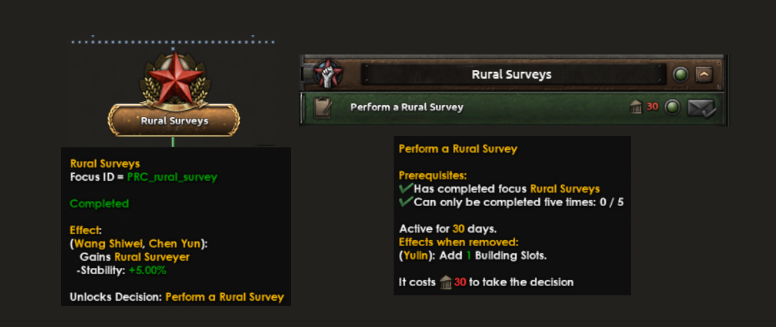 These unlock the decisions to spend PP to get building slots, thus allowing you to expand your industry even if you’re too busy fighting the Japanese to expand your territory.
These unlock the decisions to spend PP to get building slots, thus allowing you to expand your industry even if you’re too busy fighting the Japanese to expand your territory. 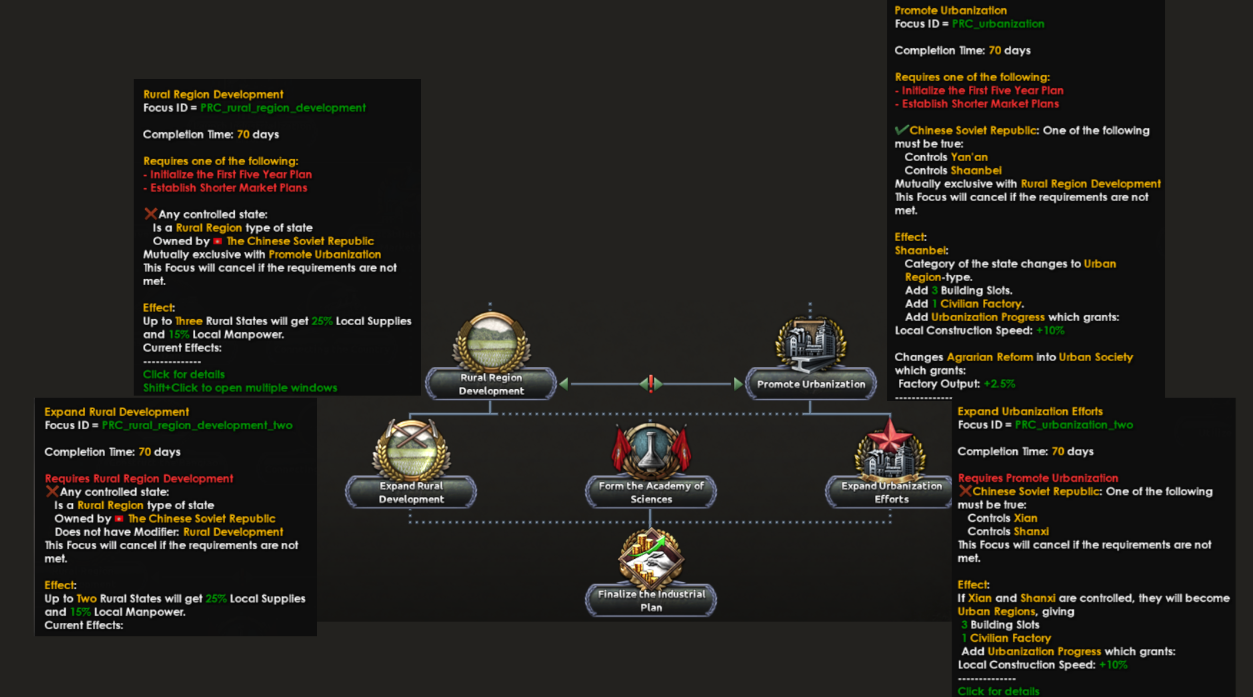 The player starts with the idea Agrarian Society, which can be modified in the industry tree. The player can also change the idea to Agrarian Reform, or if they take the path towards urbanization, the idea can be replaced by Urban Society.
The player starts with the idea Agrarian Society, which can be modified in the industry tree. The player can also change the idea to Agrarian Reform, or if they take the path towards urbanization, the idea can be replaced by Urban Society. 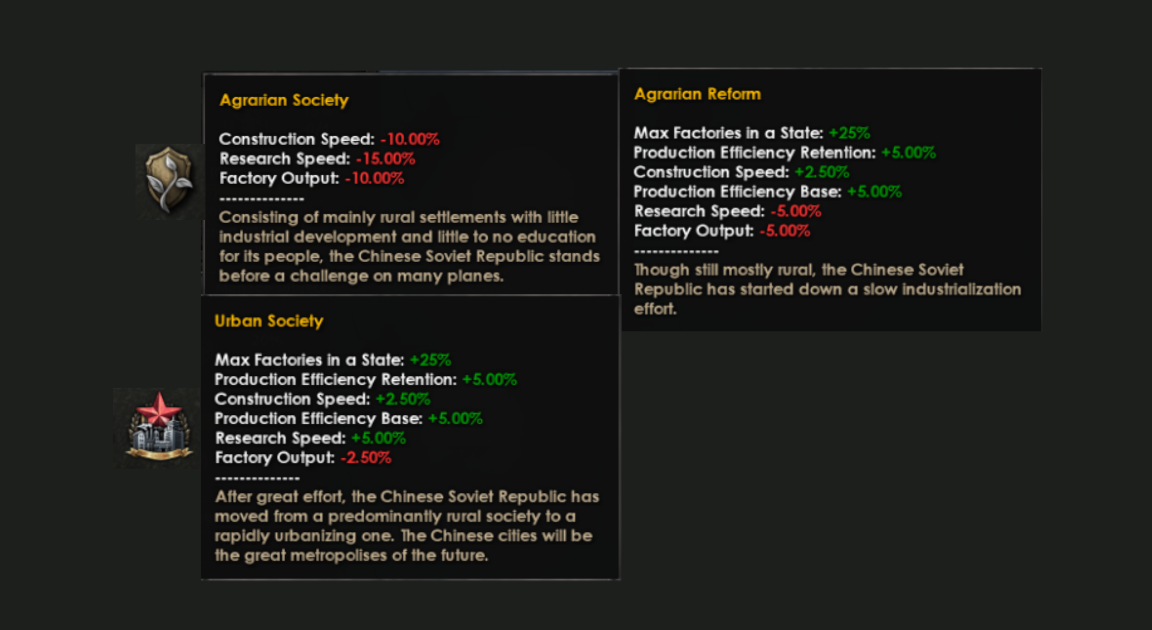 The player starts with Agrarian Society, but can improve it to Agrarian Reform. Later in the tree the player can turn it into Urban Society. The numbers and balance are not finished yet.
The player starts with Agrarian Society, but can improve it to Agrarian Reform. Later in the tree the player can turn it into Urban Society. The numbers and balance are not finished yet.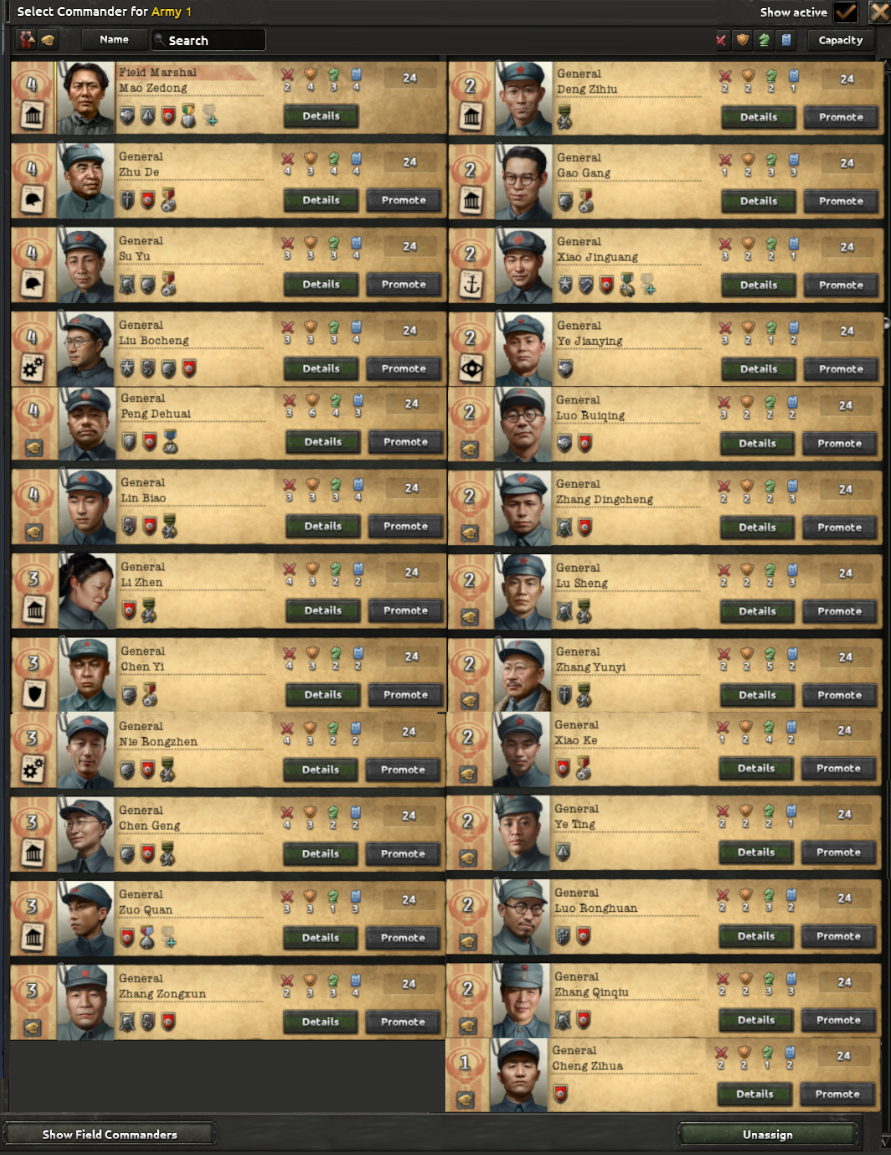 Here’s a list of all the starting Generals. He Long and Zhang Guotao are on a road trip (they can join you later on) at the start of the game.And yes, there are even a few admirals - though you will have your work cut out to create a navy. The first of these challenges being that you are playing a landlocked country 1200 kilometers from the nearest coast line (I checked with Google maps - that’s quite the roadtrip!). More on that later.
Here’s a list of all the starting Generals. He Long and Zhang Guotao are on a road trip (they can join you later on) at the start of the game.And yes, there are even a few admirals - though you will have your work cut out to create a navy. The first of these challenges being that you are playing a landlocked country 1200 kilometers from the nearest coast line (I checked with Google maps - that’s quite the roadtrip!). More on that later. 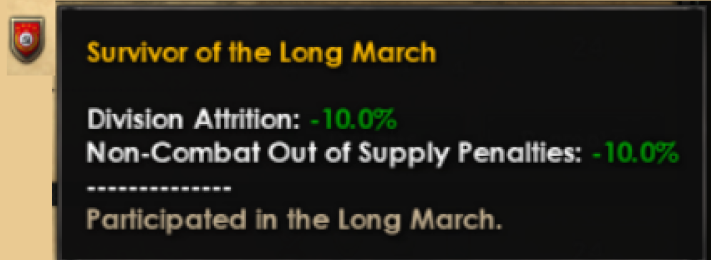 Survivor of the Long March trait
Survivor of the Long March trait 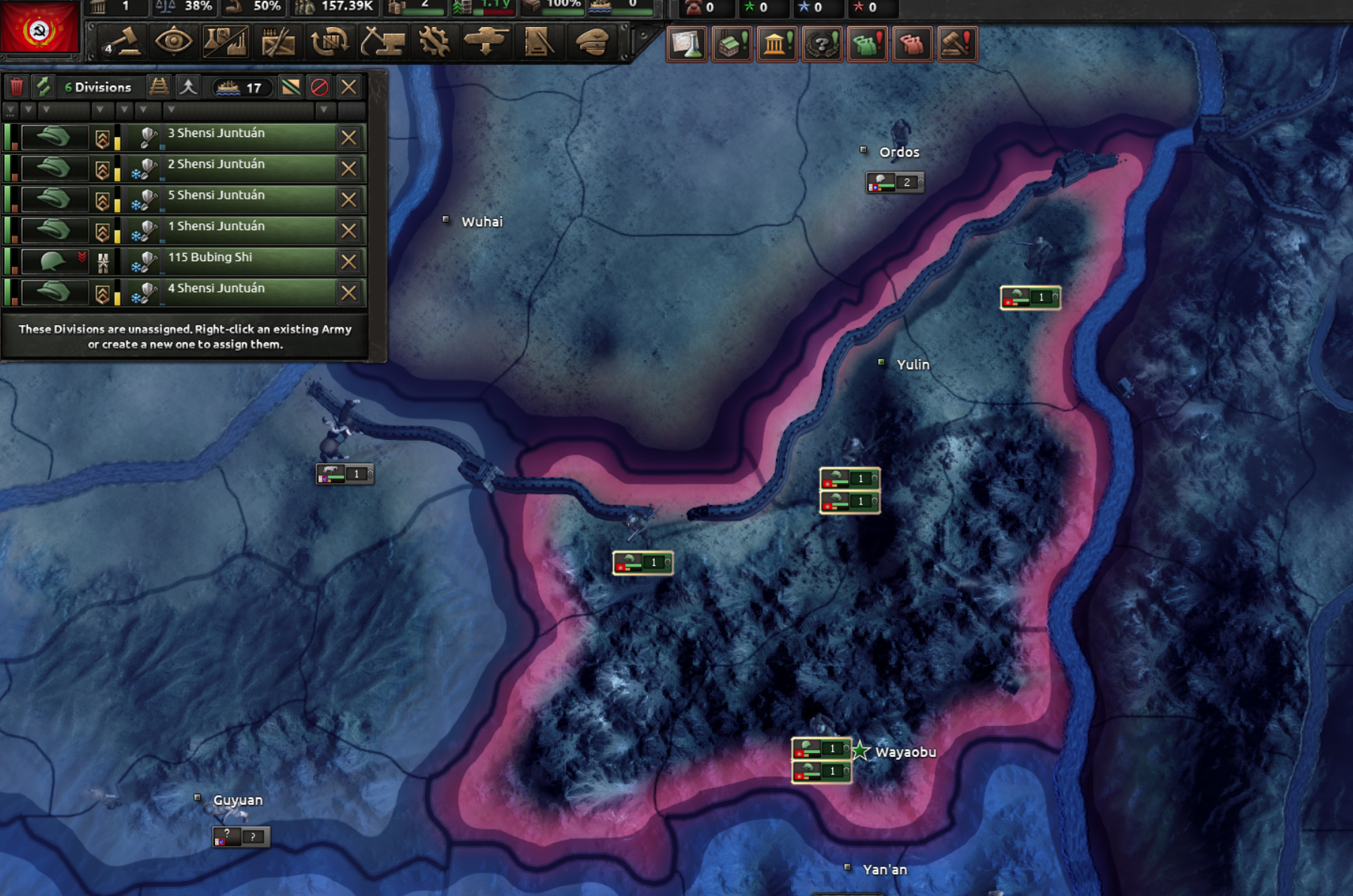
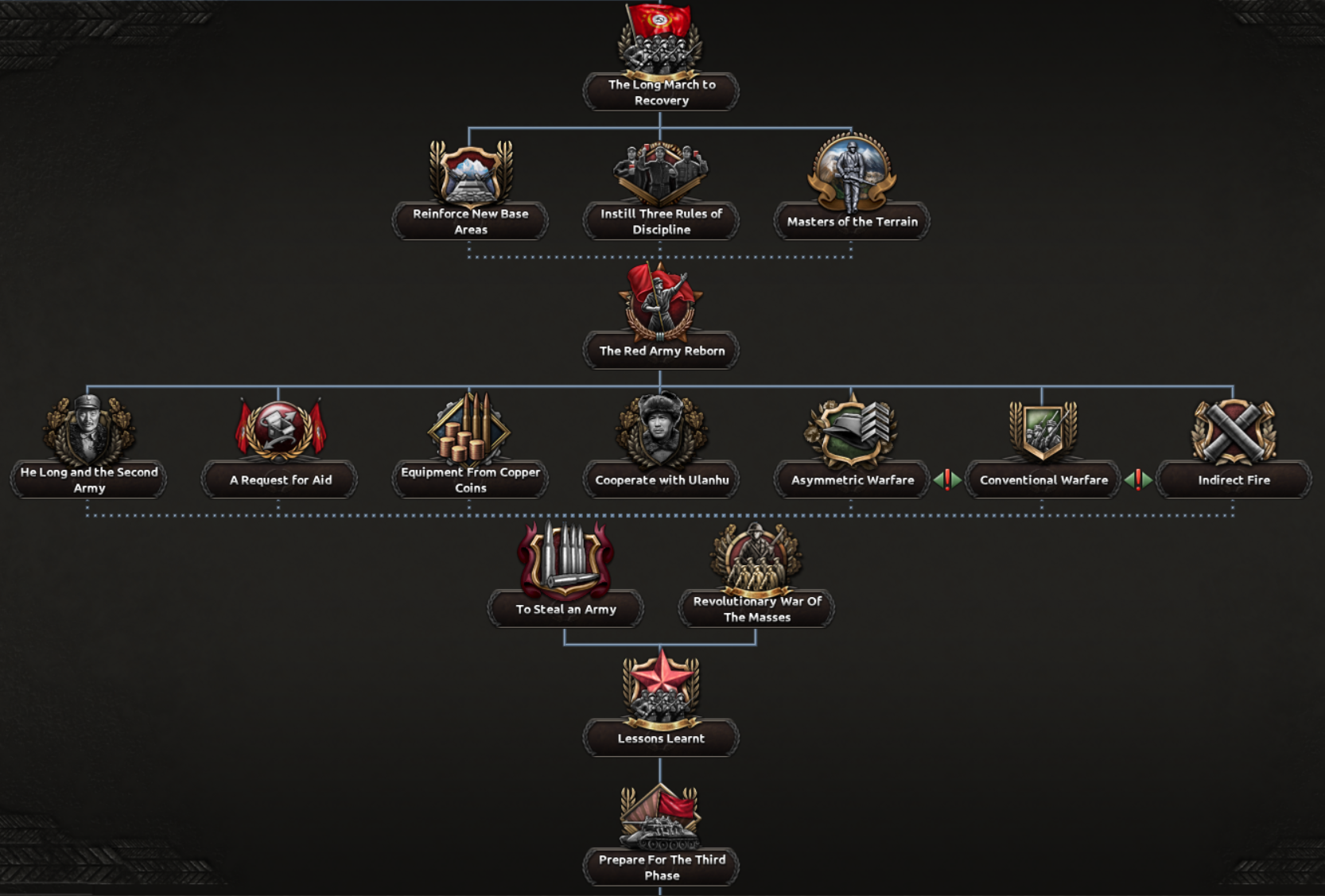
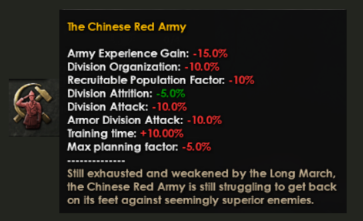 In the early part of the military, the goal for the player is to catch up and recover from the Long March. After that, the player will have the chance to form the People’s Liberation Army, and all of its different branches (actually it’s most - you’re not getting a space force this DLC, I’m terribly sorry to disappoint).
In the early part of the military, the goal for the player is to catch up and recover from the Long March. After that, the player will have the chance to form the People’s Liberation Army, and all of its different branches (actually it’s most - you’re not getting a space force this DLC, I’m terribly sorry to disappoint).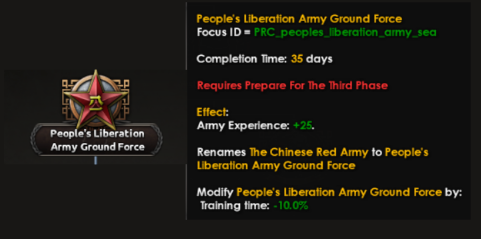
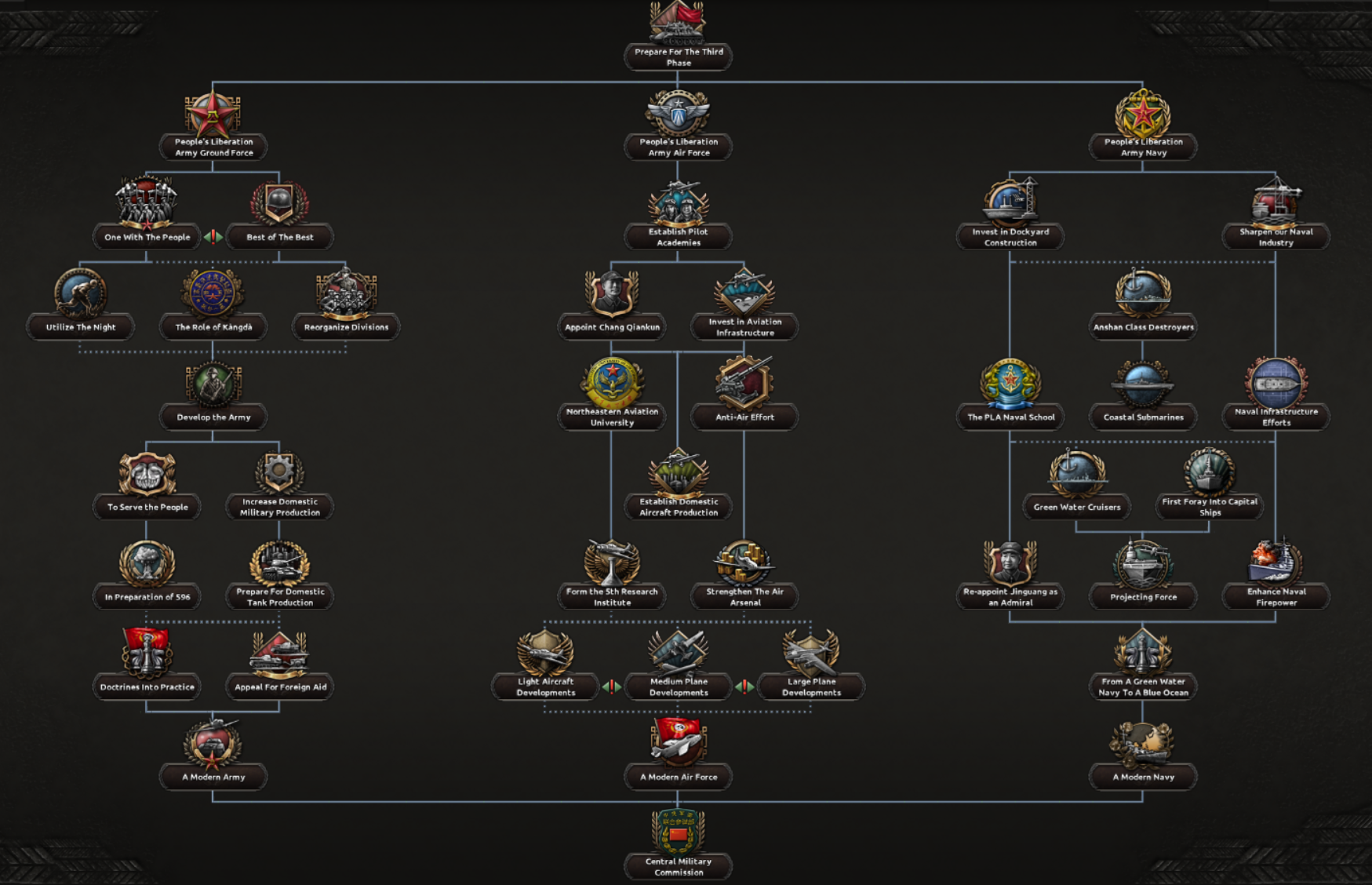 The different late game military branches
The different late game military branches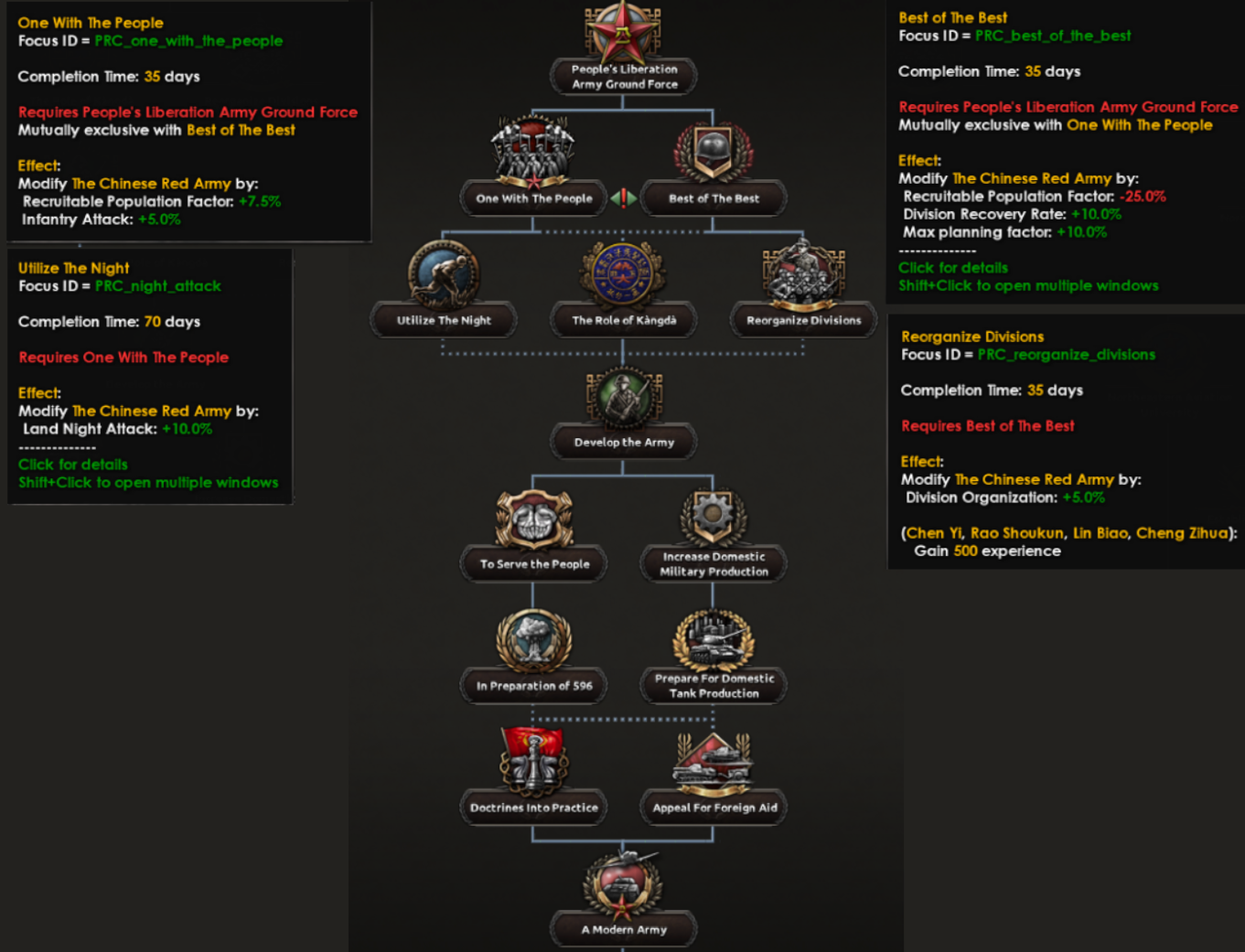 Additionally, we needed a way for the Communist player to be able to catch up in regards to armor, compared to nations who start with a tradition of a mechanized and armored army. We took inspiration from the 1950s, with PRC’s early tanks being primarily Soviet made T-34/85s before domestic construction of T54s started.
Additionally, we needed a way for the Communist player to be able to catch up in regards to armor, compared to nations who start with a tradition of a mechanized and armored army. We took inspiration from the 1950s, with PRC’s early tanks being primarily Soviet made T-34/85s before domestic construction of T54s started. 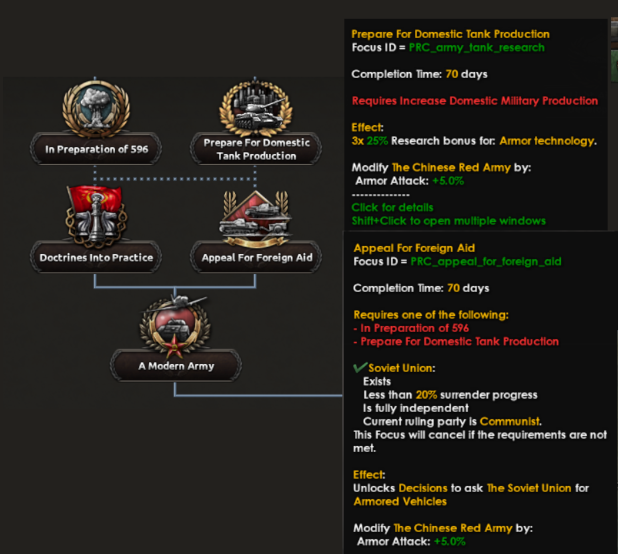
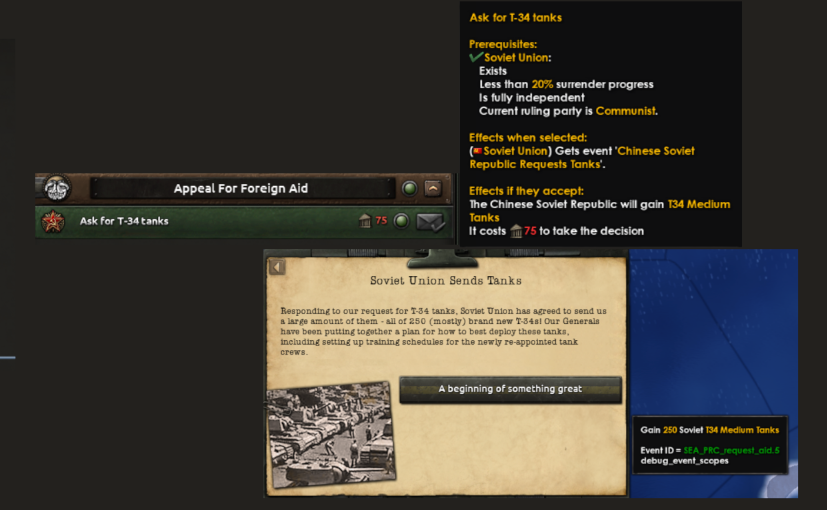 Tanks. Tanks.
Tanks. Tanks.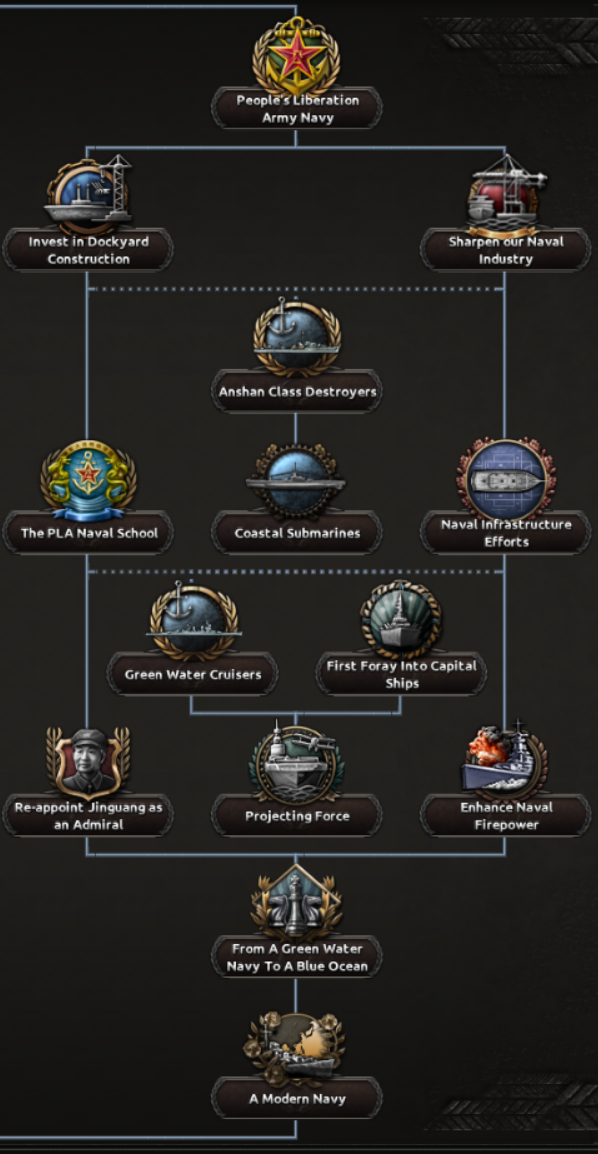 The main theme for this branch, which mirrors the history of the PRC navy, is playing catch up. So I wanted to reflect that in the type of focuses you can pick. Obviously your first priority will be to construct dockyards.
The main theme for this branch, which mirrors the history of the PRC navy, is playing catch up. So I wanted to reflect that in the type of focuses you can pick. Obviously your first priority will be to construct dockyards. 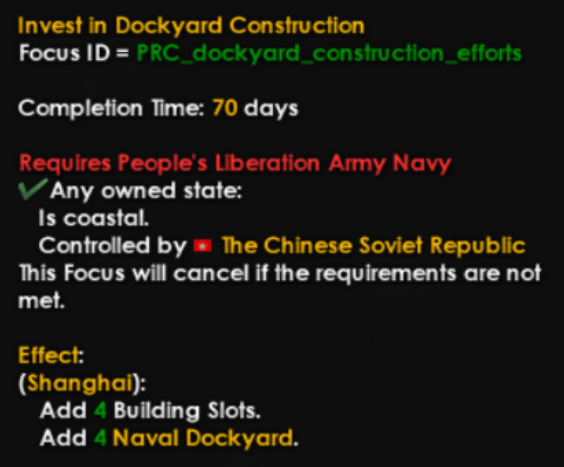 Beyond that, the early PLAN consisted of a lot of Soviet era ships purchased in the 1950s (including the Anshan class destroyers, which were originally Soviet Gnevny class), so we reflect that in the focus tree while also expanding upon that with some alternative ship classes.
Beyond that, the early PLAN consisted of a lot of Soviet era ships purchased in the 1950s (including the Anshan class destroyers, which were originally Soviet Gnevny class), so we reflect that in the focus tree while also expanding upon that with some alternative ship classes. 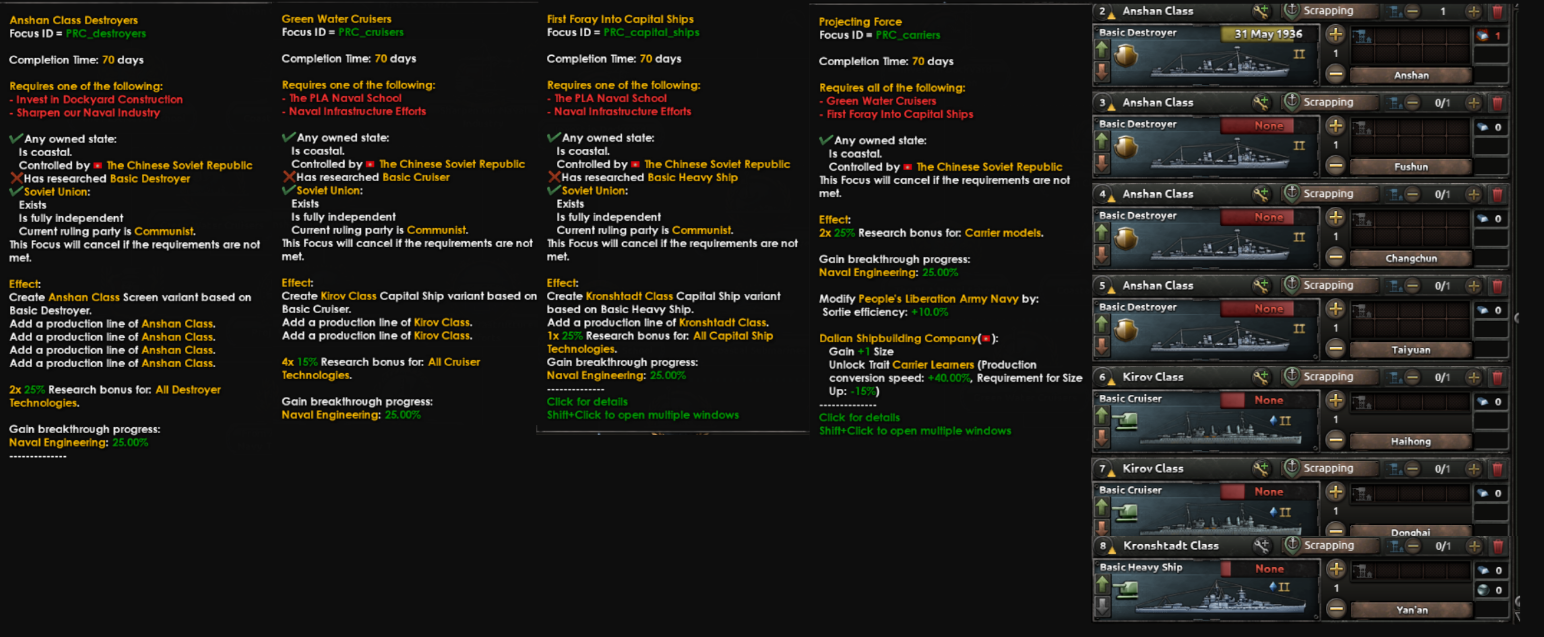 Soviet ships
Soviet ships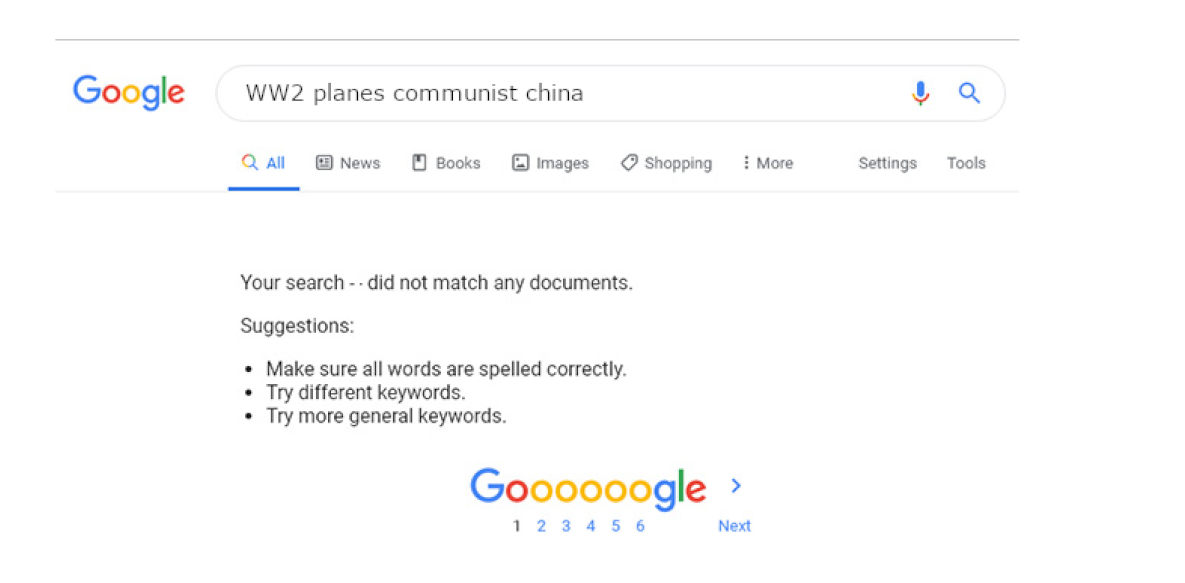 Well, what to do? We decided to focus on having the player playing catch up primarily in the forms of technology boosts. I wanted to ensure that the player would be able to build a proper late game air force.
Well, what to do? We decided to focus on having the player playing catch up primarily in the forms of technology boosts. I wanted to ensure that the player would be able to build a proper late game air force. 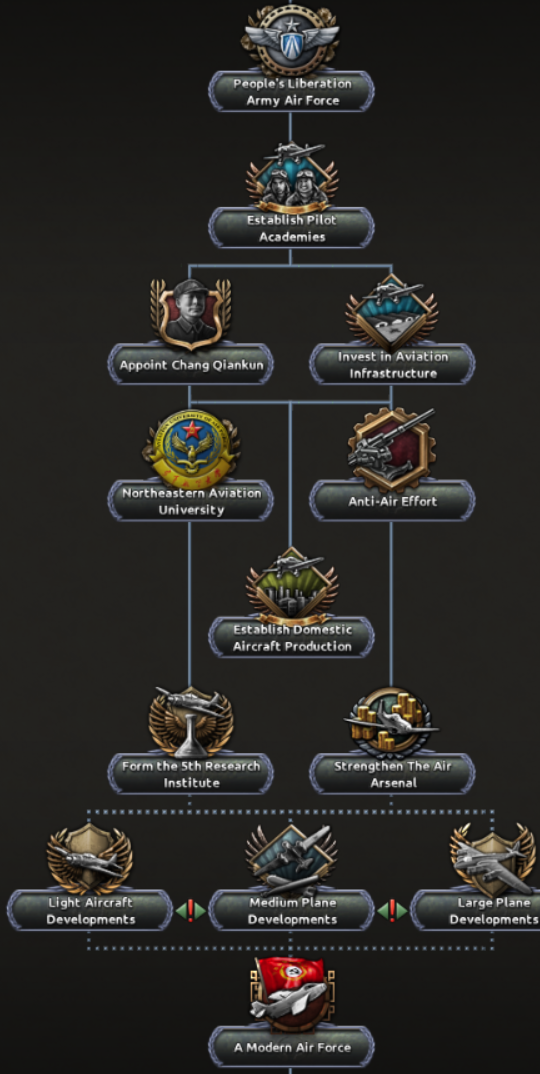 As such, the focus is on research bonuses, establishing production to actually build planes, and having focuses that give radar and AA to help supplement your lack of air force.
As such, the focus is on research bonuses, establishing production to actually build planes, and having focuses that give radar and AA to help supplement your lack of air force. 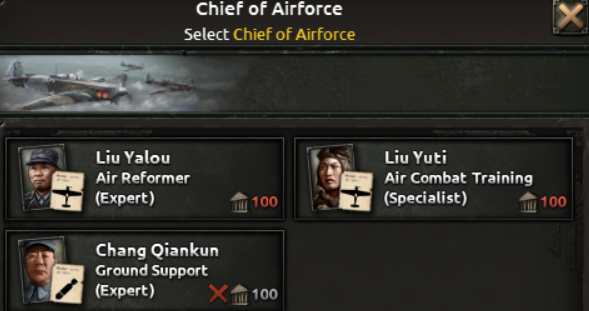
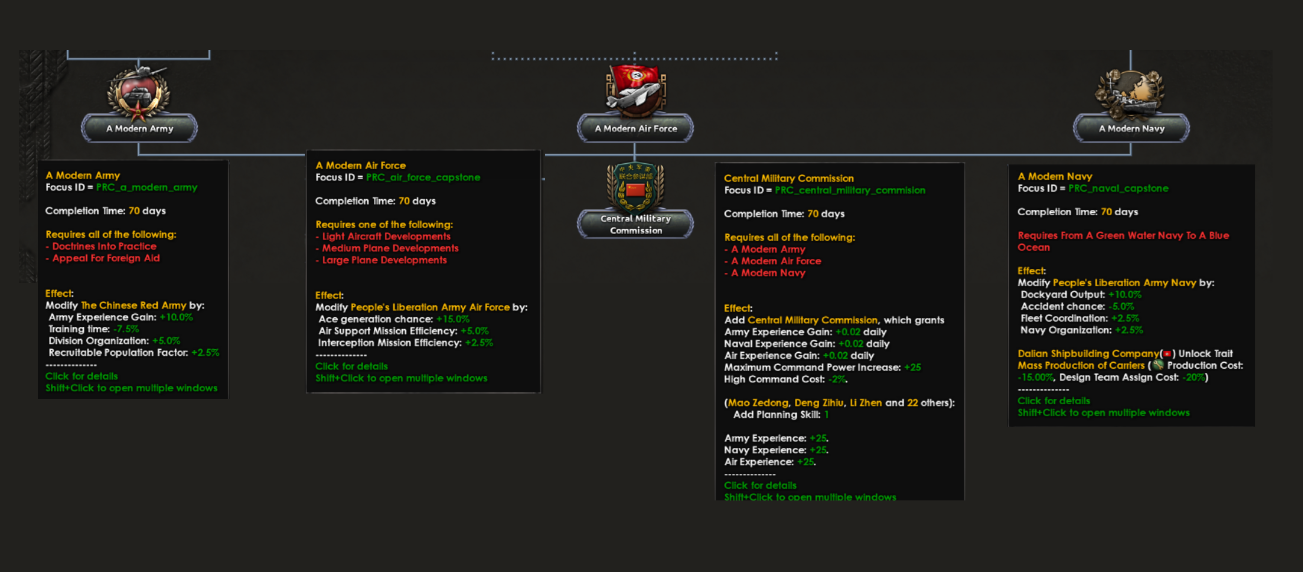 And here is a look of all the capstone focuses on the military branch, leading up to the creation of the Central Military Commission.
And here is a look of all the capstone focuses on the military branch, leading up to the creation of the Central Military Commission. 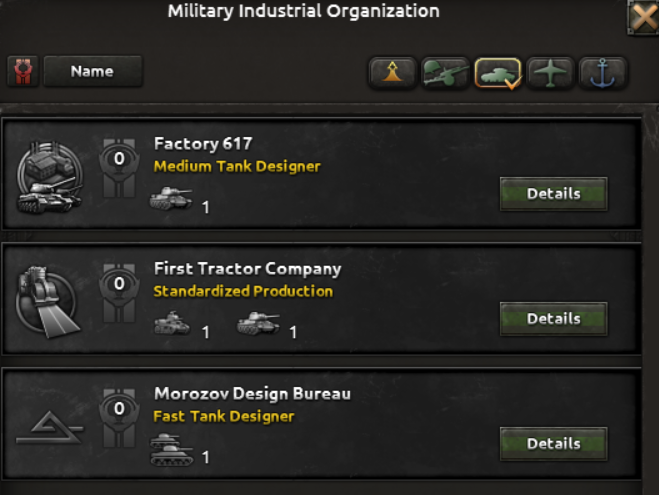 Tank MIOs
Tank MIOs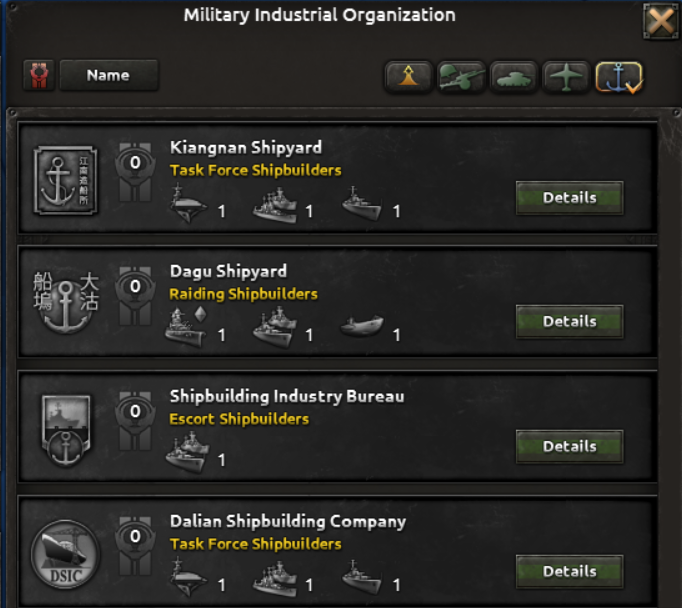 Naval MIOs
Naval MIOs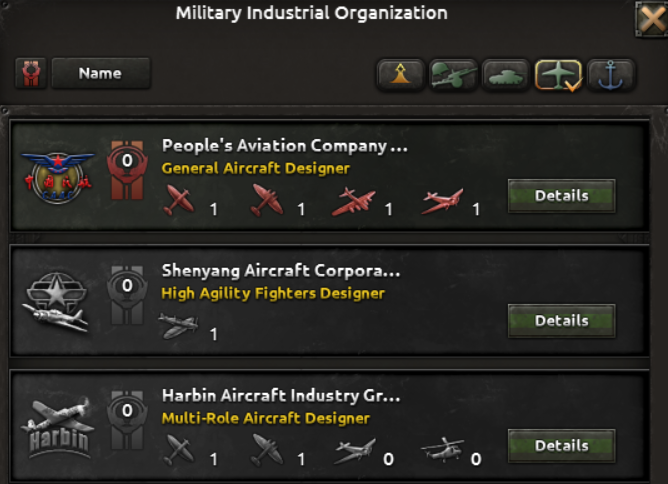 Aircraft MIOs
Aircraft MIOs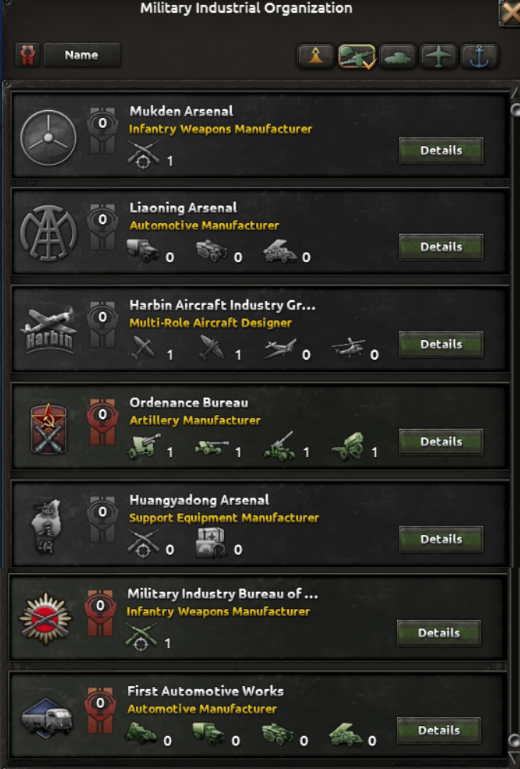 Material MIOHaving gone through the Common Branches, it’s time to turn to….
Material MIOHaving gone through the Common Branches, it’s time to turn to….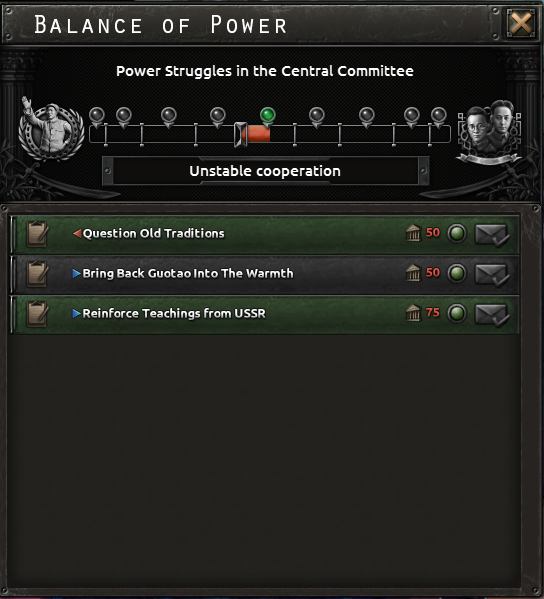 The main rival(s) to Mao were the 28½ Bolsheviks (more about them later), but also another military commander, Zhang Guotao, who had attempted to establish a rival Central Committee in 1935 but ultimately failed. Each one of these three internal factions has its own bonuses based on its level of influence in the Balance of Power.
The main rival(s) to Mao were the 28½ Bolsheviks (more about them later), but also another military commander, Zhang Guotao, who had attempted to establish a rival Central Committee in 1935 but ultimately failed. Each one of these three internal factions has its own bonuses based on its level of influence in the Balance of Power.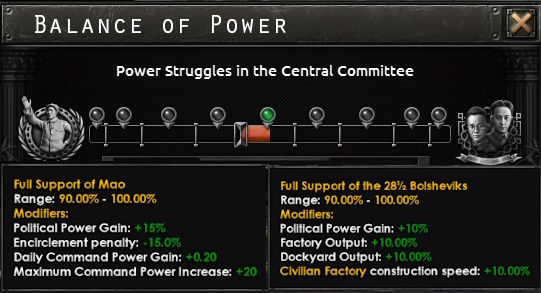 While not a central part of playing the Chinese Soviet Republic, the Balance of Power bears keeping in mind, because the bonuses you get from it might be very helpful in your struggle against both the Nationalists and Japan.
While not a central part of playing the Chinese Soviet Republic, the Balance of Power bears keeping in mind, because the bonuses you get from it might be very helpful in your struggle against both the Nationalists and Japan.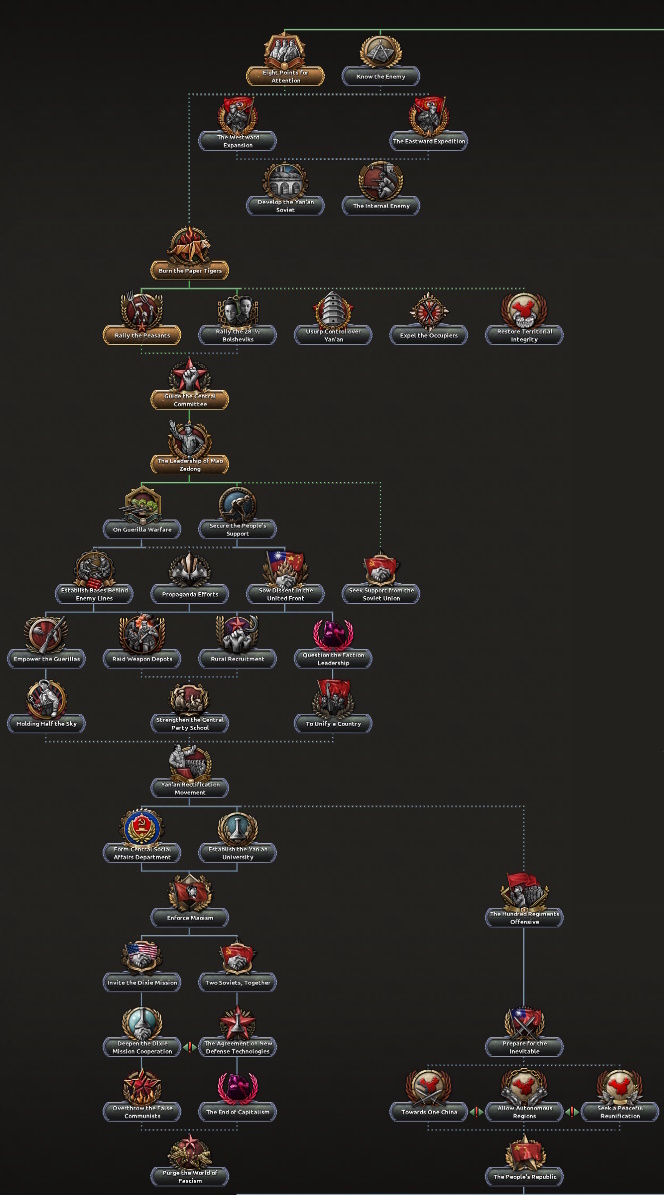 As already mentioned, Communist China is in a really tough spot in 1936 - and things aren’t looking up either. There are limited opportunities for early expansion, and Japan is *knock knock Kon'nichiwa* on the door. Time is not on the Chinese Soviet Republic’s side, but play your cards right, bide your time, and you’ll be able to become the undisputed ruler of all of China! Before you can go down the historical path and see Mao assume complete leadership over the Communists, or have one of his rivals ascend and claim power over the Central Committee, there are a few focuses you can take to help grow militarily and industrially before facing off against the Japanese.
As already mentioned, Communist China is in a really tough spot in 1936 - and things aren’t looking up either. There are limited opportunities for early expansion, and Japan is *knock knock Kon'nichiwa* on the door. Time is not on the Chinese Soviet Republic’s side, but play your cards right, bide your time, and you’ll be able to become the undisputed ruler of all of China! Before you can go down the historical path and see Mao assume complete leadership over the Communists, or have one of his rivals ascend and claim power over the Central Committee, there are a few focuses you can take to help grow militarily and industrially before facing off against the Japanese.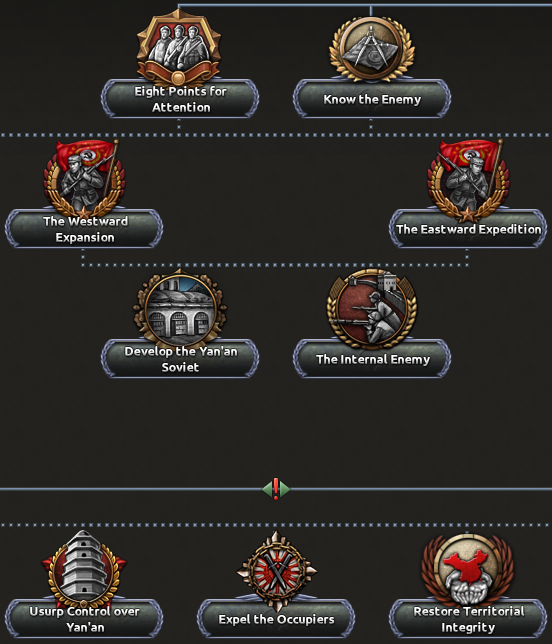 You can engage in Border Wars with your neighbours with The Eastward and Westward Expedition, but these Border Wars will be hard-fought affairs with a tired and belligerent Red Army. Completing Know the Enemy will give you some temporary bonuses against your neighbours, but it will hardly be the only thing you have to do to quickly expand your territory. It will however unlock the Raid Border Defenses - helping you even further to gain control of your neighbouring areas.
You can engage in Border Wars with your neighbours with The Eastward and Westward Expedition, but these Border Wars will be hard-fought affairs with a tired and belligerent Red Army. Completing Know the Enemy will give you some temporary bonuses against your neighbours, but it will hardly be the only thing you have to do to quickly expand your territory. It will however unlock the Raid Border Defenses - helping you even further to gain control of your neighbouring areas. 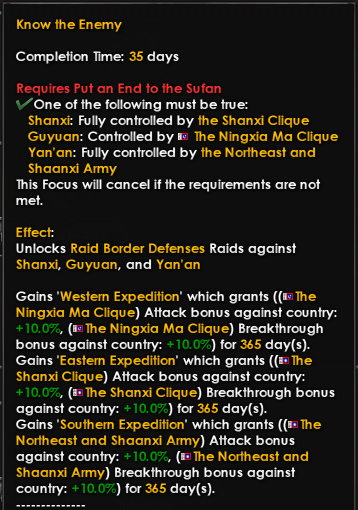
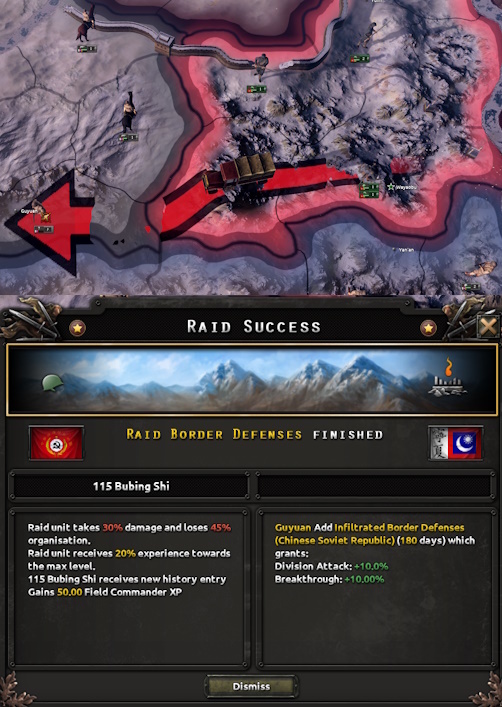 Usurp Control over Yan’an works a bit differently, though; depending on when you do this focus, you’ll get another Border War, or you can get a state for free if you’re allied with the Nationalists (psssst maybe just waiting around for nothing might help you too because of some extra content exclusive to the Northeast and Shaanxi Army warlord directly to the south).
Usurp Control over Yan’an works a bit differently, though; depending on when you do this focus, you’ll get another Border War, or you can get a state for free if you’re allied with the Nationalists (psssst maybe just waiting around for nothing might help you too because of some extra content exclusive to the Northeast and Shaanxi Army warlord directly to the south). 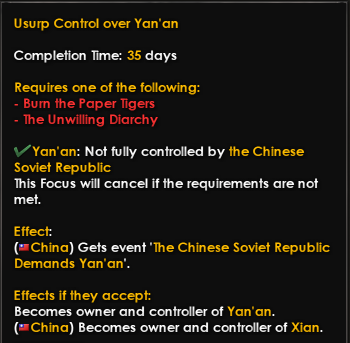 Having solidified your control over Yan’an, you can choose to either develop your new holdings or take a more aggressive stance against the rest of China.
Having solidified your control over Yan’an, you can choose to either develop your new holdings or take a more aggressive stance against the rest of China.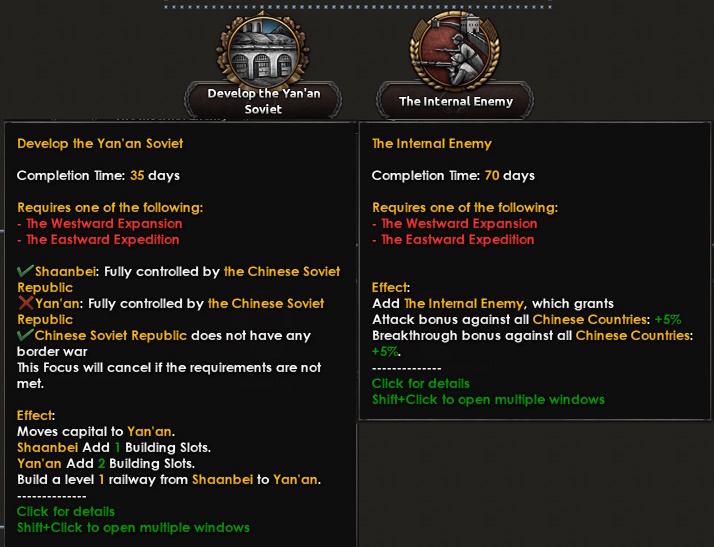 With Burn the Paper Tiger, you can beat everyone else in China to creating a faction and invite the Nationalists - thus becoming the faction leader (even though several of the Warlords are likely to shun your leadership and refuse to join the faction and the Nationalists might usurp your leadership). Rally the Peasants and Guide the Central Committee will unlock decisions to push the Balance of Power in Mao’s favor so that you can Embrace the Change in Leadership and have Mao solidifying his grip of the Central Committee.
With Burn the Paper Tiger, you can beat everyone else in China to creating a faction and invite the Nationalists - thus becoming the faction leader (even though several of the Warlords are likely to shun your leadership and refuse to join the faction and the Nationalists might usurp your leadership). Rally the Peasants and Guide the Central Committee will unlock decisions to push the Balance of Power in Mao’s favor so that you can Embrace the Change in Leadership and have Mao solidifying his grip of the Central Committee.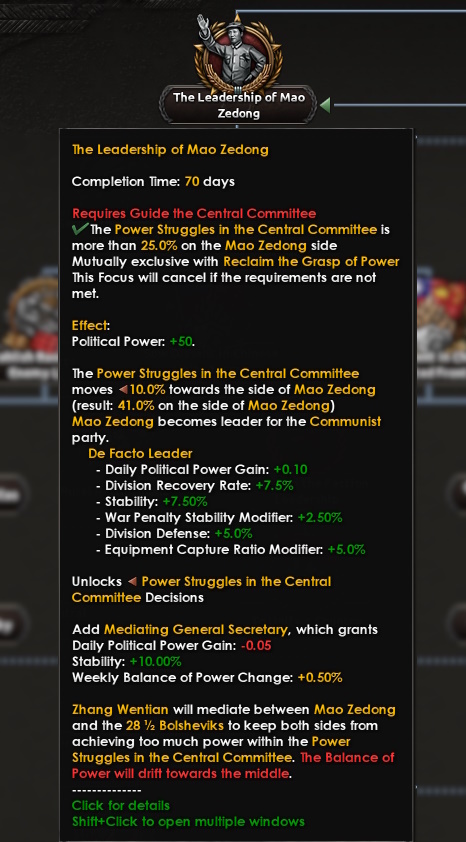 Having done all of this, you are ready to face the Japanese! From afar, that is; you’ll probably still lack a big industry and a substantial army, so you’ll want to play it safe and let the Nationalists do the heavy lifting. You can’t be too passive, though, since the front lines risk collapsing and you’ll be overrun, just like everyone else. To help you at least slow down the Japanese onslaught, you can pick a page from Mao’s book On Guerilla Warfare, which will strengthen your militias (which will work very well in synergy with the Infantry sub-doctrine Irregulars or Operations sub-doctrine People’s War) as well as unlock Guerilla Warfare Decisions.
Having done all of this, you are ready to face the Japanese! From afar, that is; you’ll probably still lack a big industry and a substantial army, so you’ll want to play it safe and let the Nationalists do the heavy lifting. You can’t be too passive, though, since the front lines risk collapsing and you’ll be overrun, just like everyone else. To help you at least slow down the Japanese onslaught, you can pick a page from Mao’s book On Guerilla Warfare, which will strengthen your militias (which will work very well in synergy with the Infantry sub-doctrine Irregulars or Operations sub-doctrine People’s War) as well as unlock Guerilla Warfare Decisions.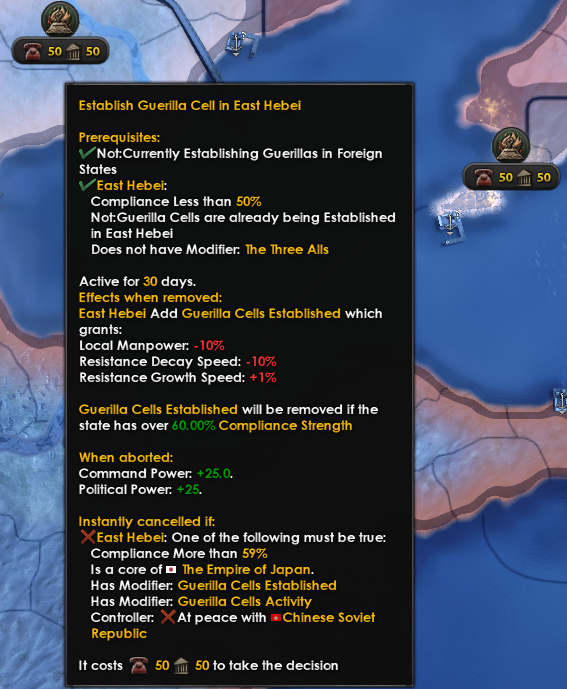 From this side of the branch, you can continue down to Establish Bases Behind Enemy Lines, allowing you to Establish Sabotage Operations on your core states against any country you’re fighting. With Empower the Guerillas you’ll halve the cost for taking Guerilla Warfare Decisions and improve the effects of said decisions.
From this side of the branch, you can continue down to Establish Bases Behind Enemy Lines, allowing you to Establish Sabotage Operations on your core states against any country you’re fighting. With Empower the Guerillas you’ll halve the cost for taking Guerilla Warfare Decisions and improve the effects of said decisions. 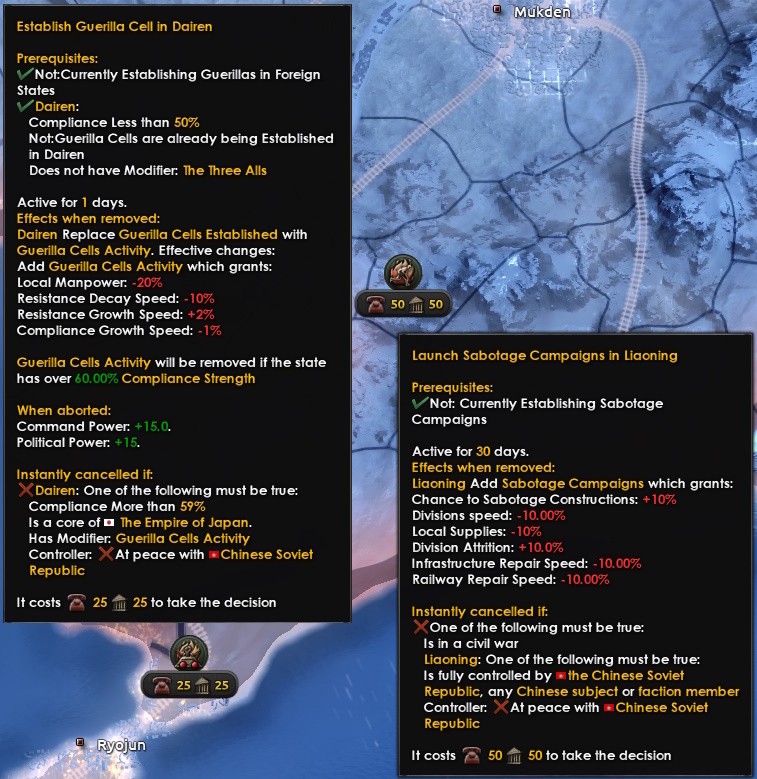 Going down the other path after Embrace the Change in Leadership with Propaganda Efforts, you’ll start to contend for the leadership within the United Front by increasing your Faction Influence contribution. With Secure the People’s Support, you’ll unlock the Rally Support in Chinese States Decisions, which will allow you to infiltrate Chinese states that you’re not at war with - whether they be allies or not. These decisions will help you in a potential future war later on, as they will give you bonuses for fighting in that state. You can even infiltrate the state so thoroughly that it’ll flip to your side once war is declared between your countries, with a militia unit rising up in support of your cause.
Going down the other path after Embrace the Change in Leadership with Propaganda Efforts, you’ll start to contend for the leadership within the United Front by increasing your Faction Influence contribution. With Secure the People’s Support, you’ll unlock the Rally Support in Chinese States Decisions, which will allow you to infiltrate Chinese states that you’re not at war with - whether they be allies or not. These decisions will help you in a potential future war later on, as they will give you bonuses for fighting in that state. You can even infiltrate the state so thoroughly that it’ll flip to your side once war is declared between your countries, with a militia unit rising up in support of your cause. 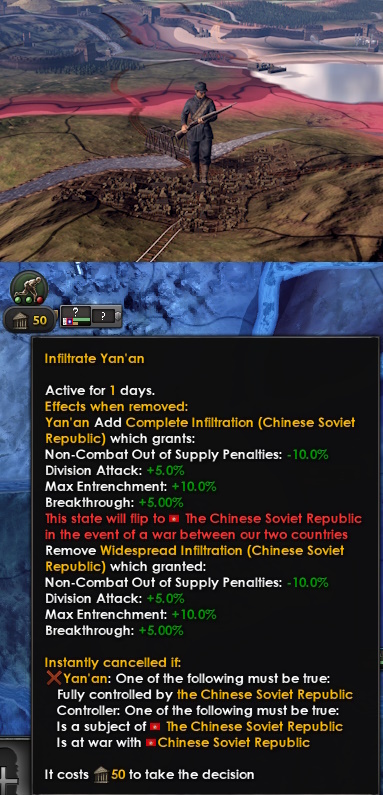 Beware, though, when you establish a Guerilla Cell, or launch a Sabotage Operation, or
Beware, though, when you establish a Guerilla Cell, or launch a Sabotage Operation, or 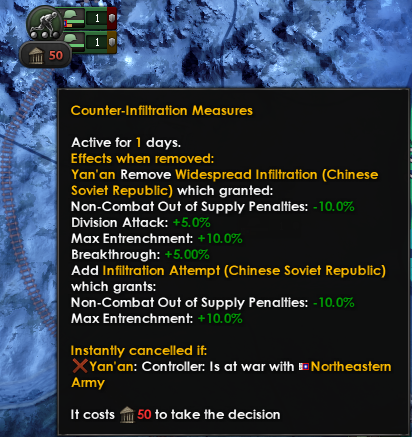 Remember how we talked about the limited production capabilities of the Communists during this time period? Well, there is another way to get weapons without producing them - they might even be more modern than the ones you’re able to produce yourself! That alternative way is called Raid Weapon Depots and is unlocked through the…. Raid Weapon Depots focus….
Remember how we talked about the limited production capabilities of the Communists during this time period? Well, there is another way to get weapons without producing them - they might even be more modern than the ones you’re able to produce yourself! That alternative way is called Raid Weapon Depots and is unlocked through the…. Raid Weapon Depots focus…. 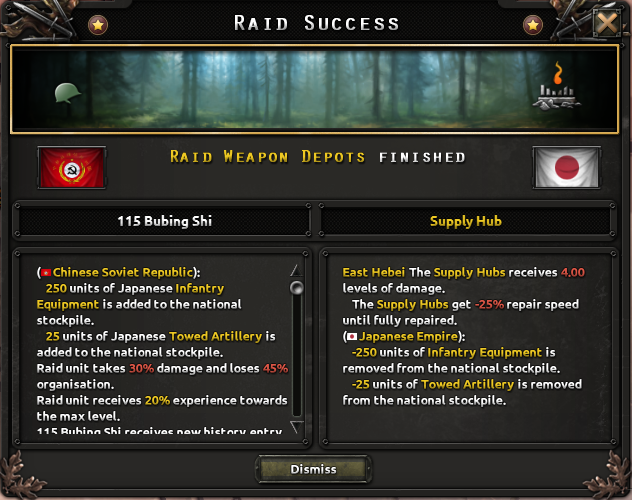 With the Yan’an Rectification Movement, you’ll cement Mao as the supreme leader of CCP, giving him a new leader trait depending on where you are on the Balance of Power.
With the Yan’an Rectification Movement, you’ll cement Mao as the supreme leader of CCP, giving him a new leader trait depending on where you are on the Balance of Power.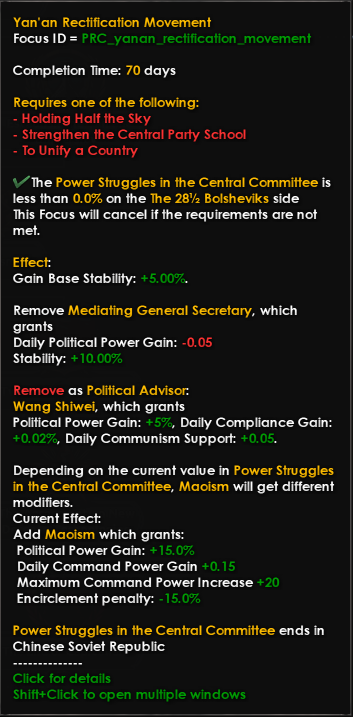 Having finally established Mao as the sole leader of Communist China, you can launch an offensive through the Hundred Regiments Offensive and Prepare for the Inevitable upcoming continuation of the Civil War against the Nationalists (if they still exists that is).
Having finally established Mao as the sole leader of Communist China, you can launch an offensive through the Hundred Regiments Offensive and Prepare for the Inevitable upcoming continuation of the Civil War against the Nationalists (if they still exists that is). 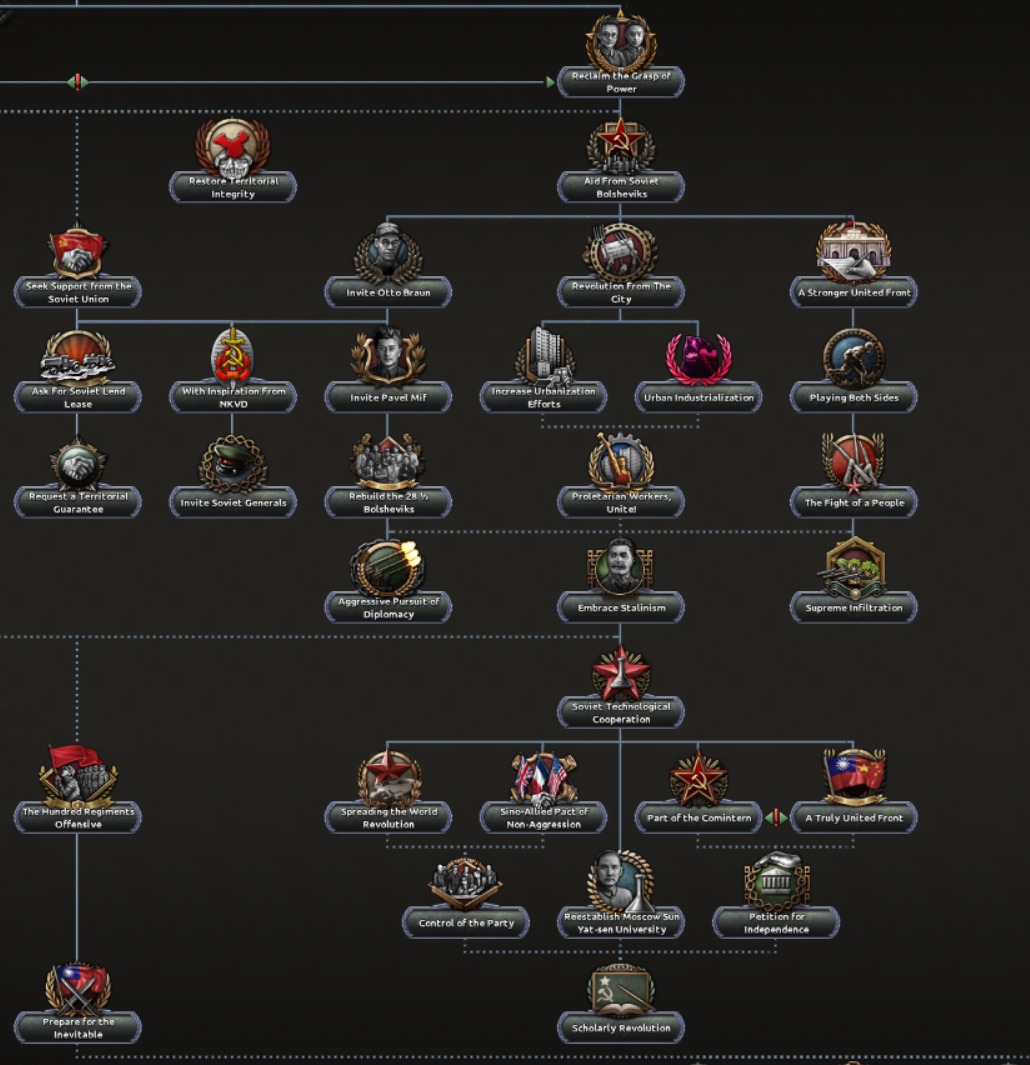 The focus paths for 28 ½ BolsheviksBoth Bo Gu and Wang Ming can return to lead the Party, should the faction gain enough influence to take control.
The focus paths for 28 ½ BolsheviksBoth Bo Gu and Wang Ming can return to lead the Party, should the faction gain enough influence to take control. 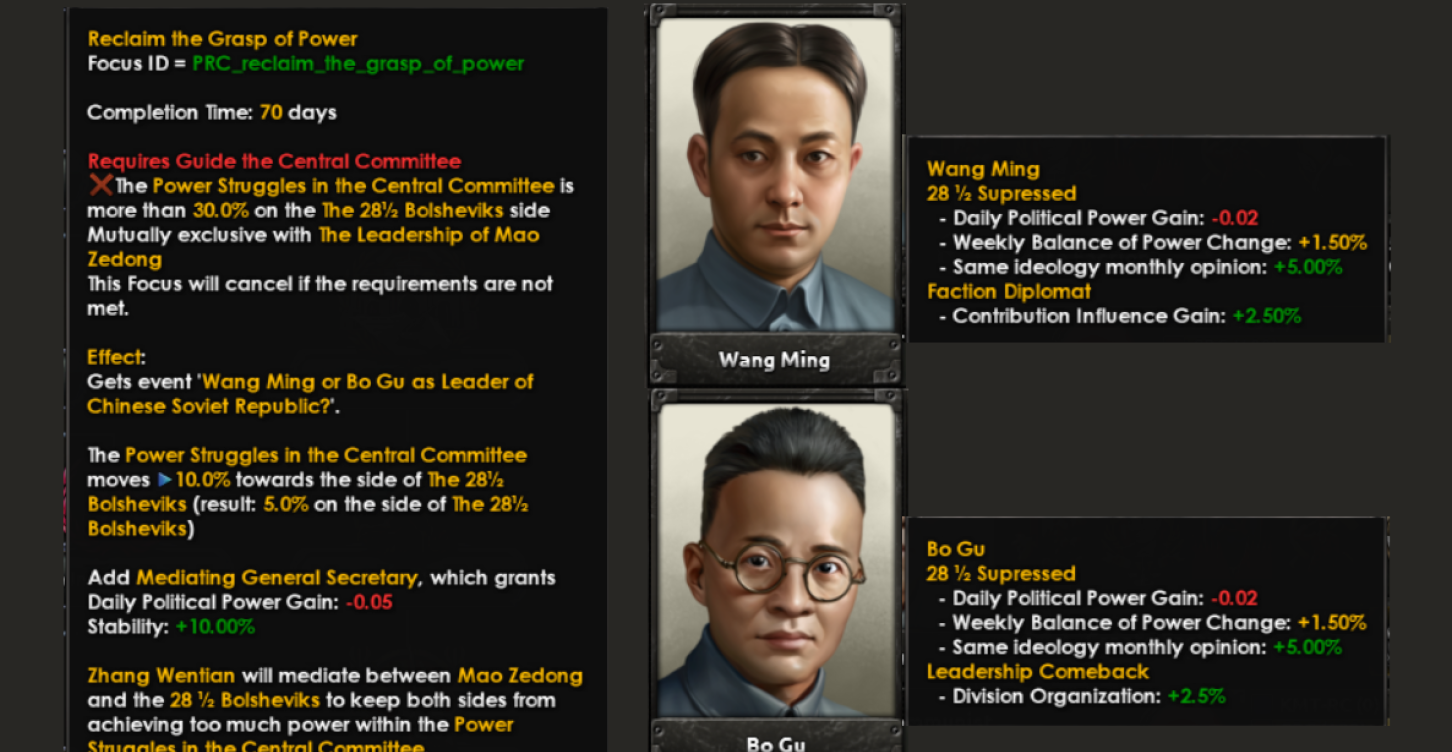 Bo Gu and Wang Ming
Bo Gu and Wang Ming 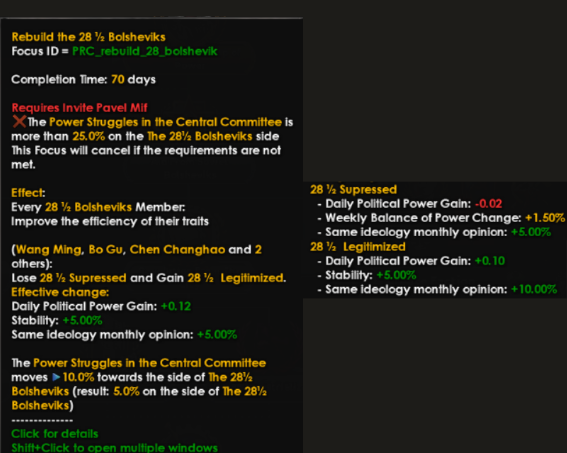 The player can take a focus to upgrade the trait for all leaders and advisors of the 28 ½ BolsheviksShould the Bolsheviks take power, it will come with a different perspective on Communism, a more urbanized and intellectual rather than the rural perceptive advanced by Mao. Additionally they will seek a closer co-operation with the Soviet Union, where the 28 Bolsheviks studied in the late 1920s and early 1930s.
The player can take a focus to upgrade the trait for all leaders and advisors of the 28 ½ BolsheviksShould the Bolsheviks take power, it will come with a different perspective on Communism, a more urbanized and intellectual rather than the rural perceptive advanced by Mao. Additionally they will seek a closer co-operation with the Soviet Union, where the 28 Bolsheviks studied in the late 1920s and early 1930s. 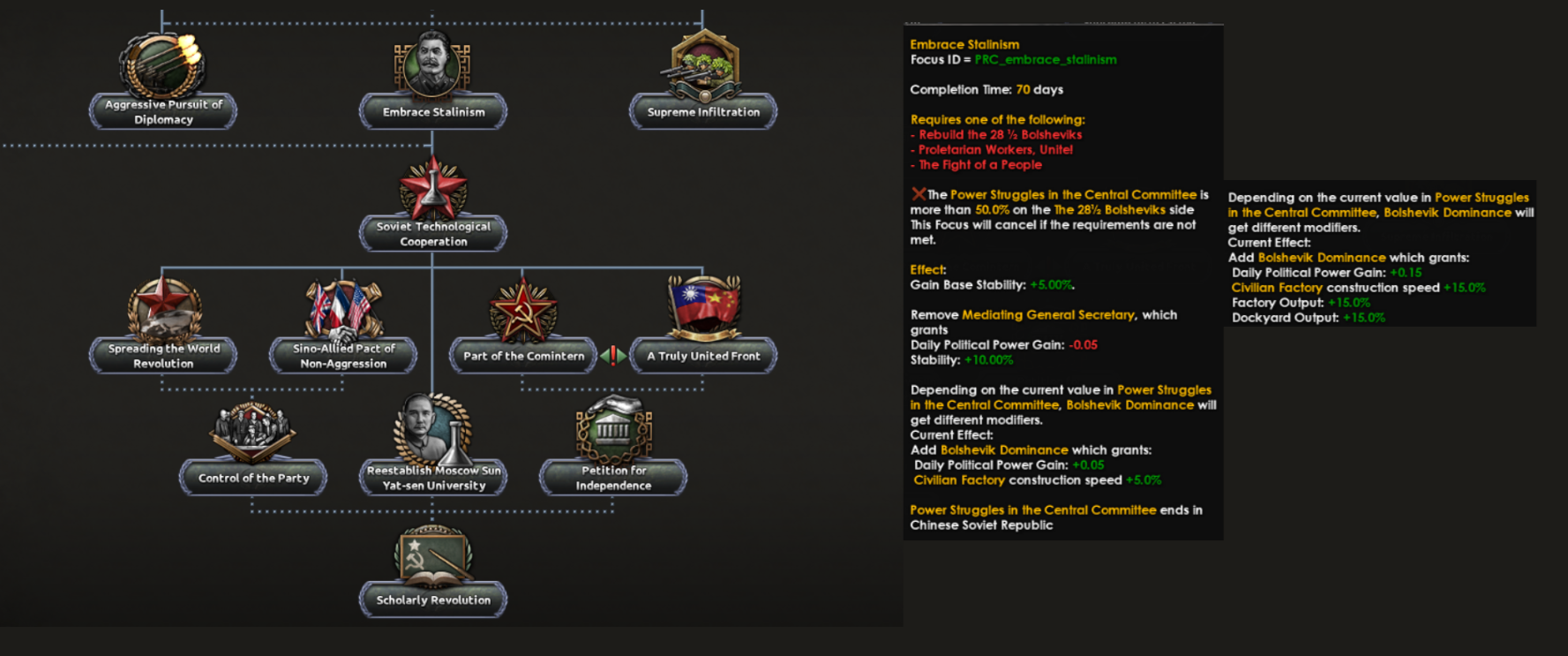 The strength of the modifier gained from Embrace Stalinism is based on the current Balance of Power valueThe 28½ Bolshevik will have access to a unique mechanic that relates to the new Faction feature.
The strength of the modifier gained from Embrace Stalinism is based on the current Balance of Power valueThe 28½ Bolshevik will have access to a unique mechanic that relates to the new Faction feature. 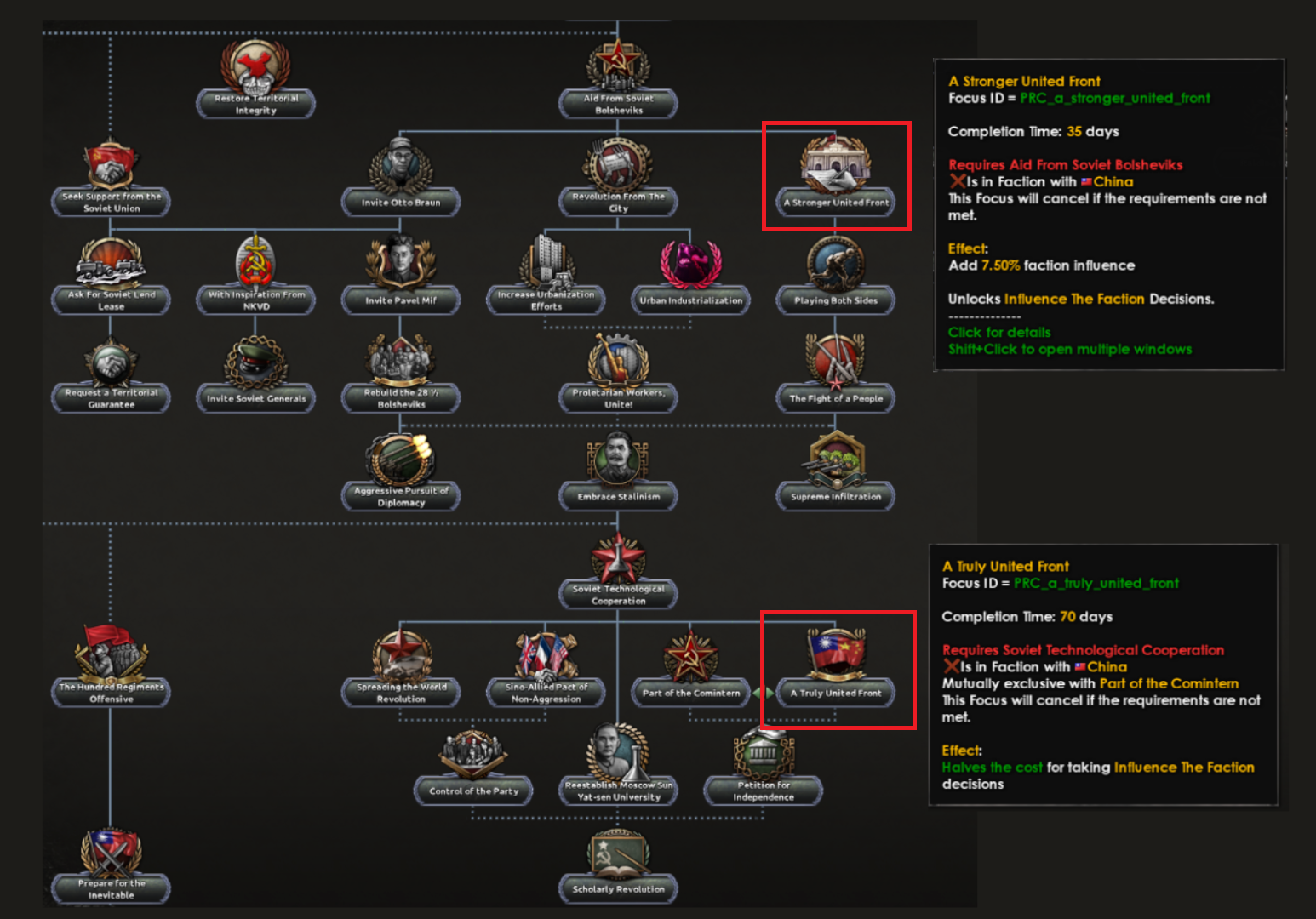 The Influence The Faction mechanic is a decision system where you can send Zhou Enlai on diplomatic missions to other faction members in the Second United Front to gain Faction Influence.
The Influence The Faction mechanic is a decision system where you can send Zhou Enlai on diplomatic missions to other faction members in the Second United Front to gain Faction Influence. 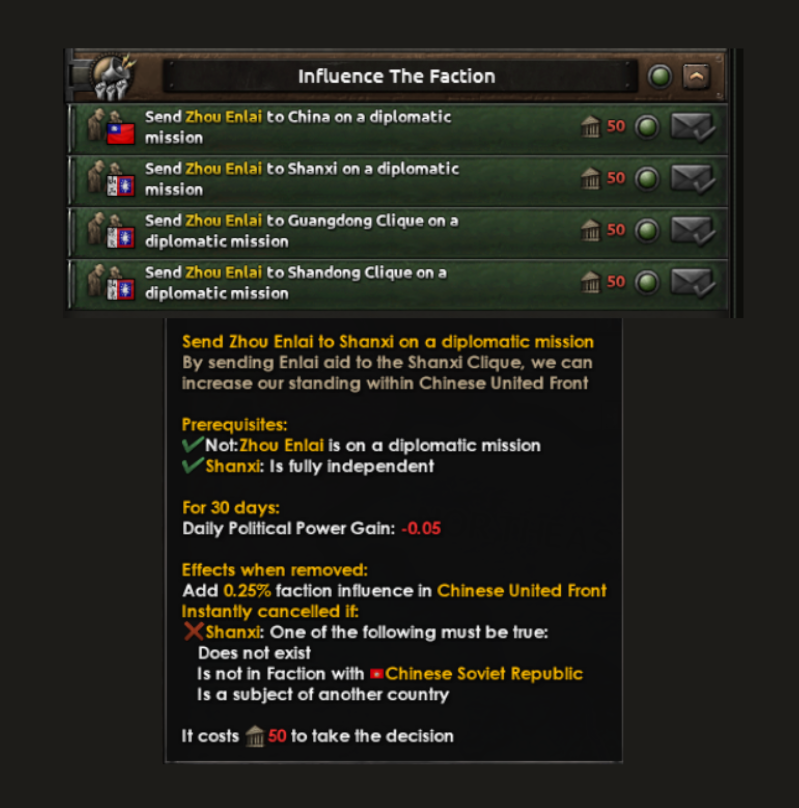 Tier one decisions
Tier one decisions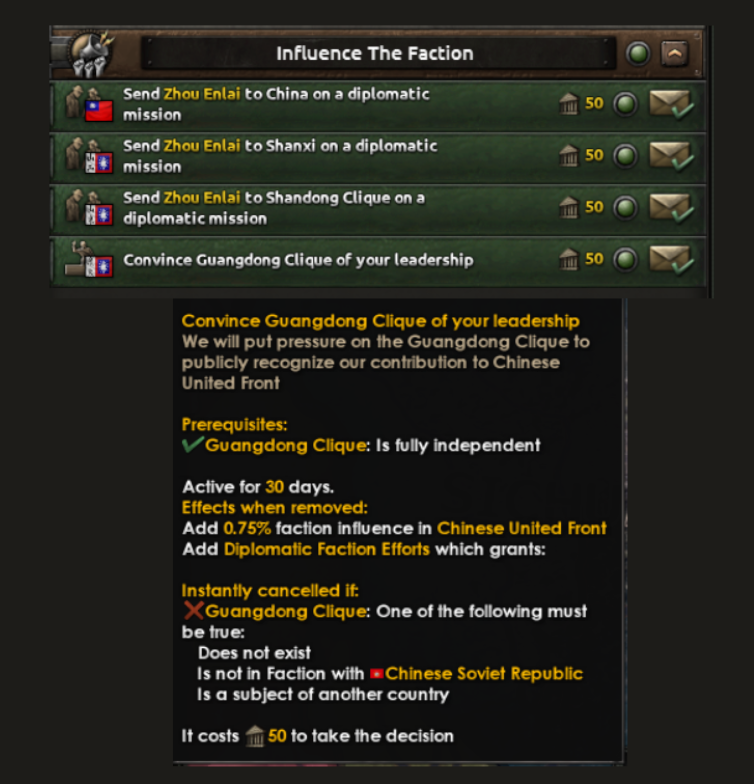 Tier two decisionYou will still have access to the Infiltration and Guerilla mechanics, but they will be much weaker. However, if you then further progress down the branch you will be able to halve the cost of these decisions.
Tier two decisionYou will still have access to the Infiltration and Guerilla mechanics, but they will be much weaker. However, if you then further progress down the branch you will be able to halve the cost of these decisions. 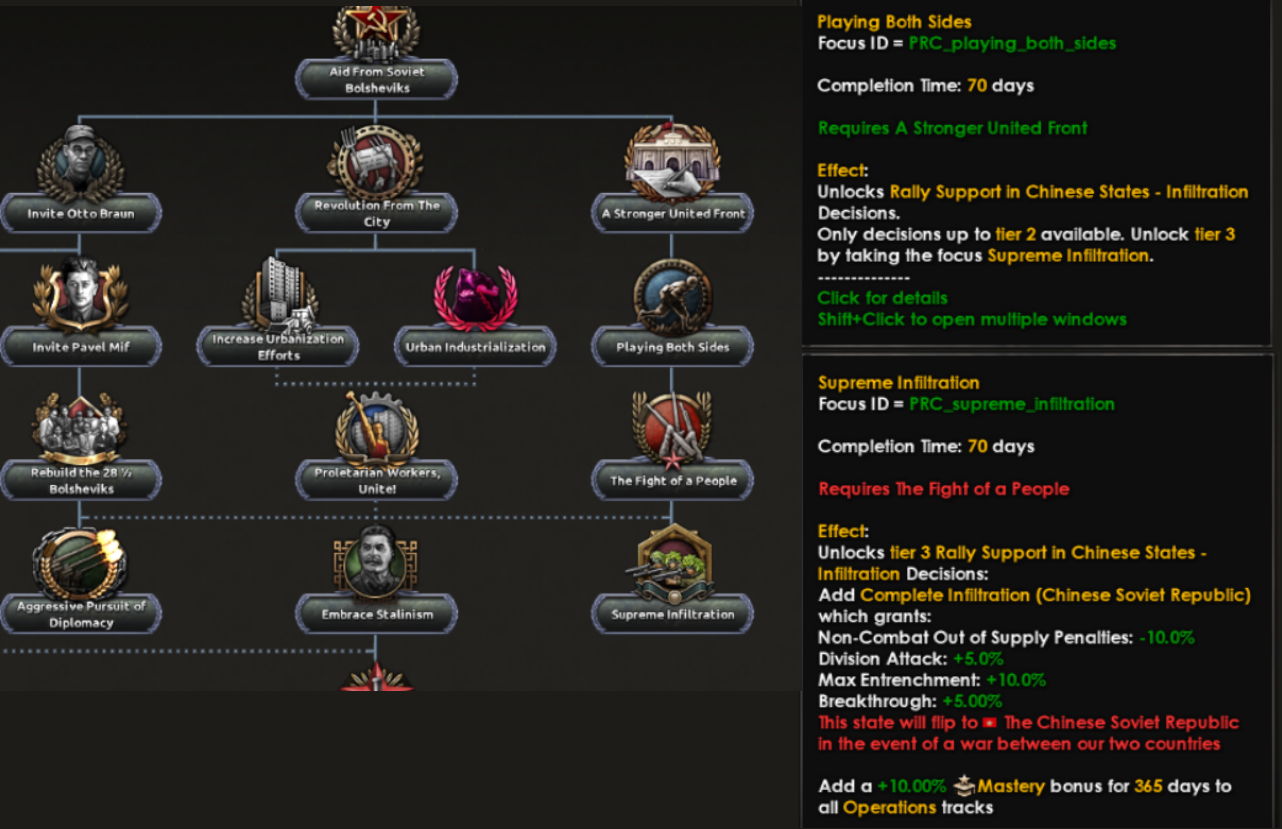 If you prefer diplomatic gameplay over infiltration, this path might be for you!
If you prefer diplomatic gameplay over infiltration, this path might be for you!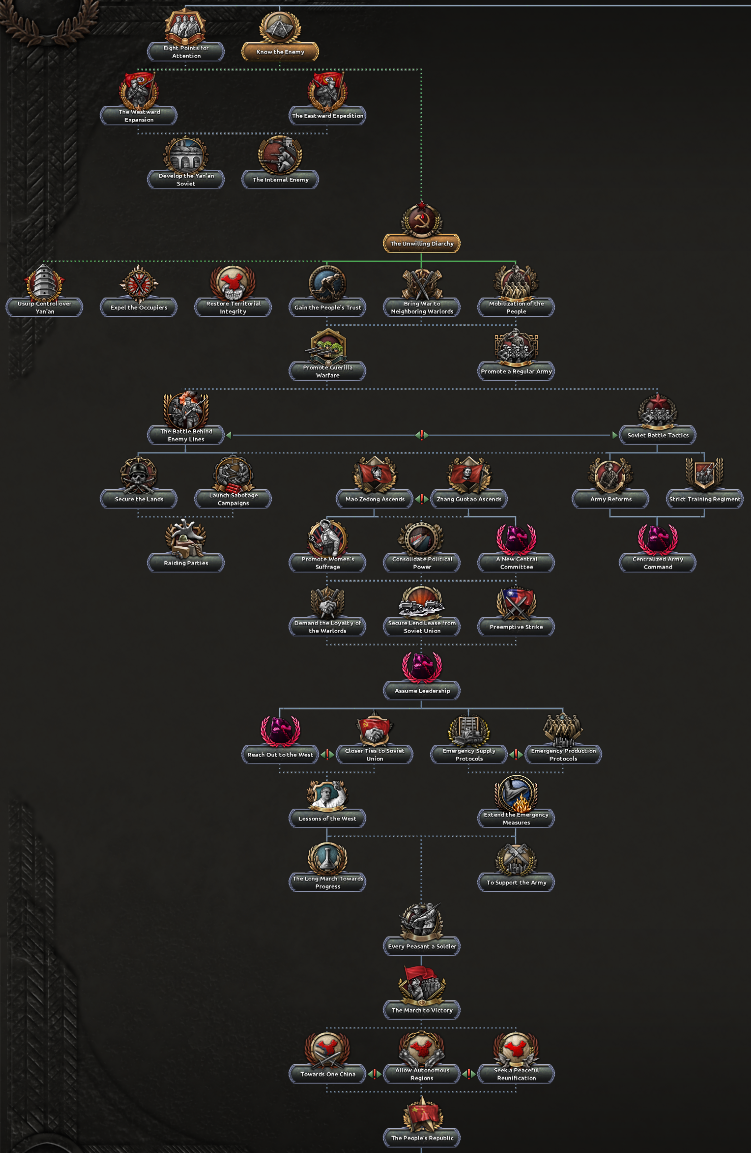 To go down this path, you’ll have to first wait for Zhang Guotao to arrive in the Chinese Soviet Republic, and only then can you form the Unwilling Diarchy between Guotao and Mao, sidelining the 28½ Bolsheviks in the Balance of Power.
To go down this path, you’ll have to first wait for Zhang Guotao to arrive in the Chinese Soviet Republic, and only then can you form the Unwilling Diarchy between Guotao and Mao, sidelining the 28½ Bolsheviks in the Balance of Power.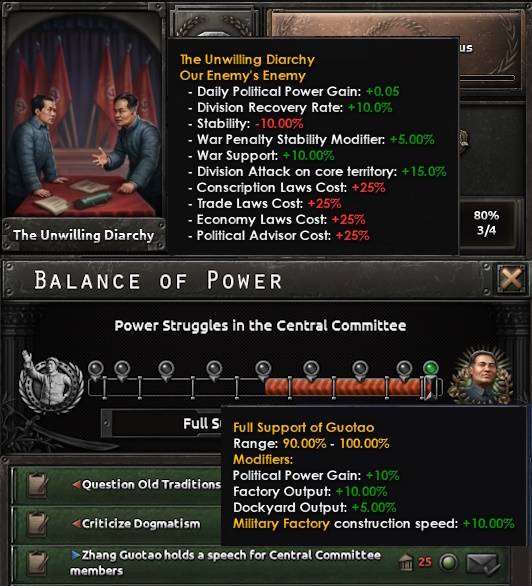 With Gain the People’s Trust you’ll unlock the Rally Support in Chinese States infiltration decisions already discussed, and with Mobilization of the People you get an additional 4 units of militias and more manpower overall. But to be able to withstand both the rest of China and Japan, you’ll have to fight smart and Promote Guerilla Warfare, but also build up and Promote a Regular Army before ultimately choosing which way you want to take your strategy; will you lean into guerilla warfare with raiding weapon depots to supplement your meager military production, or will you decide to mimic the Soviet Union and truly reform the army and build a more conventional army? No matter what you choose, you will be favoring Mao or Guotao over the other in their power struggle to achieve control over the Central Committee, and ultimately the country - but it will not necessarily determine who will come out on top, but it will make it easier for them. Having decided in which direction you want to take your armed forces and strategy of war, it’s time to finally decide who to ascend to leadership over the country! Will it be the sly Mao Zedong or the more direct Zhang Guotao?
With Gain the People’s Trust you’ll unlock the Rally Support in Chinese States infiltration decisions already discussed, and with Mobilization of the People you get an additional 4 units of militias and more manpower overall. But to be able to withstand both the rest of China and Japan, you’ll have to fight smart and Promote Guerilla Warfare, but also build up and Promote a Regular Army before ultimately choosing which way you want to take your strategy; will you lean into guerilla warfare with raiding weapon depots to supplement your meager military production, or will you decide to mimic the Soviet Union and truly reform the army and build a more conventional army? No matter what you choose, you will be favoring Mao or Guotao over the other in their power struggle to achieve control over the Central Committee, and ultimately the country - but it will not necessarily determine who will come out on top, but it will make it easier for them. Having decided in which direction you want to take your armed forces and strategy of war, it’s time to finally decide who to ascend to leadership over the country! Will it be the sly Mao Zedong or the more direct Zhang Guotao?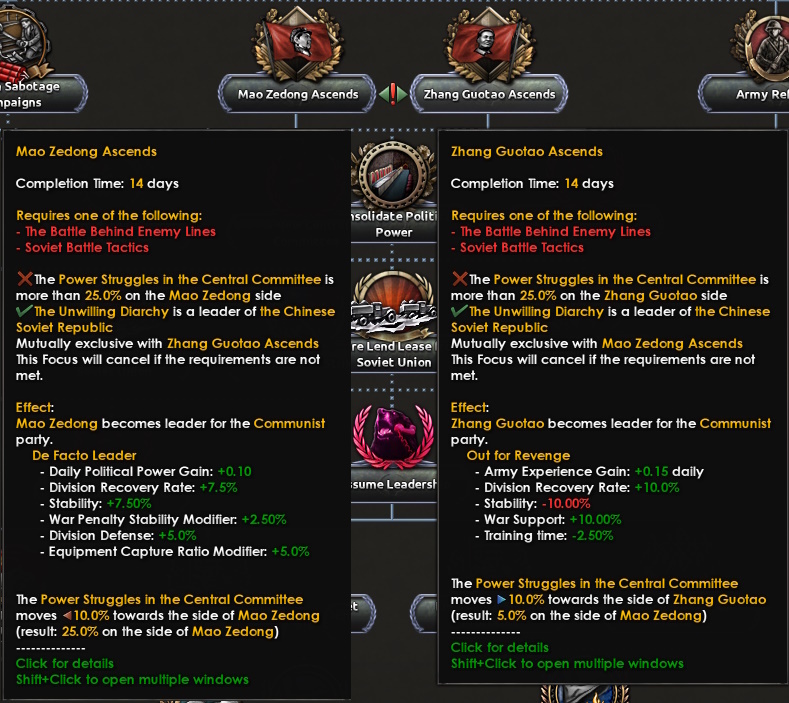 Having decided on what direction you want to take your country, you can finally focus on your external enemies; you can coerce and Demand the Loyalty of the Warlords, creating your very own faction, or you could go for the Preemptive Strike and stab the Nationalists in the back when they have their hands full of Japan. You could also bolster your limited production capabilities if you Secure Lend Lease from Soviet Union.
Having decided on what direction you want to take your country, you can finally focus on your external enemies; you can coerce and Demand the Loyalty of the Warlords, creating your very own faction, or you could go for the Preemptive Strike and stab the Nationalists in the back when they have their hands full of Japan. You could also bolster your limited production capabilities if you Secure Lend Lease from Soviet Union.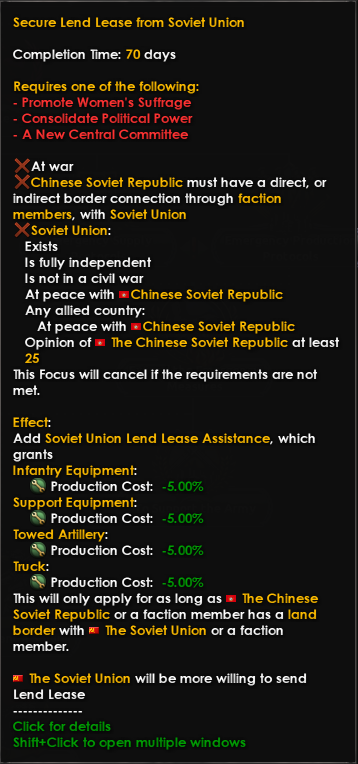 Having settled the internal power struggle and secured your position (either with a faction, lend-lease, or striking against the Nationalists), you can either Reach Out to the West or get Closer Ties to the Soviet Union - both with their own set of bonuses.
Having settled the internal power struggle and secured your position (either with a faction, lend-lease, or striking against the Nationalists), you can either Reach Out to the West or get Closer Ties to the Soviet Union - both with their own set of bonuses.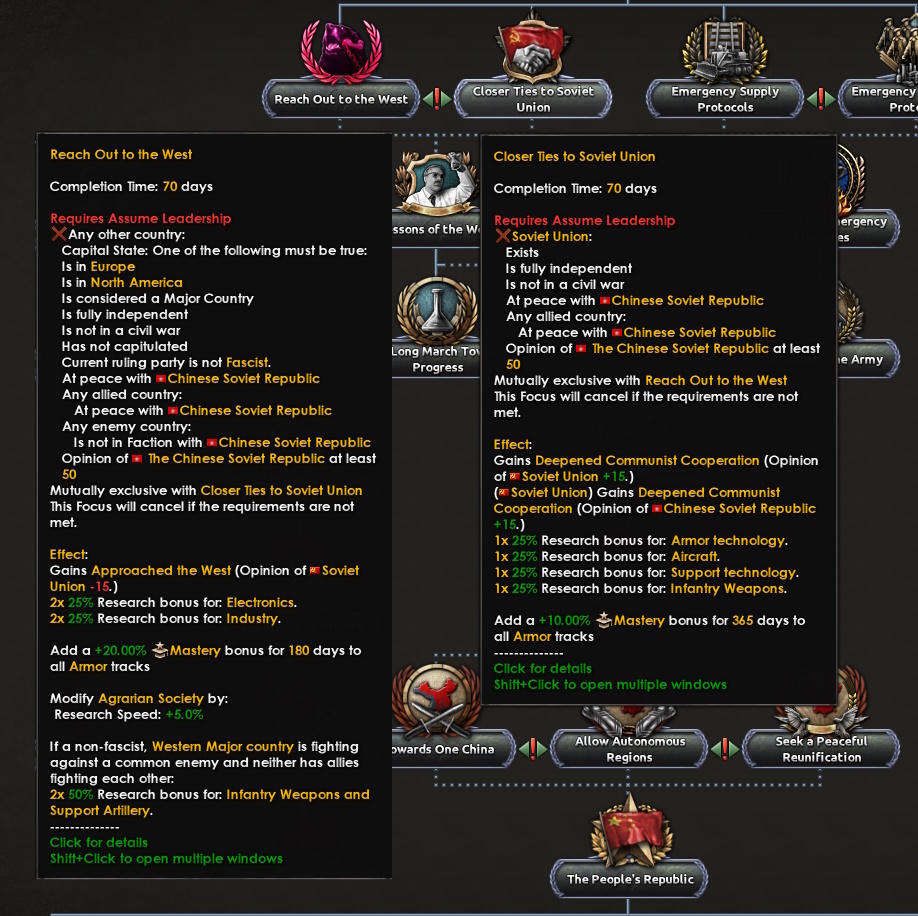 To help you in your war efforts, you can institute emergency protocols to either bolster your supply efforts or production efforts. You’ll be able to prolong these efforts and eventually make them permanent.
To help you in your war efforts, you can institute emergency protocols to either bolster your supply efforts or production efforts. You’ll be able to prolong these efforts and eventually make them permanent.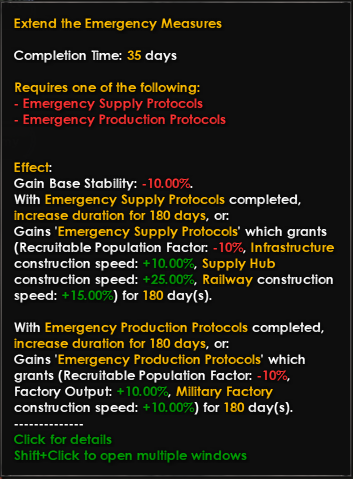 With that out of the way, the Unwilling Diarchy branch is almost done, and only two more focuses are necessary to progress further down the tree - namely Every Peasant a Soldier and The March to Victory.
With that out of the way, the Unwilling Diarchy branch is almost done, and only two more focuses are necessary to progress further down the tree - namely Every Peasant a Soldier and The March to Victory.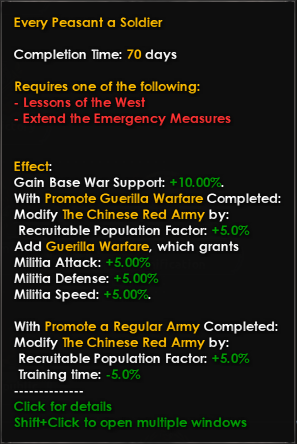
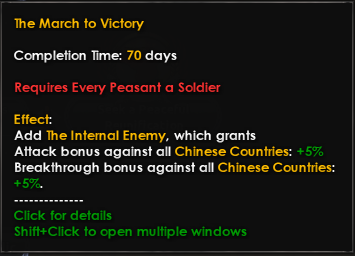 What happens now, then? What happens once you’re ready to truly take to the offensive and become the sole hegemon over China?
What happens now, then? What happens once you’re ready to truly take to the offensive and become the sole hegemon over China?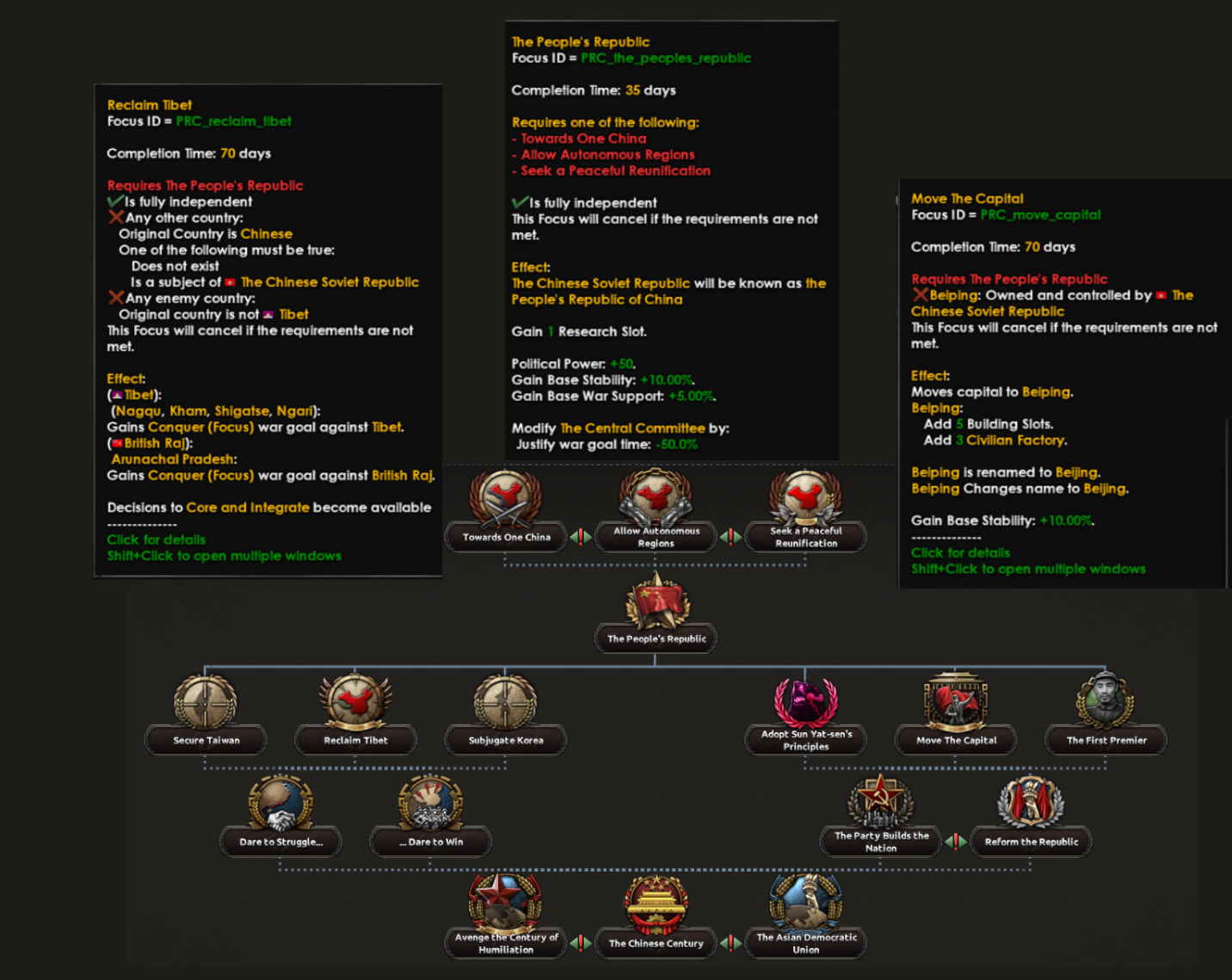 End game political branchThe player will be able to take focuses that unlock coring and integration efforts, retake old territories, as well as focuses aimed at providing content for a post-proclaimed PRC, such as improving Zhou Enlai’s trait to First Premier and moving the capital to Beijing.
End game political branchThe player will be able to take focuses that unlock coring and integration efforts, retake old territories, as well as focuses aimed at providing content for a post-proclaimed PRC, such as improving Zhou Enlai’s trait to First Premier and moving the capital to Beijing.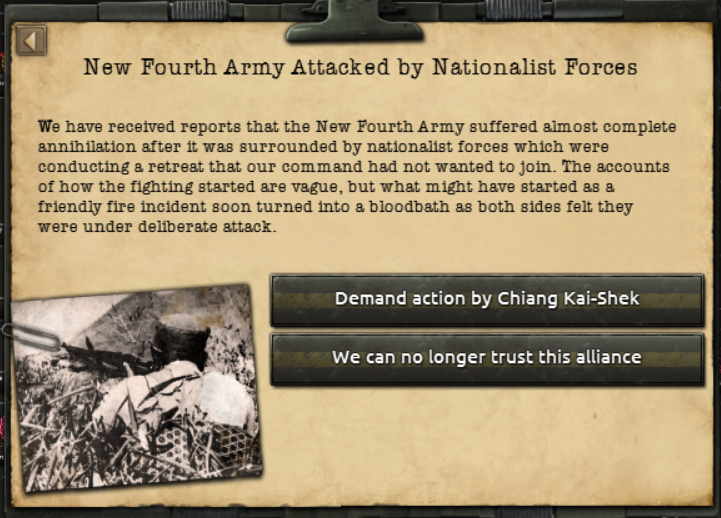









 Что делать если вас отправили в лагерь?!? ( Гайд для хойщиков )
Что делать если вас отправили в лагерь?!? ( Гайд для хойщиков ) 



 Hearts of Islam (Islamic Ruleset for HOI4)
Hearts of Islam (Islamic Ruleset for HOI4) 



 Мета на Германию (ванила)
Мета на Германию (ванила)  Новый Рим в OWB
Новый Рим в OWB  Гайд на Советский Союз
Гайд на Советский Союз 


 Loading
Loading
